Forums
- Forums
- Duggy's Reference Hangar
- USAAF / USN Library
- Northrop A-17
Northrop A-17
Post a reply
- Go to Previous topic
- Go to Next topic
- Go to Welcome
- Go to Introduce Yourself
- Go to General Discussion
- Go to Screenshots, Images and Videos
- Go to Off topic
- Go to Works in Progress
- Go to Skinning Tips / Tutorials
- Go to Skin Requests
- Go to IJAAF Library
- Go to Luftwaffe Library
- Go to RAF Library
- Go to USAAF / USN Library
- Go to Misc Library
- Go to The Ops Room
- Go to Made in Germany
- Go to Campaigns and Missions
- Go to Works in Progress
- Go to Juri's Air-Raid Shelter
- Go to Campaigns and Missions
- Go to Works in Progress
- Go to Skinpacks
- Go to External Projects Discussion
- Go to Books & Resources
-
9 years agoSat May 25 2024, 10:09amDuggy
 Main AdminThe Northrop A-17 series of single-engined attack bombers were the backbone of the USAAC's attack aircraft strength during the late 1930s. The A-17 was well-armed, had a good performance, was reliable and dependable, and was widely exported. Although a fairly advanced design when it first appeared, the A-17 was rapidly eclipsed by advancing technology and soon became obsolescent. Even before American entry into the Second World War, the A-17 had been taken out of front-line service with the USAAC and largely relegated to training roles. It saw no combat in American colors, but its export versions did see some action.
Main AdminThe Northrop A-17 series of single-engined attack bombers were the backbone of the USAAC's attack aircraft strength during the late 1930s. The A-17 was well-armed, had a good performance, was reliable and dependable, and was widely exported. Although a fairly advanced design when it first appeared, the A-17 was rapidly eclipsed by advancing technology and soon became obsolescent. Even before American entry into the Second World War, the A-17 had been taken out of front-line service with the USAAC and largely relegated to training roles. It saw no combat in American colors, but its export versions did see some action.
The direct ancestor of the A-17 series was the Northrop Gamma 2F. The Gamma 2F (c/n 44) was a private venture prototype for a two-seat attack bomber. It was a development of the Gamma 2C two-seat attack bomber prototype, but differed from the Gamma 2C in having a 750 hp Pratt & Whitney R-1535-11 Twin Wasp Junior fourteen cylinder radial driving a three-bladed propeller. This engine had a smaller diameter than either the R-1830-7 or 9 of the XA-16, which made the forward view much better. In addition, the Gamma 2F had a smaller and longer fully-glazed canopy, with the radio operator/gunner being moved further aft. The fuselage was more streamlined and the tail surfaces were revised. The main undercarriage was partially retractable, with the main members retracting rearwards into large, bulky underwing fairings.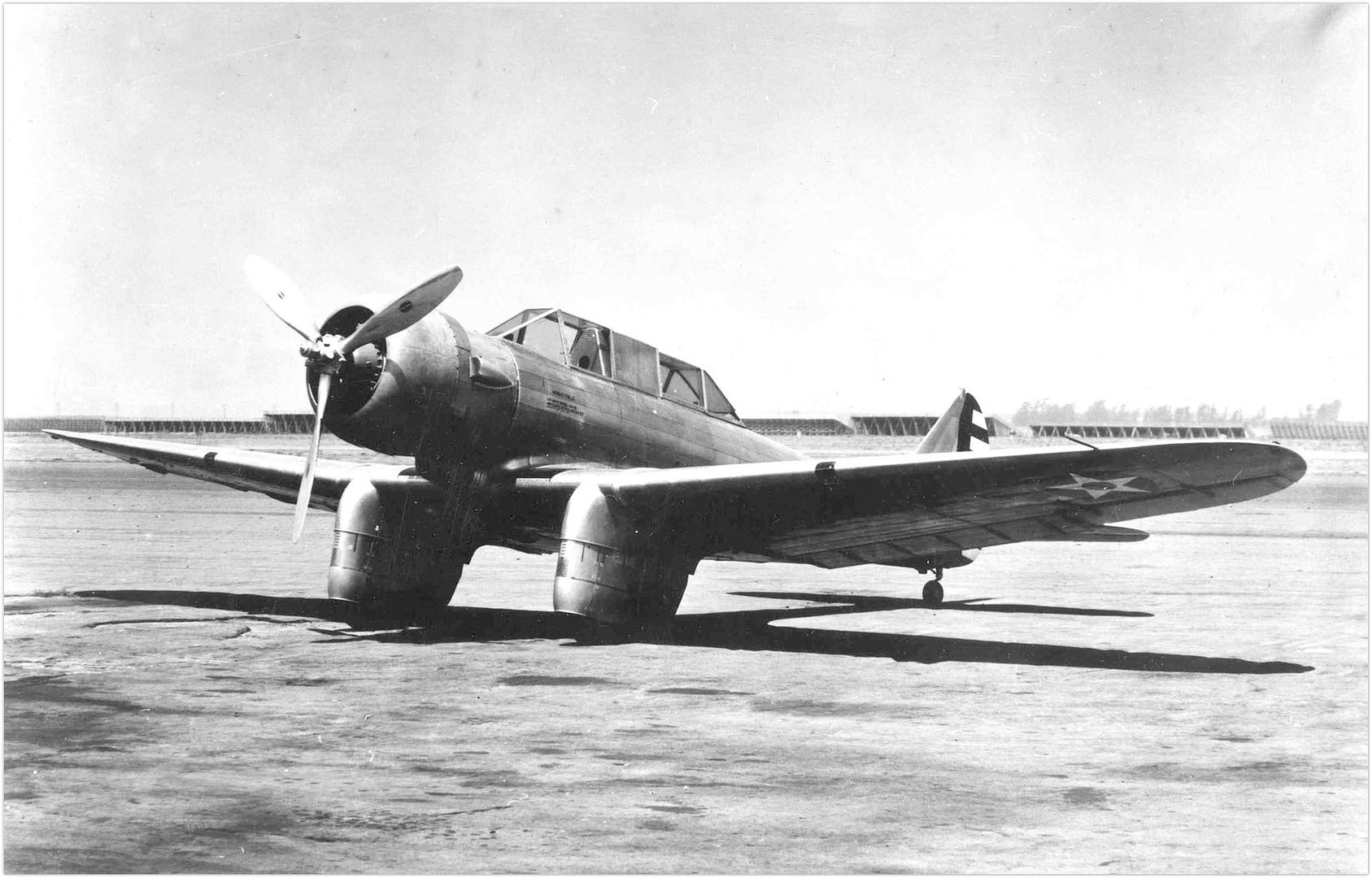
The Gamma 2F was delivered to the Army for evaluation on October 6, 1934. The results of the evaluation were generally favorable, but the Army wanted additional streamlining. The aircraft was returned to Northrop for modifications. Since the semi-retractable undercarriage Had resulted in only a slight improvement in performance, it was replaced by a fixed undercarriage, with struts and open-sided wheel fairings. In addition, the cowling, fuselage lines, and tail shape were all refined to obtain better aerodynamic streamlining. The shape of the cockpit canopy was extensively revised, and an unglazed section was added between the sliding canopies that covered the pilot's and gunner's cockpits.
On December 24, 1934, the Army announced their intention to purchase 110 production examples of the Gamma 2F under the designation A-17. Although the A-17 was well armed and had a good performance, perhaps its most salient selling point was its low cost--under $19,000 apiece, minus government-furnished equipment. This made it especially attractive in an America struggling with the Great Depression. The contract was officially signed on March 1, 1935. This was the largest prewar Army attack contract, and was a bonanza for the new Northrop branch.
It had been hoped that the larger GR-1820 Cyclone or the R-1830-7 Wasp could be installed in the production A-17, so the YA-13 prototype was returned to Northrop for fitting with this engine. However, the YA-13 was significantly overpowered with the R-1830-7, and to prevent disruption of production, it was decided that the production A-17 would retain the smaller R-1535.
In modified form, the Gamma 2F aircraft was delivered to the Army Air Corps on July 27, 1935 as the first A-17 (serial number 35-51). 109 production A-17s (35-52/160) were delivered between December 1935 and January 1937. They were powered by the 750 hp R-1535-11 and were armed with four wing-mounted and one flexible 0.30-inch machine gun. They differed from the prototype in being fitted with three-segment perforated air brakes which extended between the ailerons.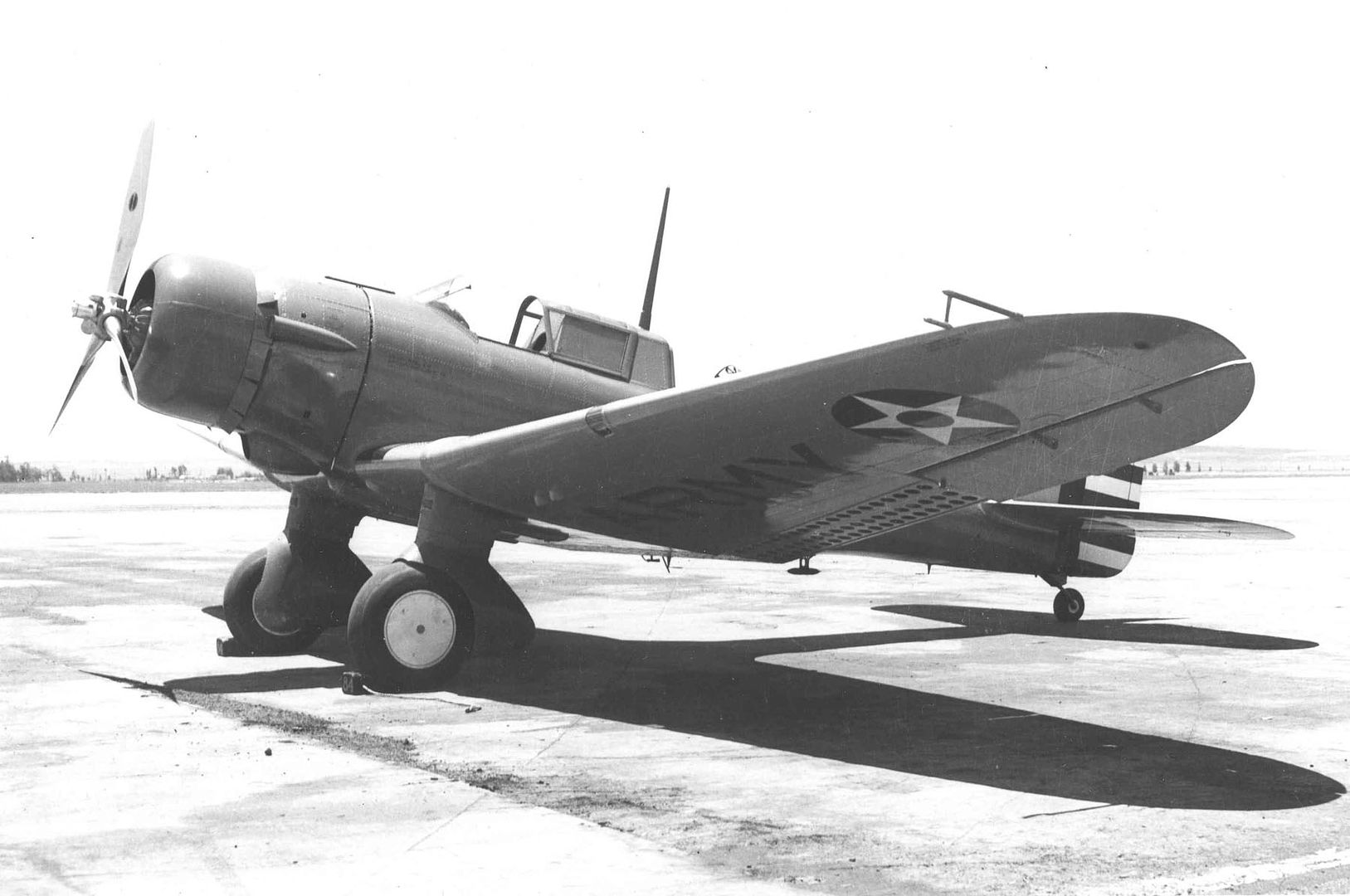
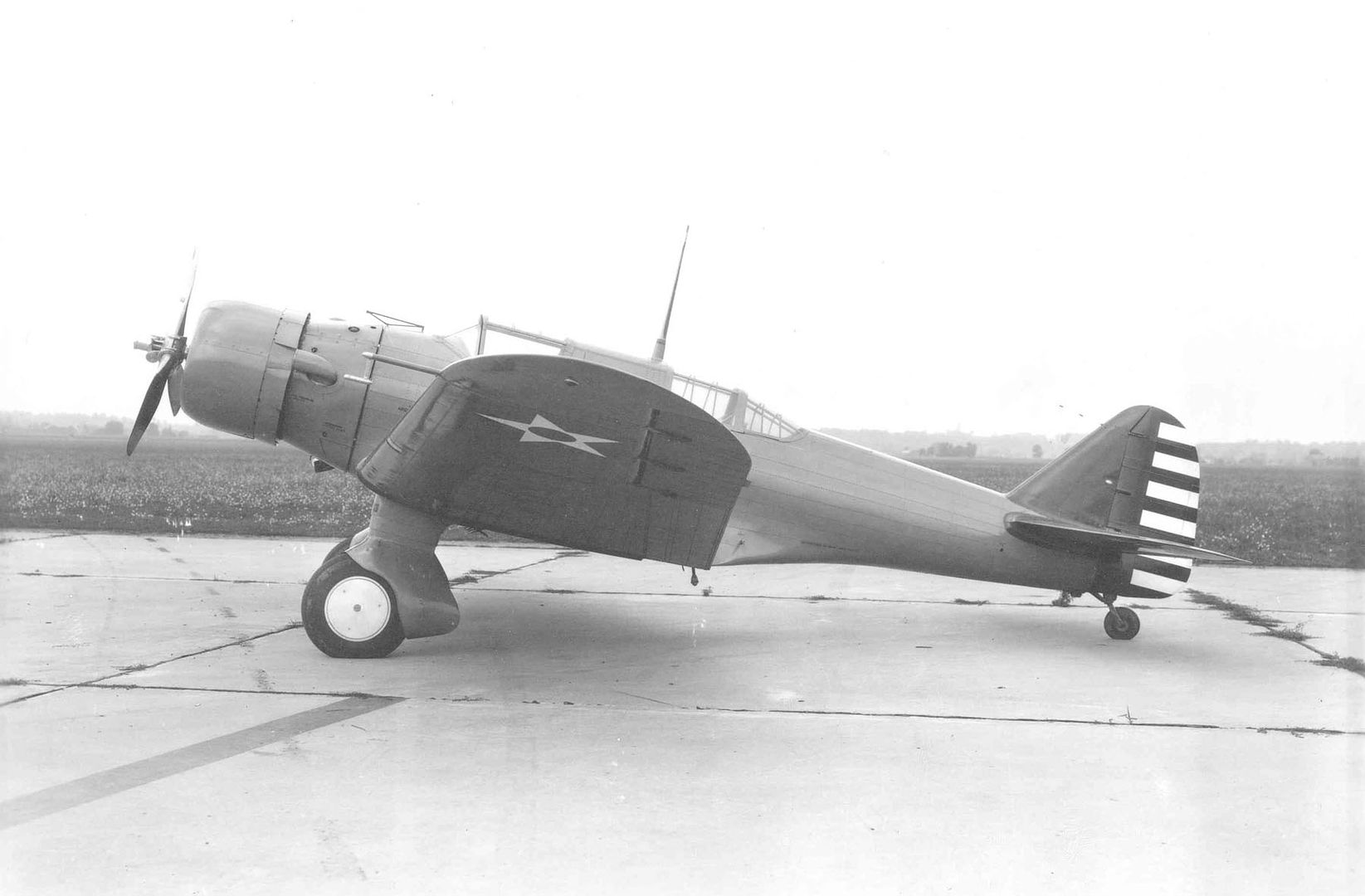
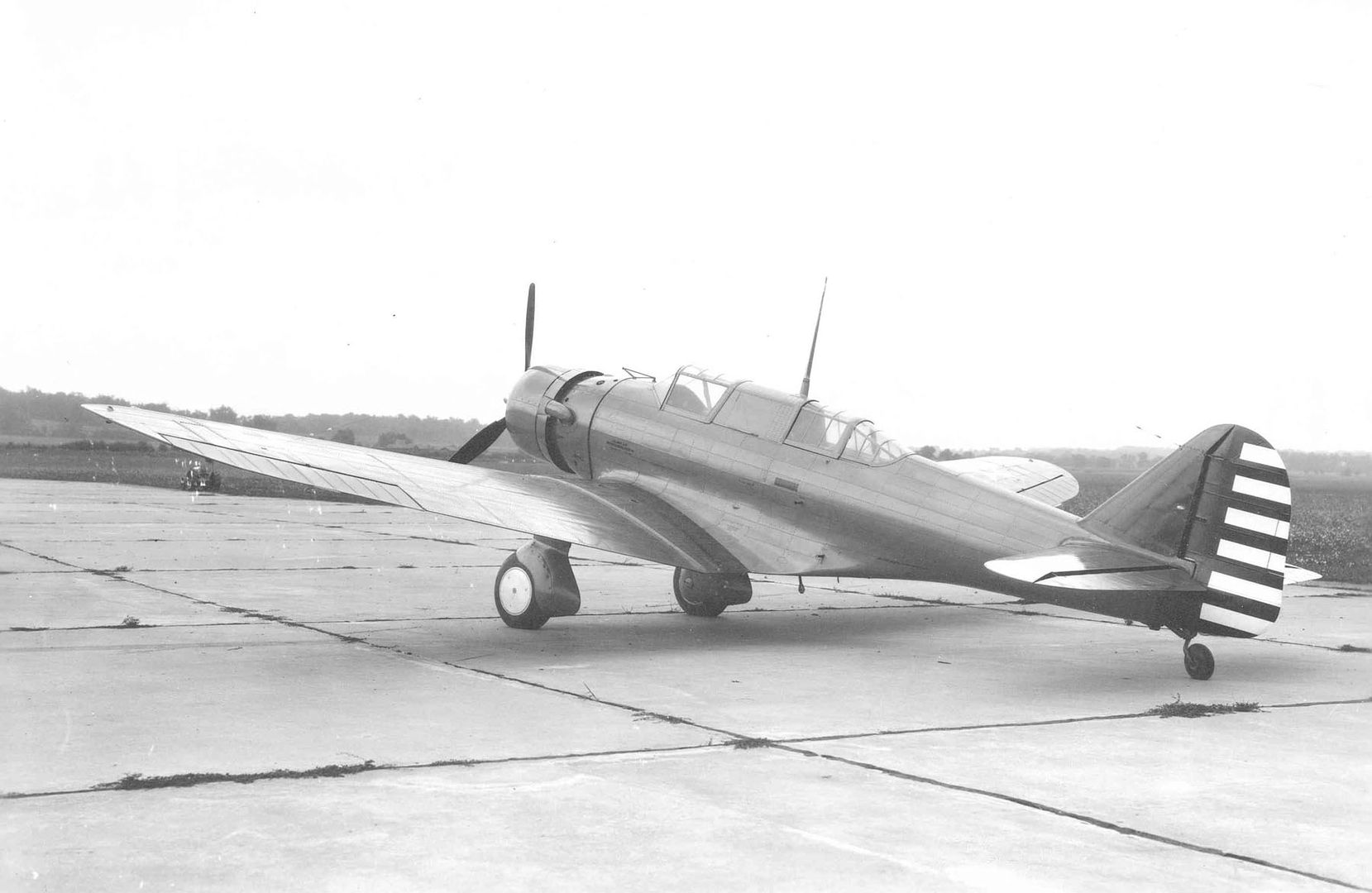
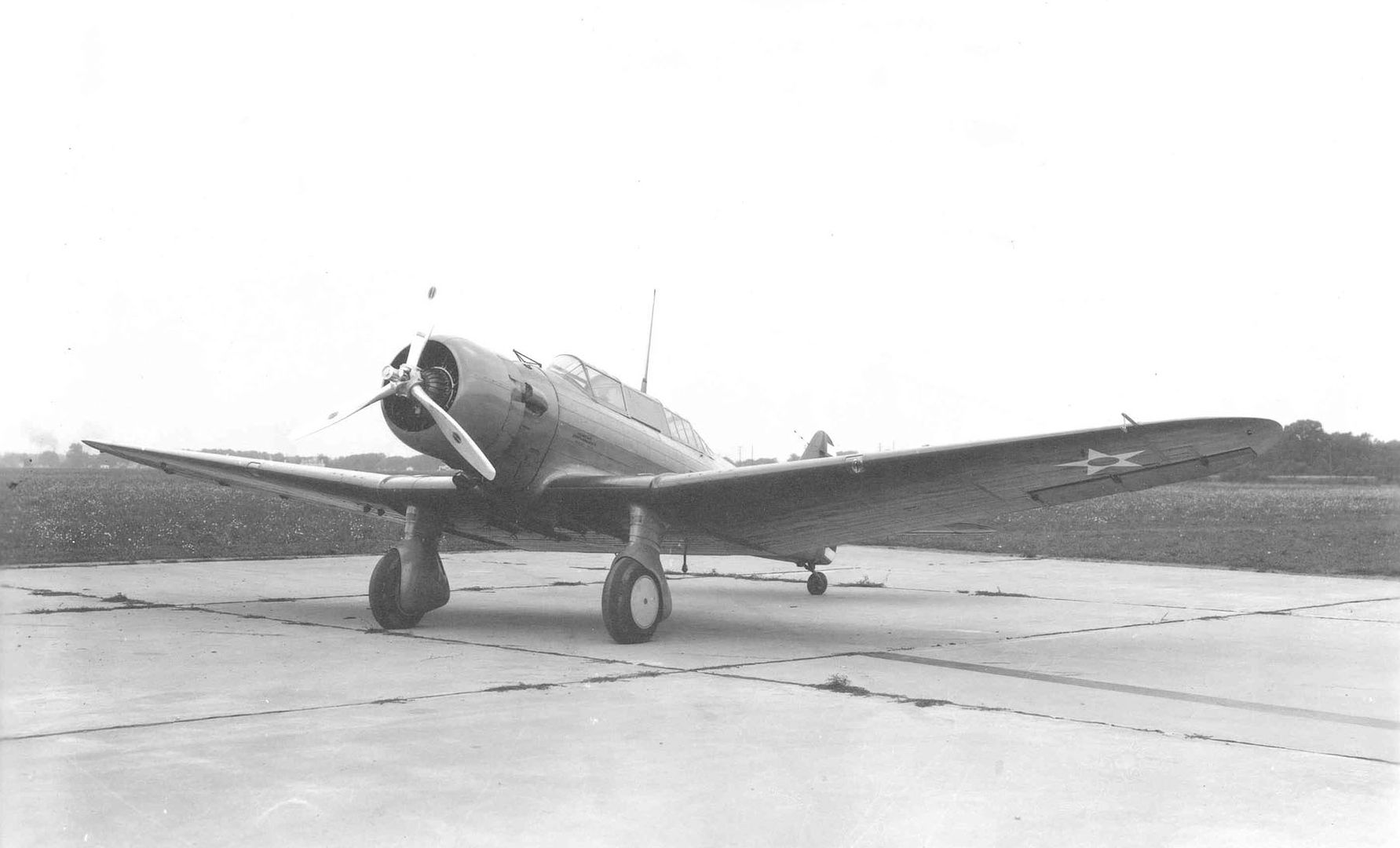
The first true production A-17 (35-52) was sent to Wright Field in December of 1935. The A-17s were initially evaluated at Wright Field and by the Technical Training Command at Chanute Field, Illinois. Beginning in February of 1936, A-17s were delivered to the 3rd Attack Group (8th, 13th and 90th Squadrons) based at Barksdale Field, Louisiana. They were also supplied to the 17th Attack Group (34th, 37th, and 95th Squadrons) based at March Field, California, which had recently converted from P-26A pursuits.
The A-17s were powered by the 750hp Pratt & Whitney R-1535-11 radial. They Were armed with four 0.30-inch machine guns in the wings and a single 0.30-inch gun on a flexible mount in the rear fuselage. The ventral firing system tested out on the prototype was deleted on production examples. Up to 20 30-lb bombs could be carried in small bomb bays in the fuselage.
Within a year, the A-17s were supplemented in these two groups by faster retractable-undercarriage A-17As. Shortly thereafter, the A-17s were transferred to training and auxiliary units. By the time of Pearl Harbor, the A-17 was thoroughly obsolete, and the surviving examples were being used only as advanced trainers or as squadron hacks. Most of them ended their lives at mechanics' schools during the early war war years.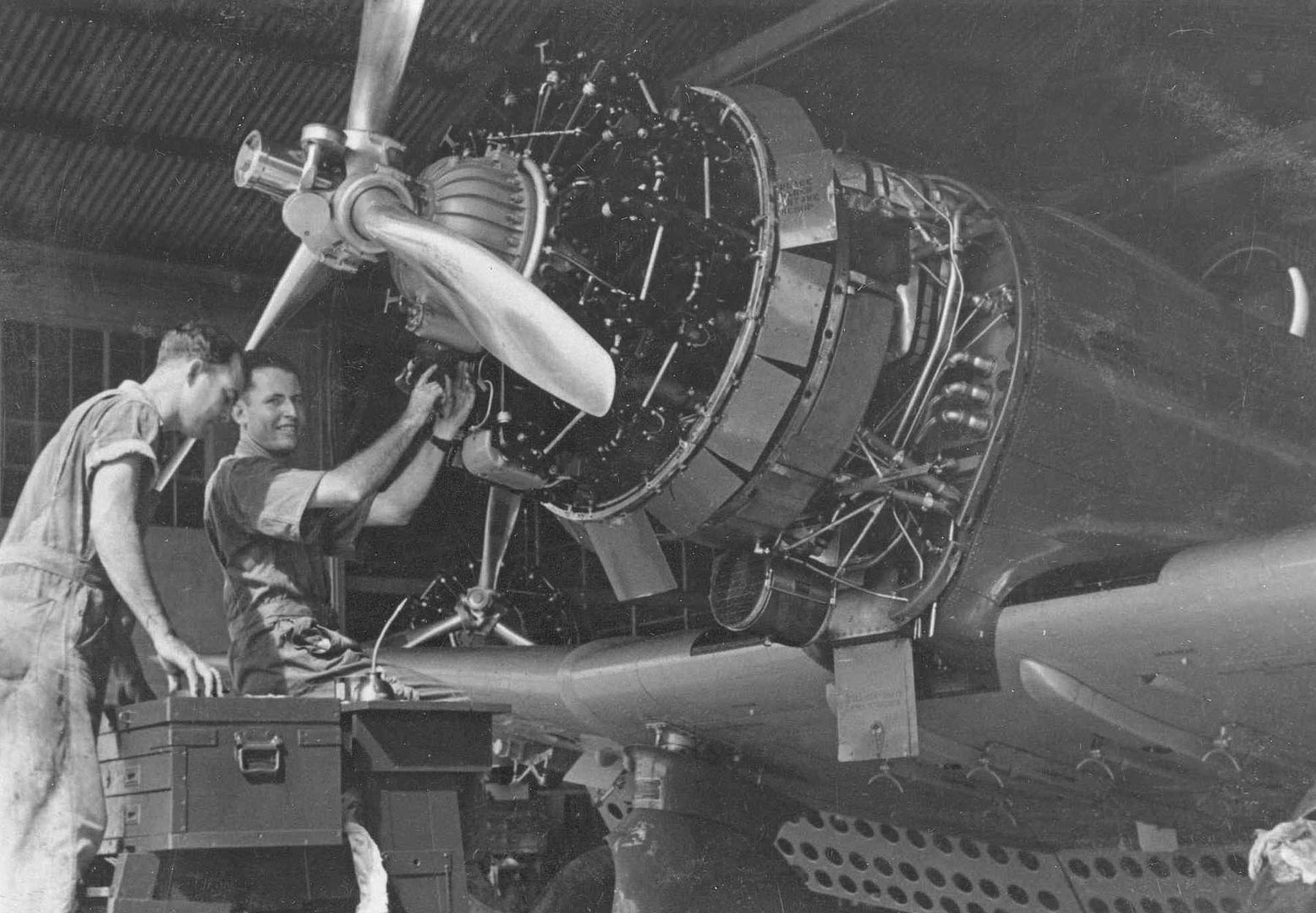
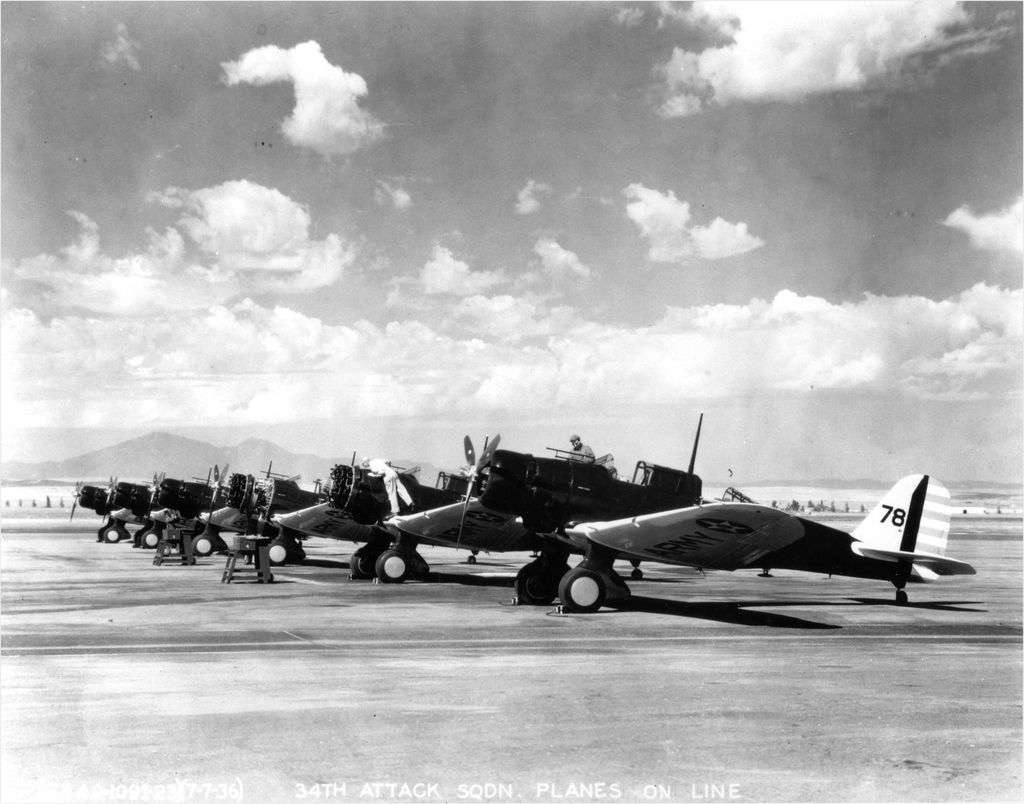
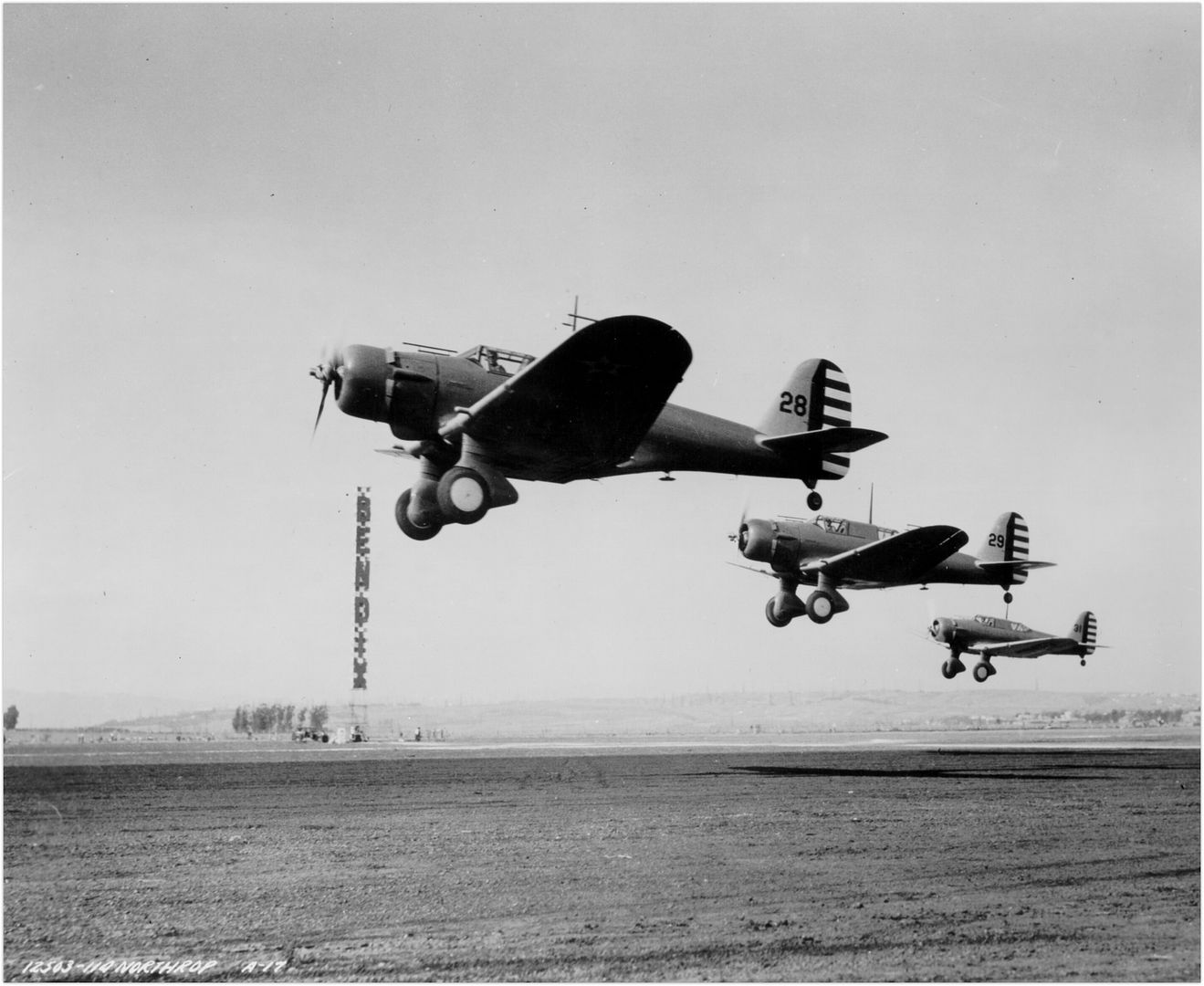
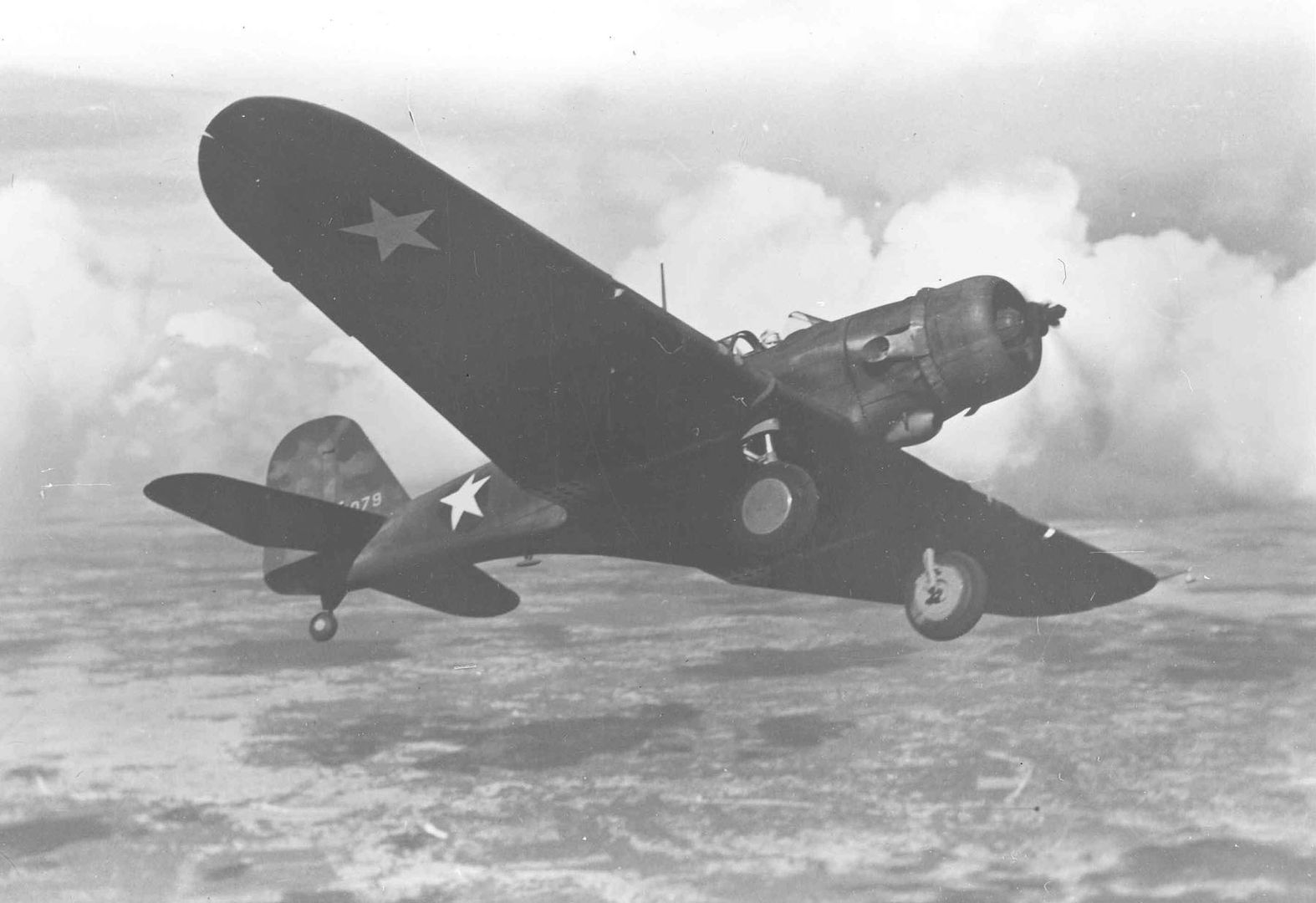
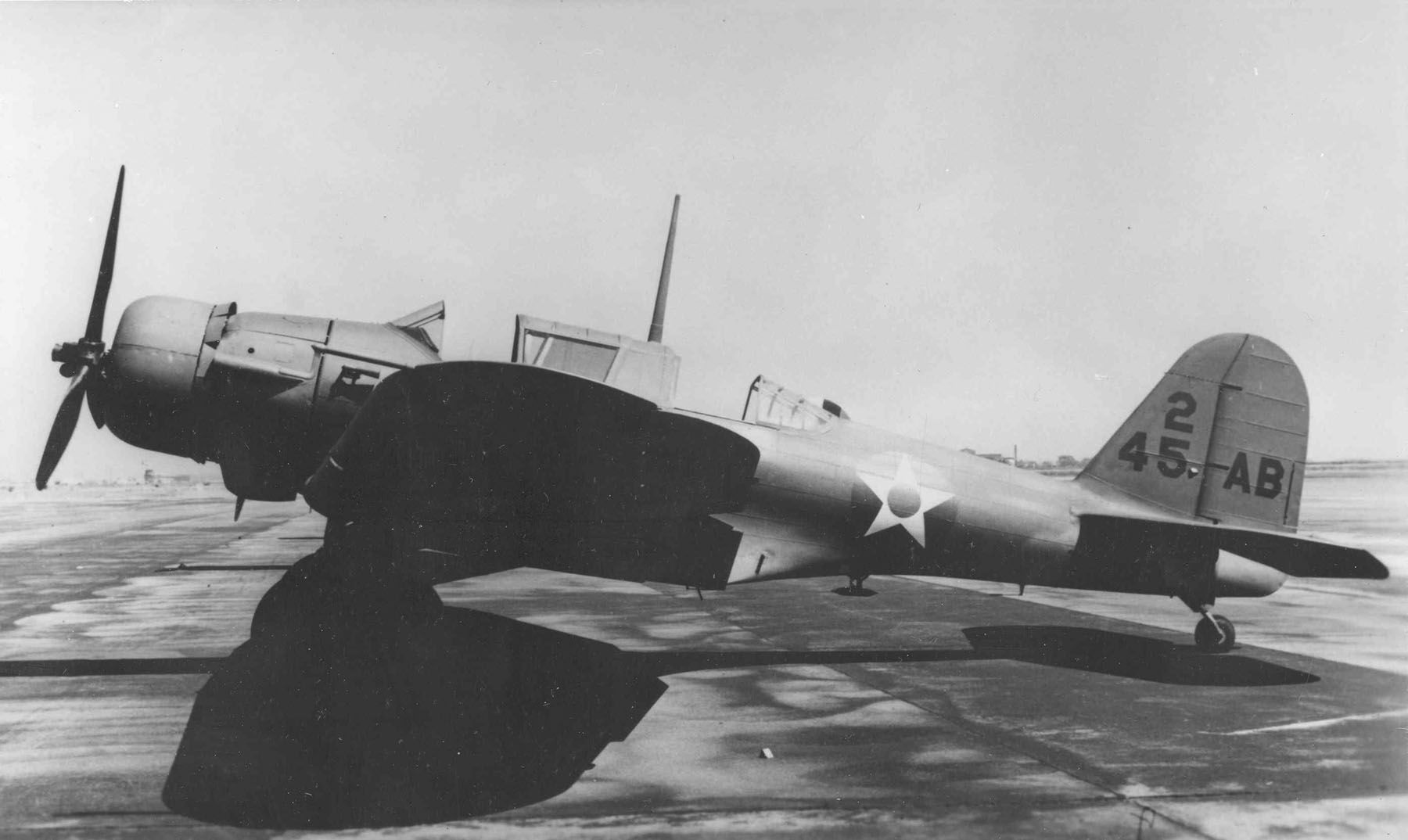
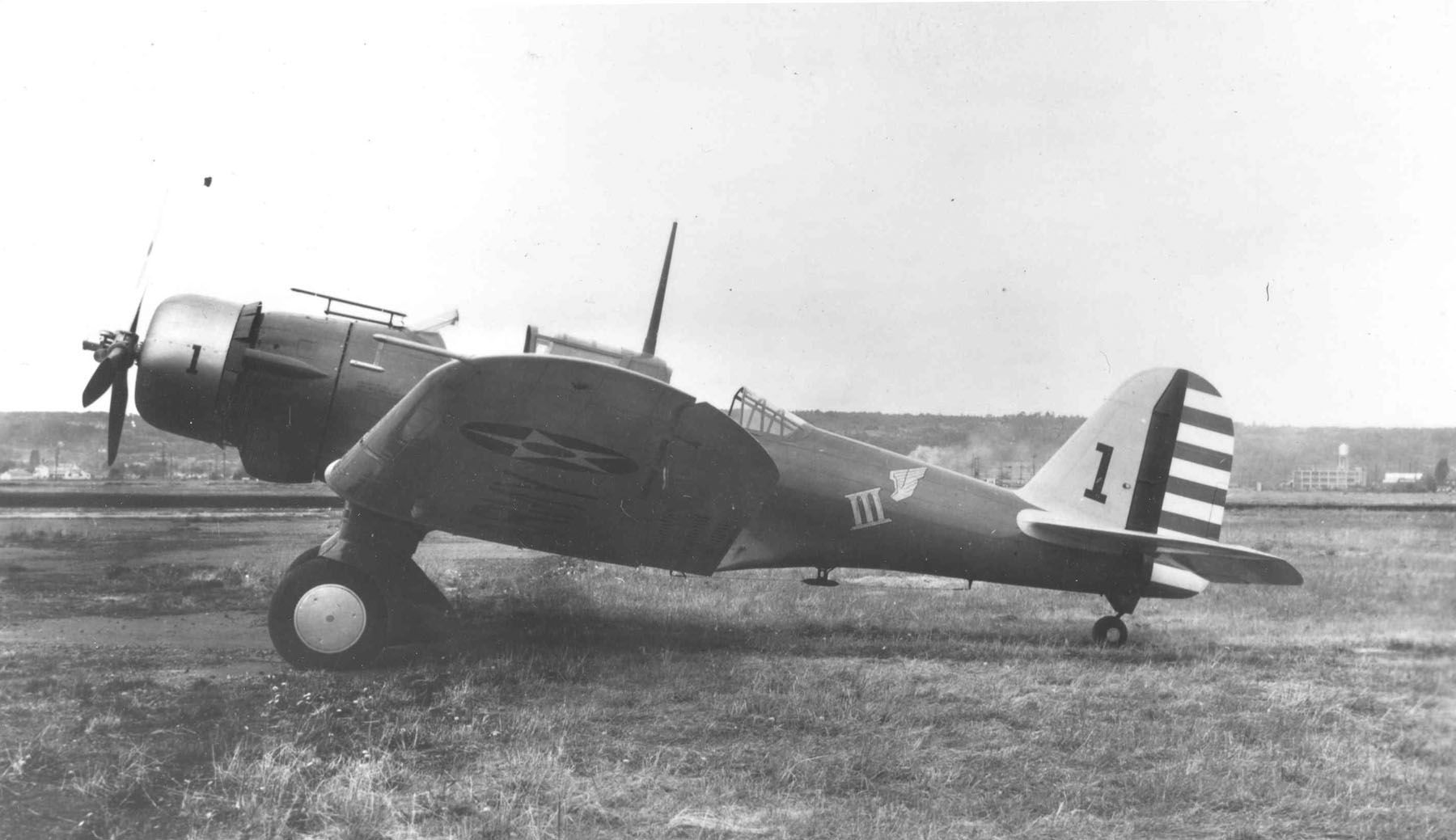
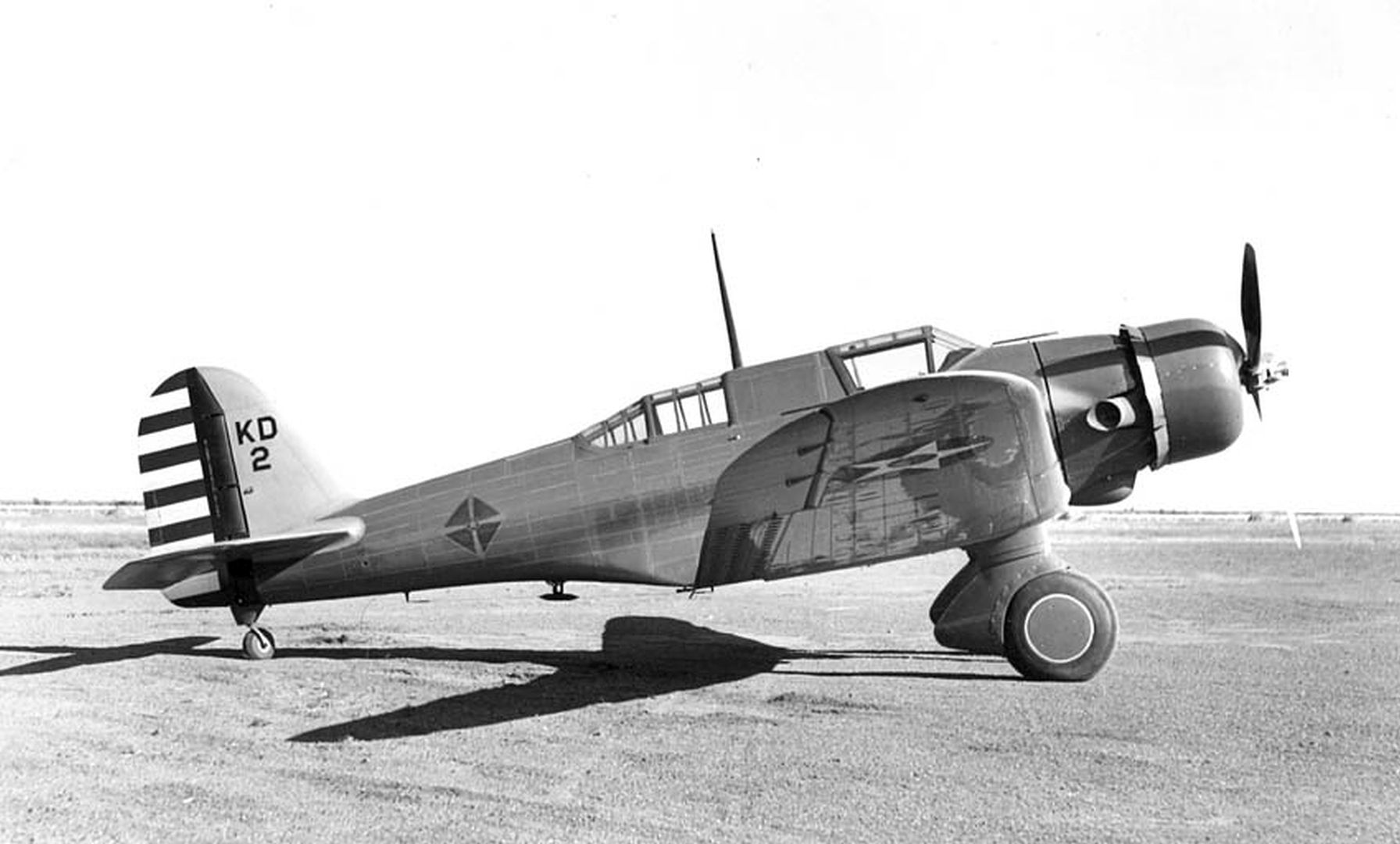
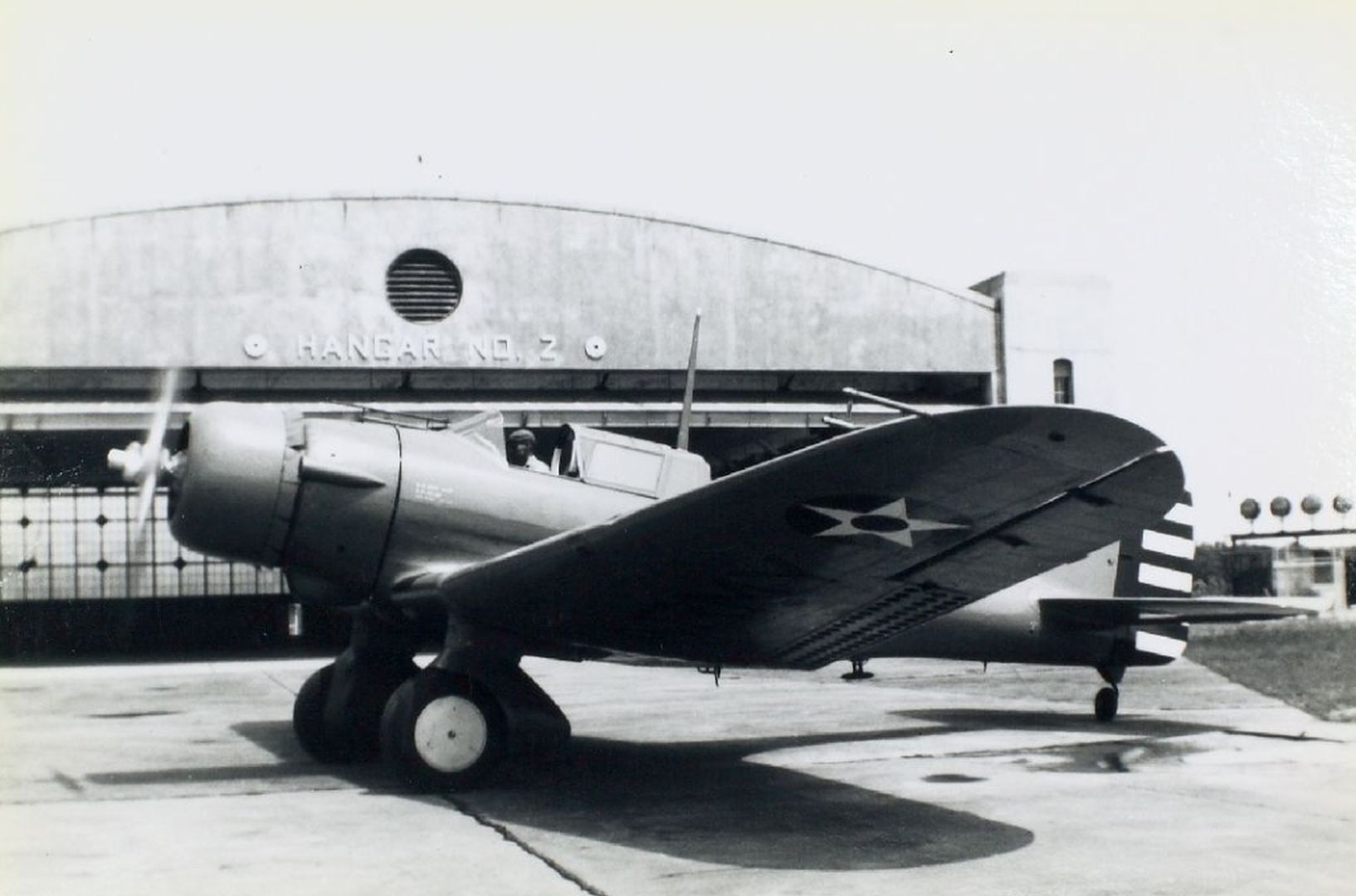
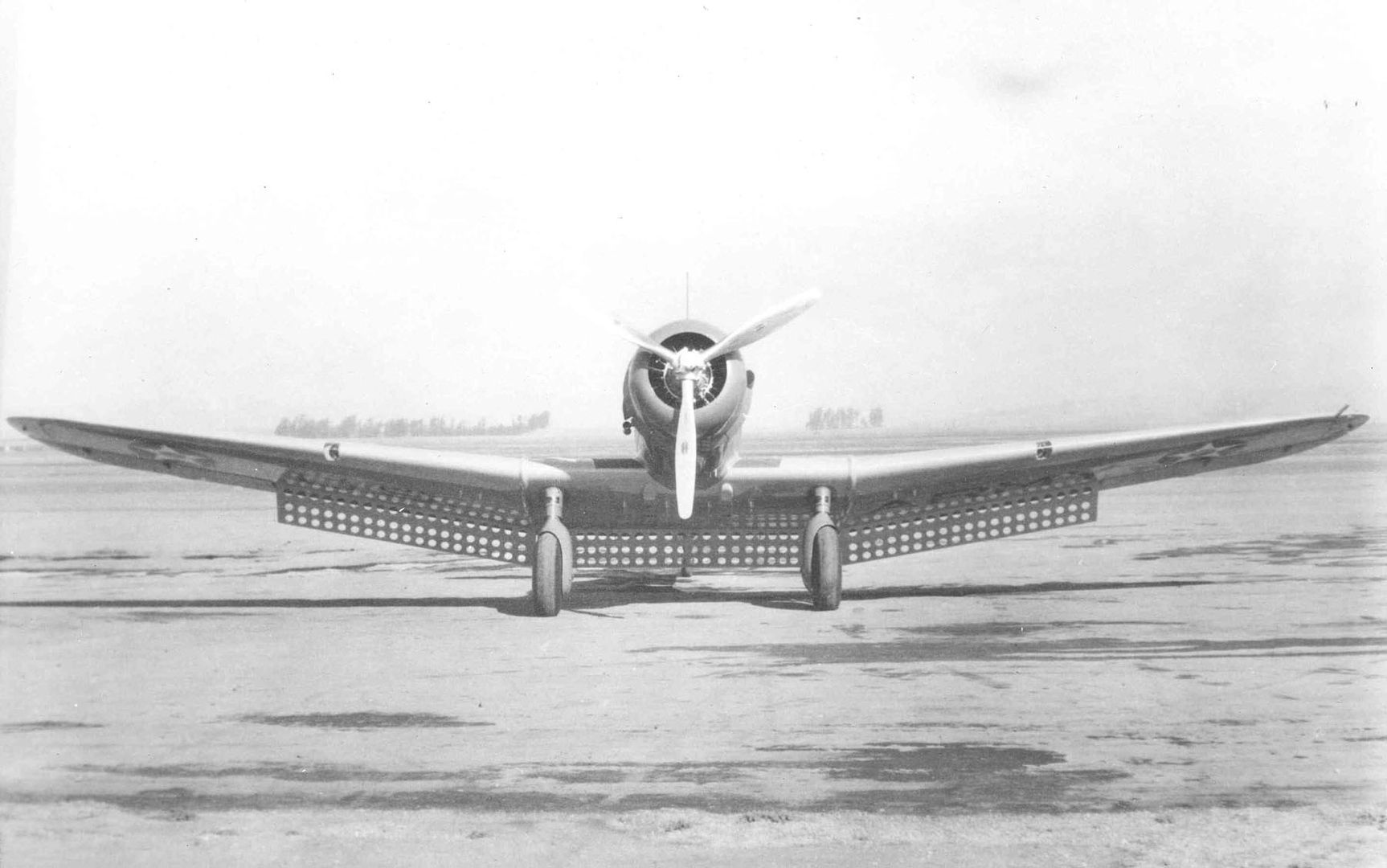
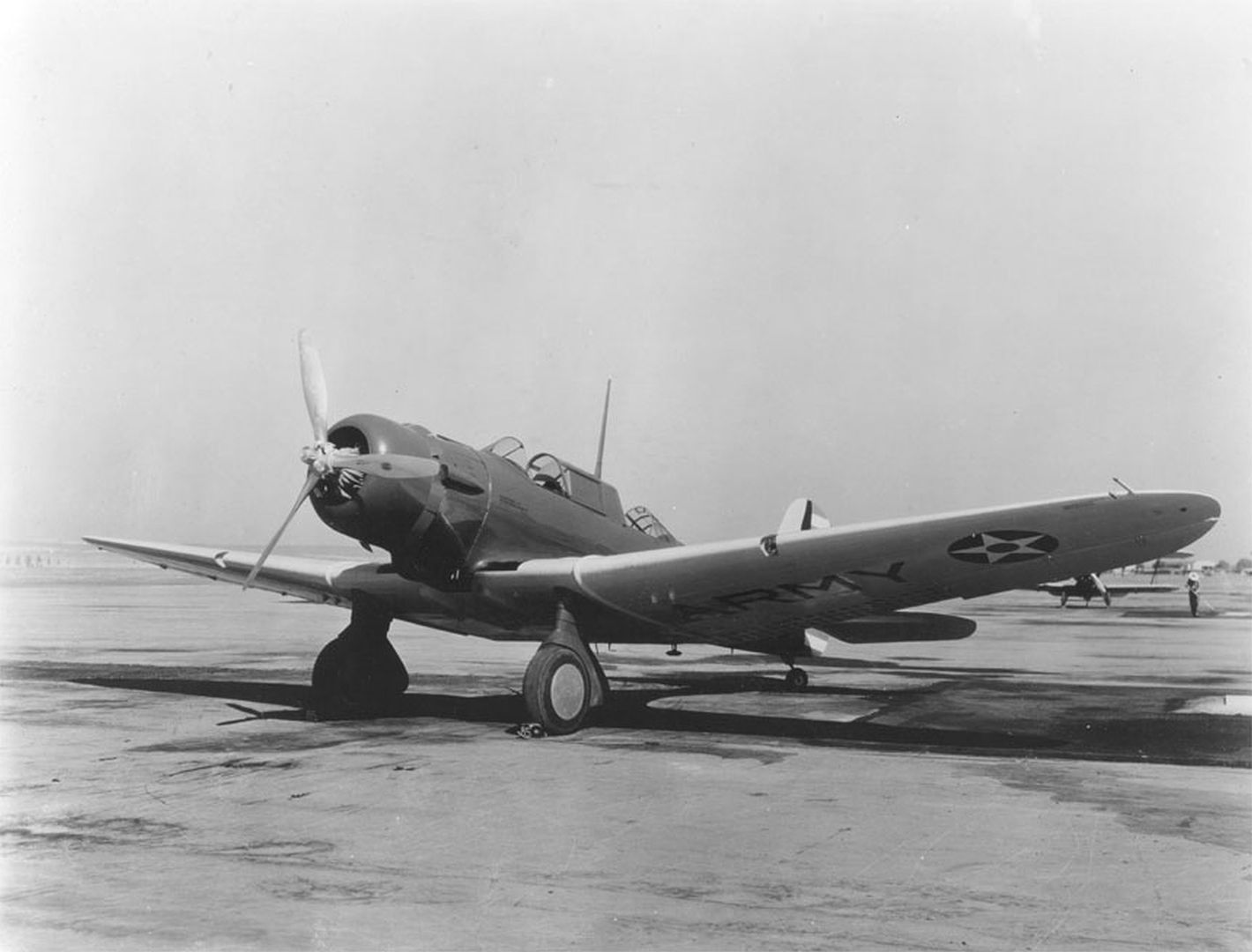


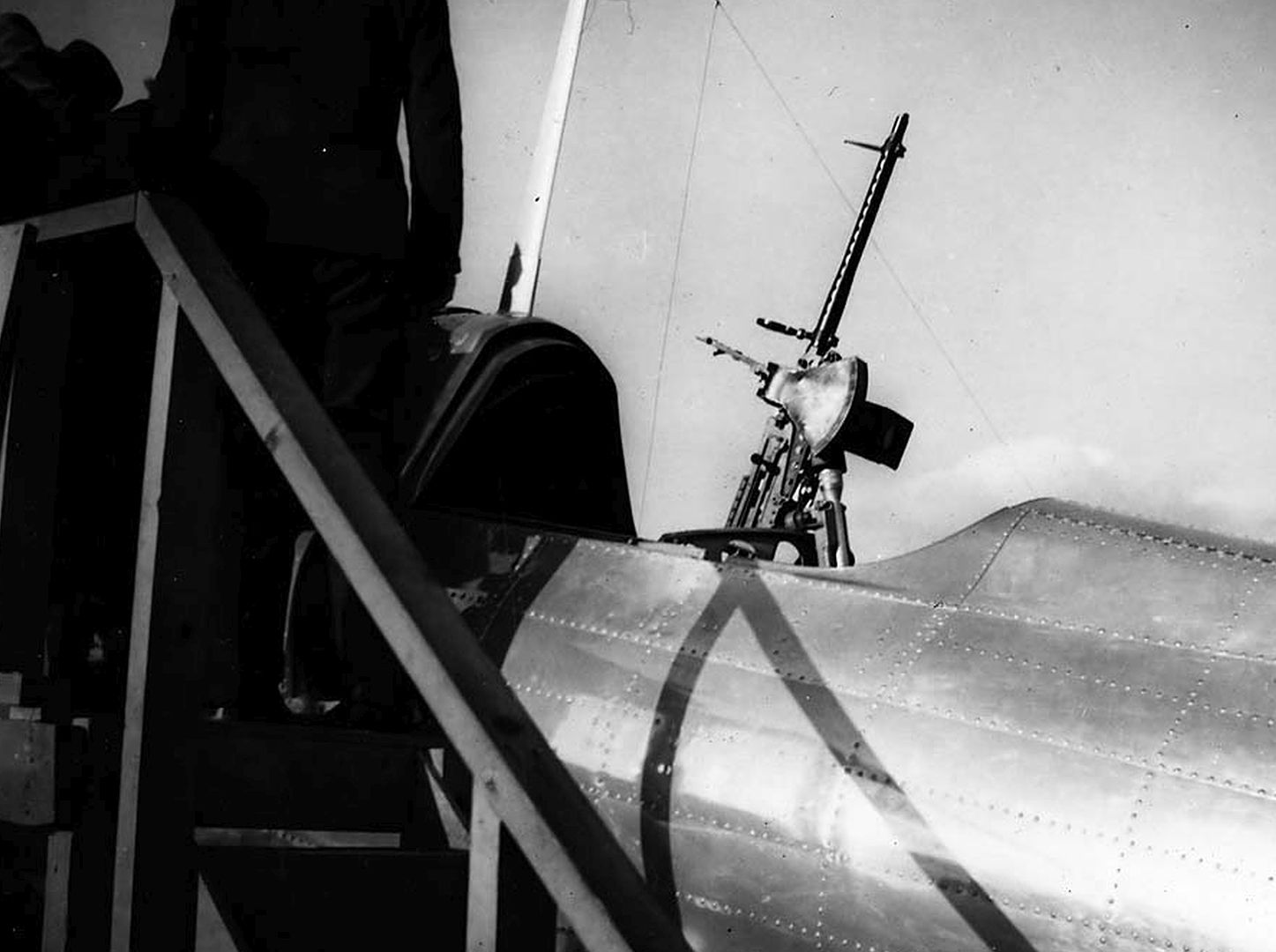
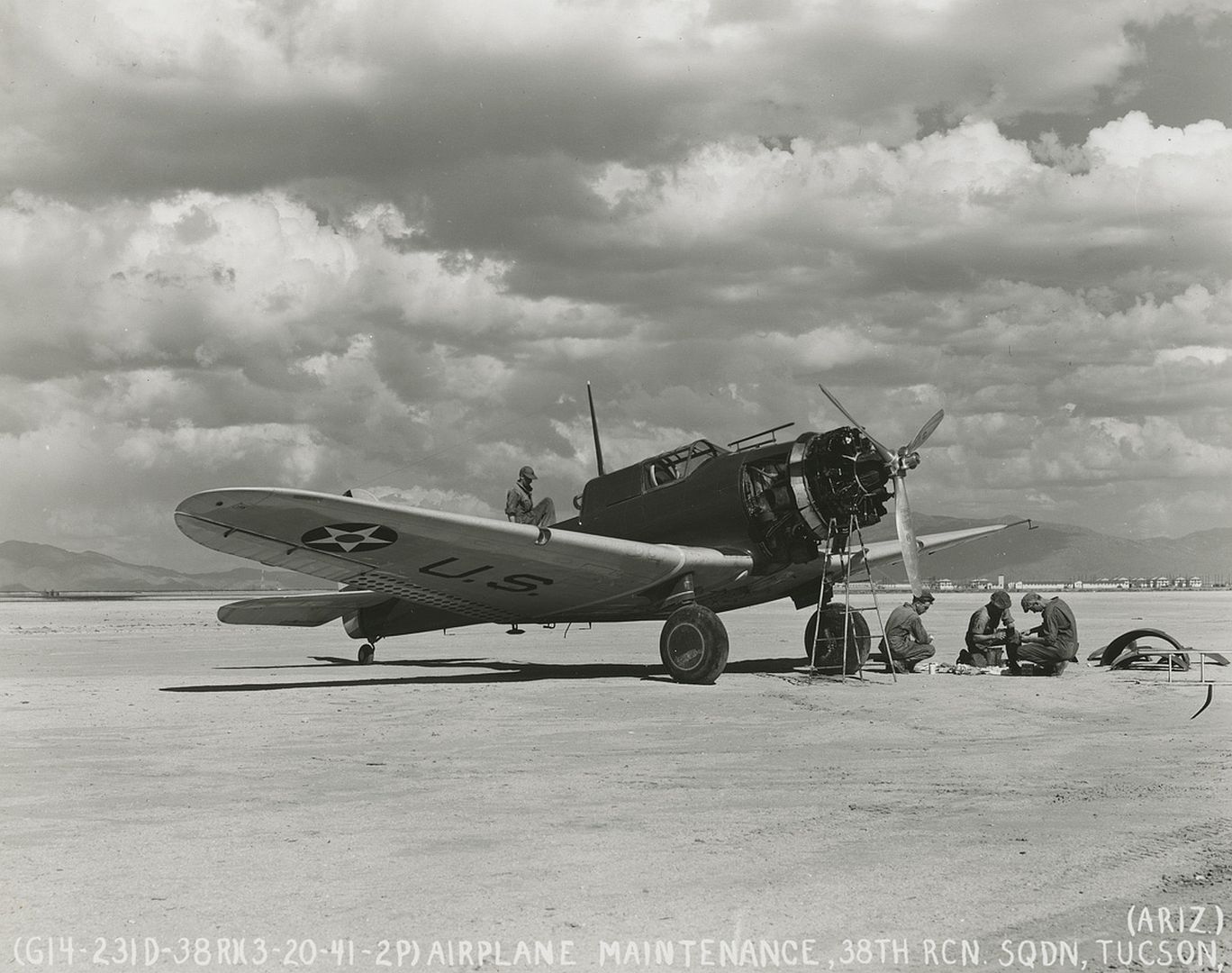
_Nomad_May_15th_1938_Floyd_Bennet_Field.jpg?width=1920&height=1080&fit=bounds)
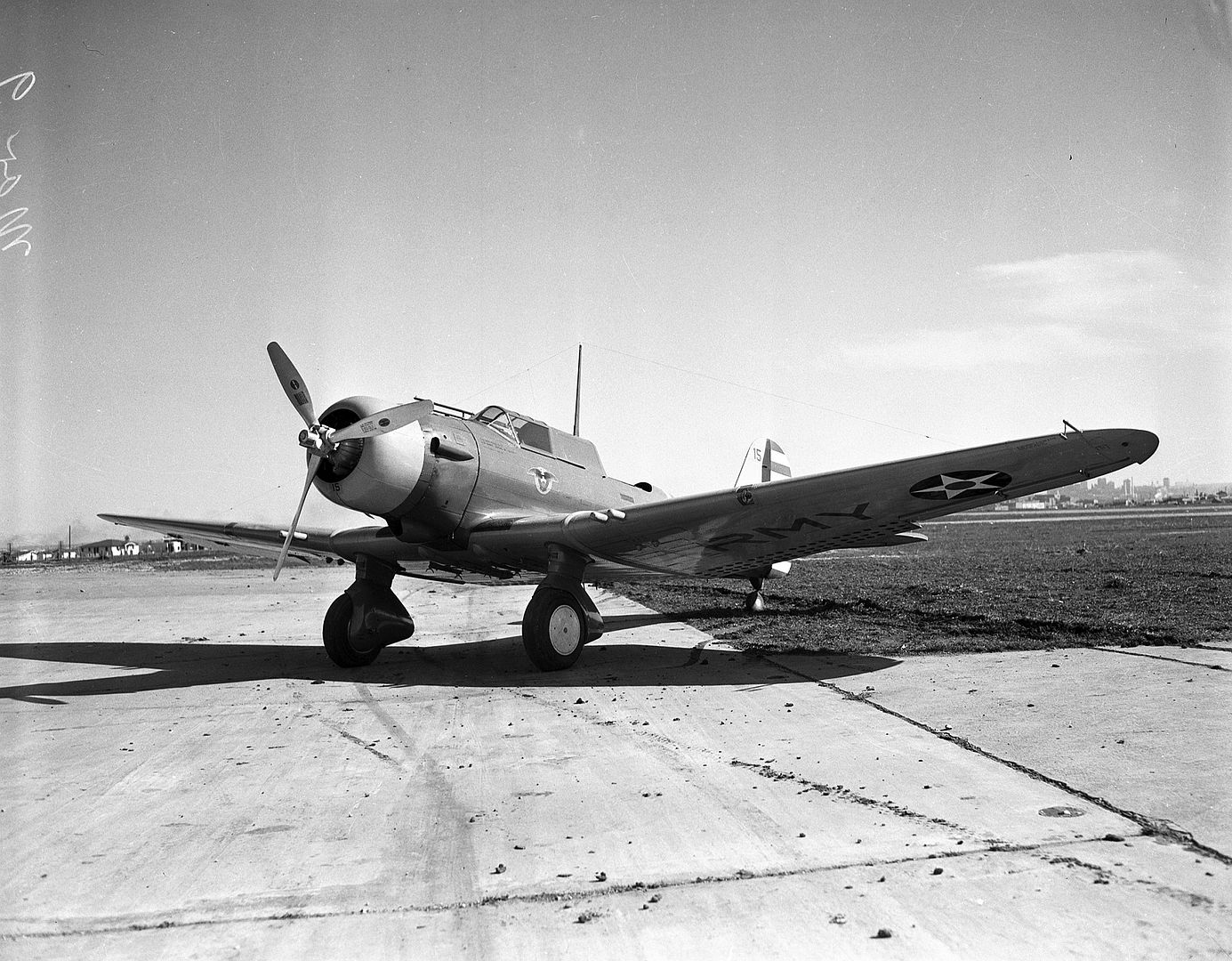
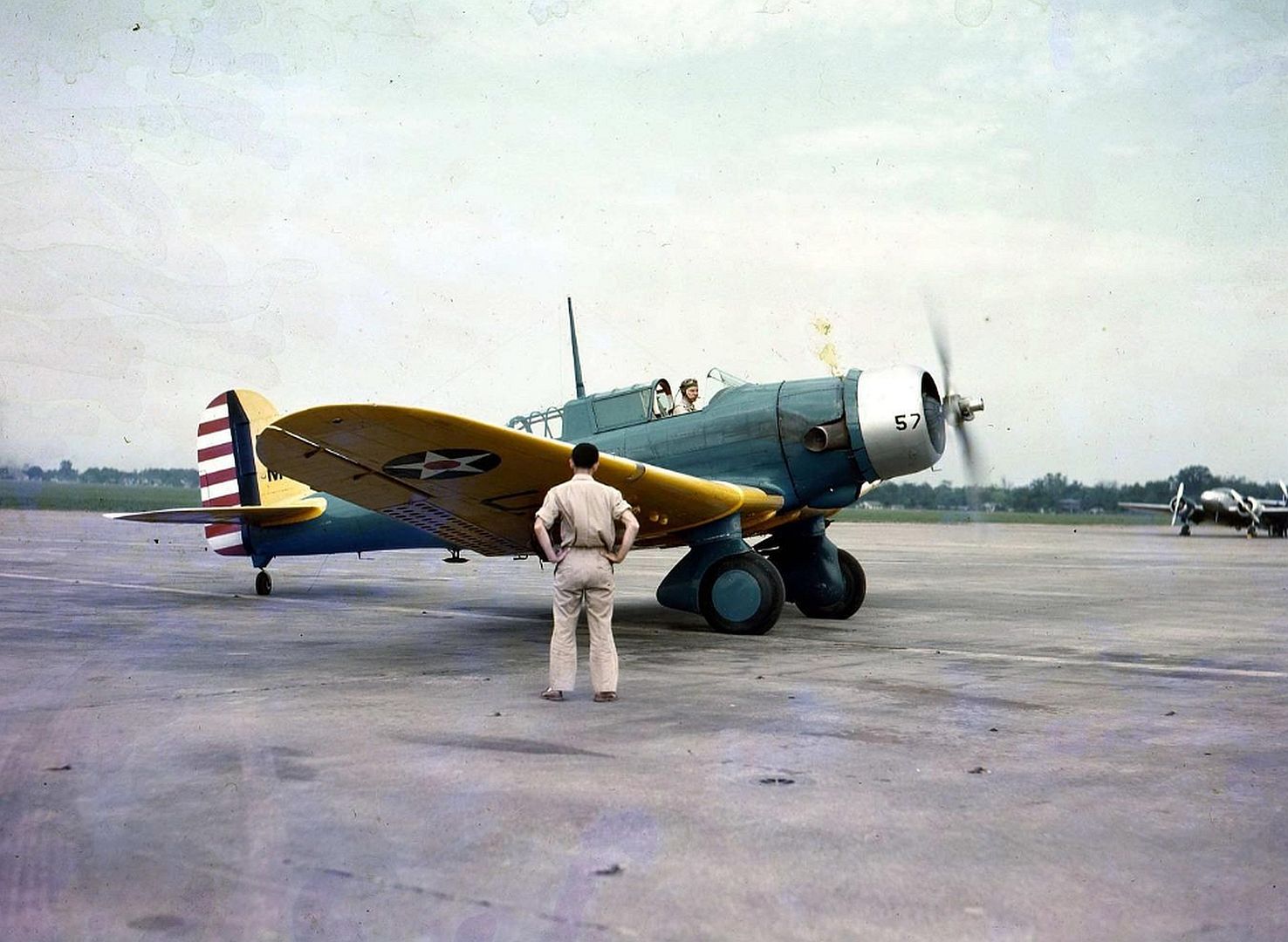
Below with gas canisters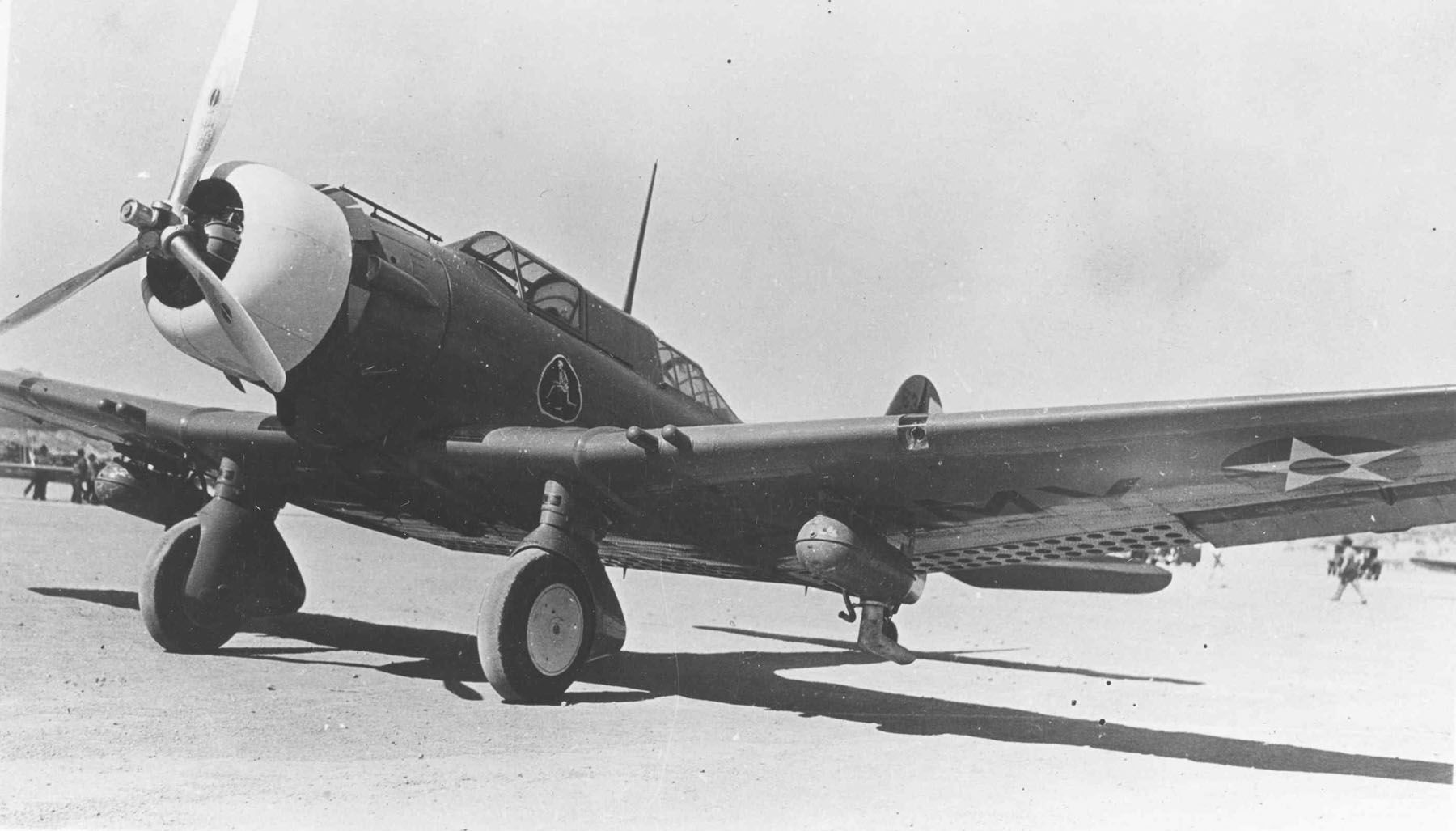
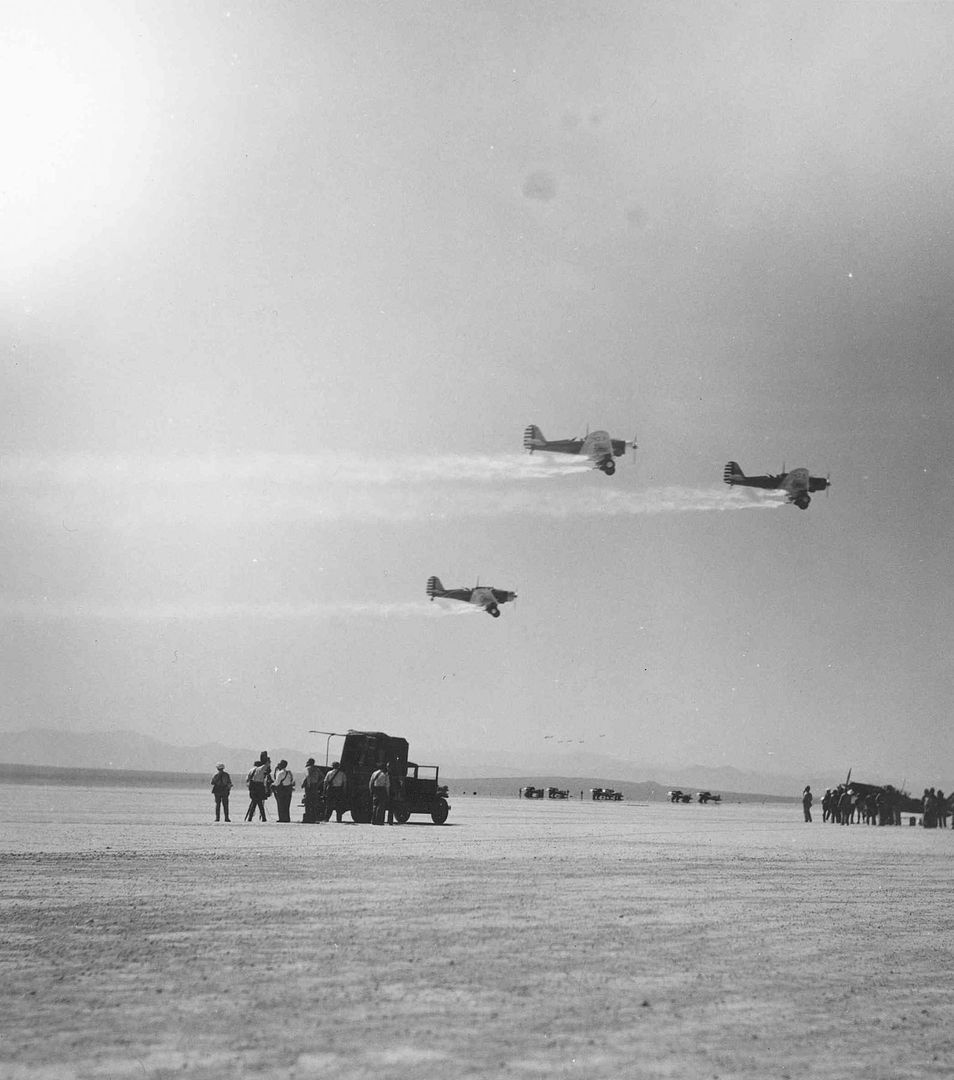
A-17 35-122 was used by the National Advisory Committee for Aeronautics (NACA) to investigate the characteristics of laminar-flow aerofoils. New highly-polished surfaces were built over and around the existing wing structure. The new surfaces were highly polished and protruded ahead of the leading edge and behind the trailing edge, nearly doubling the wing chord inboard of the ailerons. A two-bladed propeller driven by a small auxiliary engine was mounted on each side forward of the new leading edge to increase the speed of the airflow over the wing. However, it was found that it was much easier to obtain the same data by using conventional wind tunnels, and NACA discontinued the project.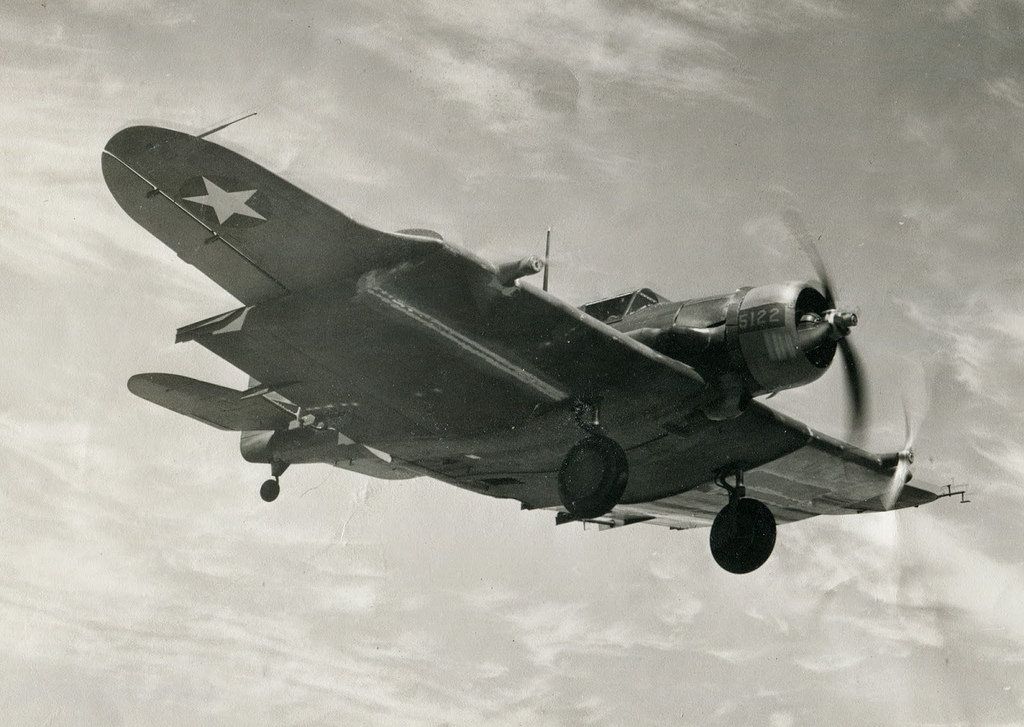
Serials of Northrop A-17:
35-051/160 Northrop A-17
c/n 44, 75/183
Specification of Northrop A-17:
Engine: One 750 hp Pratt & Whitney R-1535-11 Twin Wasp Junior fourteen-cylinder air-cooled radial engine. Performance: Maximum speed 207 mph at sea level. Cruising speed 170 mph. Landing speed 67.5 mph. Initial climb rate 1530 feet per minute. An altitude of 5000 feet could be reached in 3.8 minutes. Service ceiling 20,700 feet. Absolute ceiling 22,150 feet. Normal range 650 miles with 654 pounds of bombs. Maximum range 1240 miles. Dimensions: Wingspan 47 feet 8 1/2 inches, Length 31 feet 8 5/8 inches, Height 11 feet 10 1/2 inches, Wing area 363 square feet. Weights: 4874 pounds empty, 7447 pounds loaded. Armament: Four wing-mounted 0.30-inch machine guns, plus one flexible 0.30-inch machine gun operated by rear cockpit gunner. Normal bomb load included twenty 30-pound fragmentation bombs carried in chutes inside the fuselage and four external 100-pound bombs. Maximum bombload was 1200 pounds. -
9 years agoSat May 25 2024, 10:11amDuggy
 Main AdminNorthrop A-17A
Main AdminNorthrop A-17A
While production of the A-17 was underway, Northrop proposed the development of a version of the A-17 with a fully retractable main undercarriage. This retractable undercarriage consisted of a set of main wheels attached to the forward edge of the wing which retracted inwards into wheel wells underneath the fuselage. This retractable undercarriage was first tested on the Gamma 2J experimental advanced trainer. The A-17 design turned out to be readily adaptable to a retractable undercarriage, with relatively few changes being required. However, the use of the retractable undercarriage did require that the inboard leading edge wing roots be extended to provide space for the wheels.
On January 29, 1936, an initial order was placed for 100 retractable- undercarriage versions of the A-17, which were assigned the designation A-17A. Serials were 36-162/261. The first production A-17A (36-162) flew for the first time on July 16, 1936. There were some teething problems with the retractable undercarriage, which resulted in a delay of delivery to the USAAC until February 4, 1937. The aircraft was used for testing during this period, and two accidents caused by undercarriage failures caused the delivery of the second production aircraft to be delayed until April 1937. Once these difficulties were cleared up, the the 100 A-17As were delivered between April and December of 1937. A further 29 A-17As (38-327/355) were ordered during the second half of 1937, and these were delivered between June and September 1938.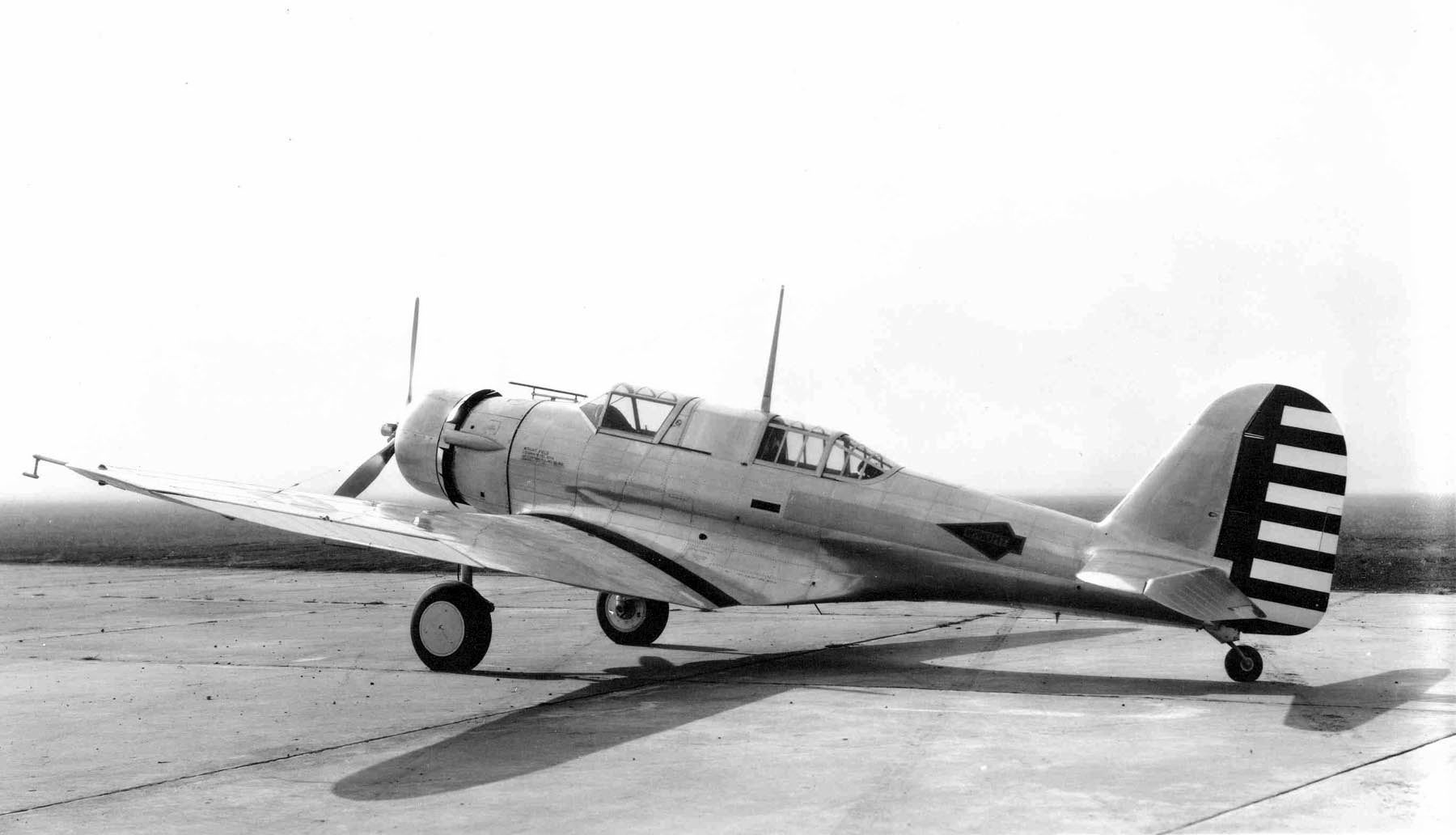
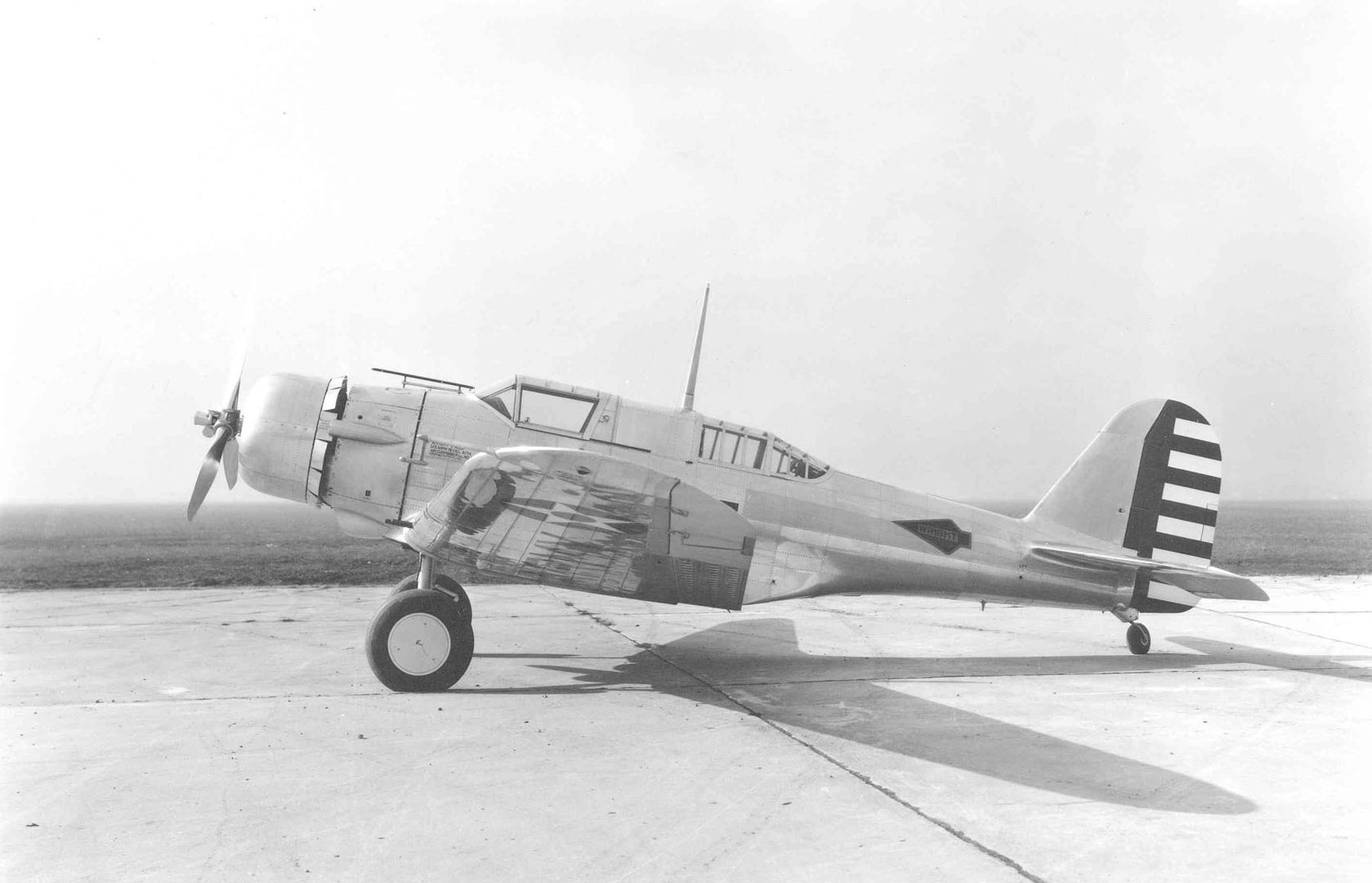
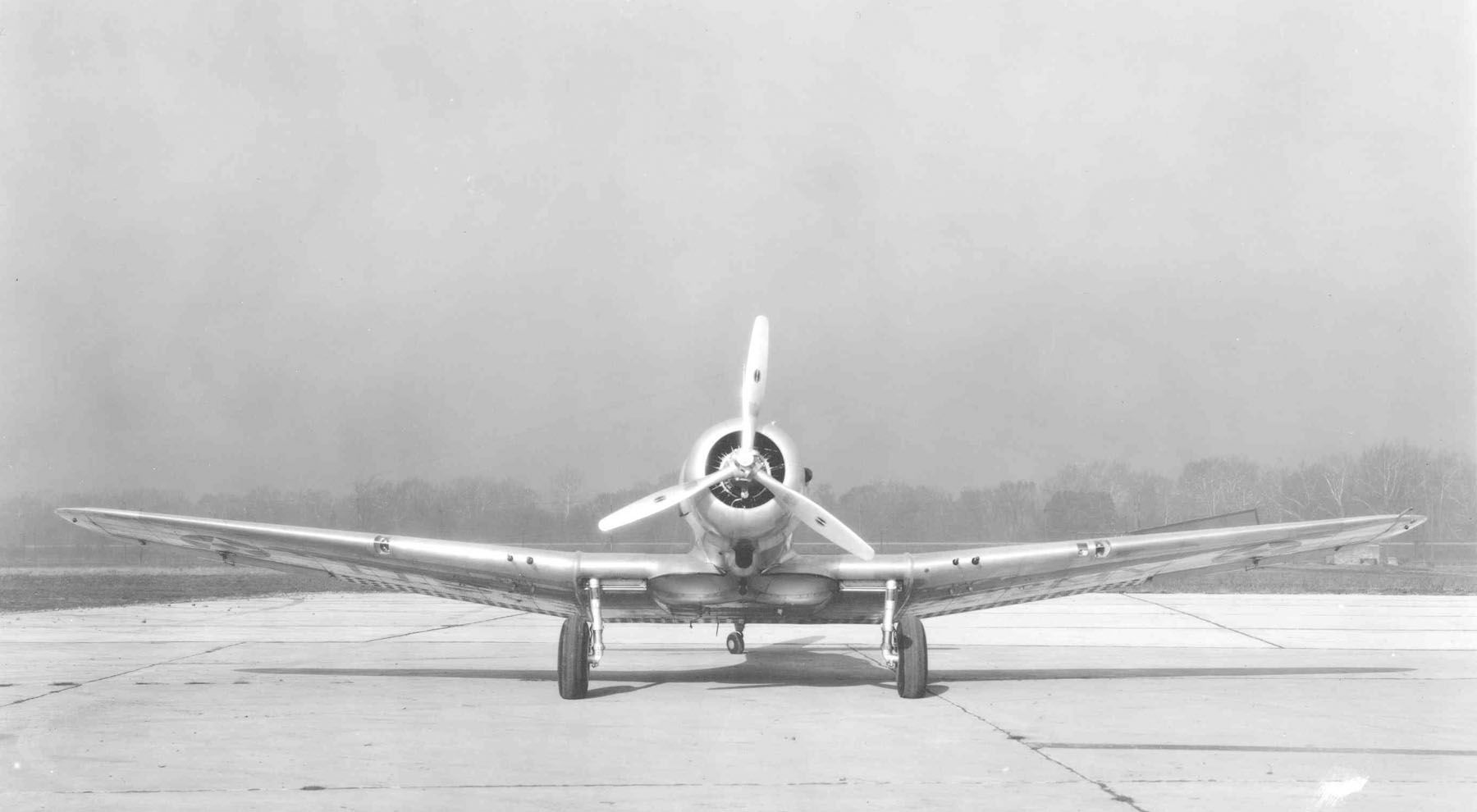

All A-17As were powered by a 825 hp R-1535-13 Twin Wasp Junior engine. They were armed with four wing-mounted 0.30-inch machine guns and had a flexible 0.30-inch machine gun operated by the gunner in the rear cockpit. Normal bombload was four externally-carried 100-lb bombs or 20 30lb anti-personnel bombs carried internally. A maximum bombload was 1200 pounds.
The A-17As were delivered in 1937 to the 3rd Attack Group (8th, 13th, and 90th Squadrons) at Barksdale Field, Louisiana and to the 17th Attack Group (34th, 37th, and 95th Squadrons) based at March Field, California. They supplemented and later replaced the fixed-undercarriage A-17s serving with these units. The A-17A was fairly fast and had a fairly heavy forward-firing armament for its time, and during 1938-39 war games it was deemed to be the most effective ground attack aircraft yet devised. However, the Army decided that twin-engined attack aircraft offered substantial advantages over the single-engined types then in service, and the career of the A-17A with the Army was quite brief. After only three years of service with the Army, the A-17As were declared surplus.

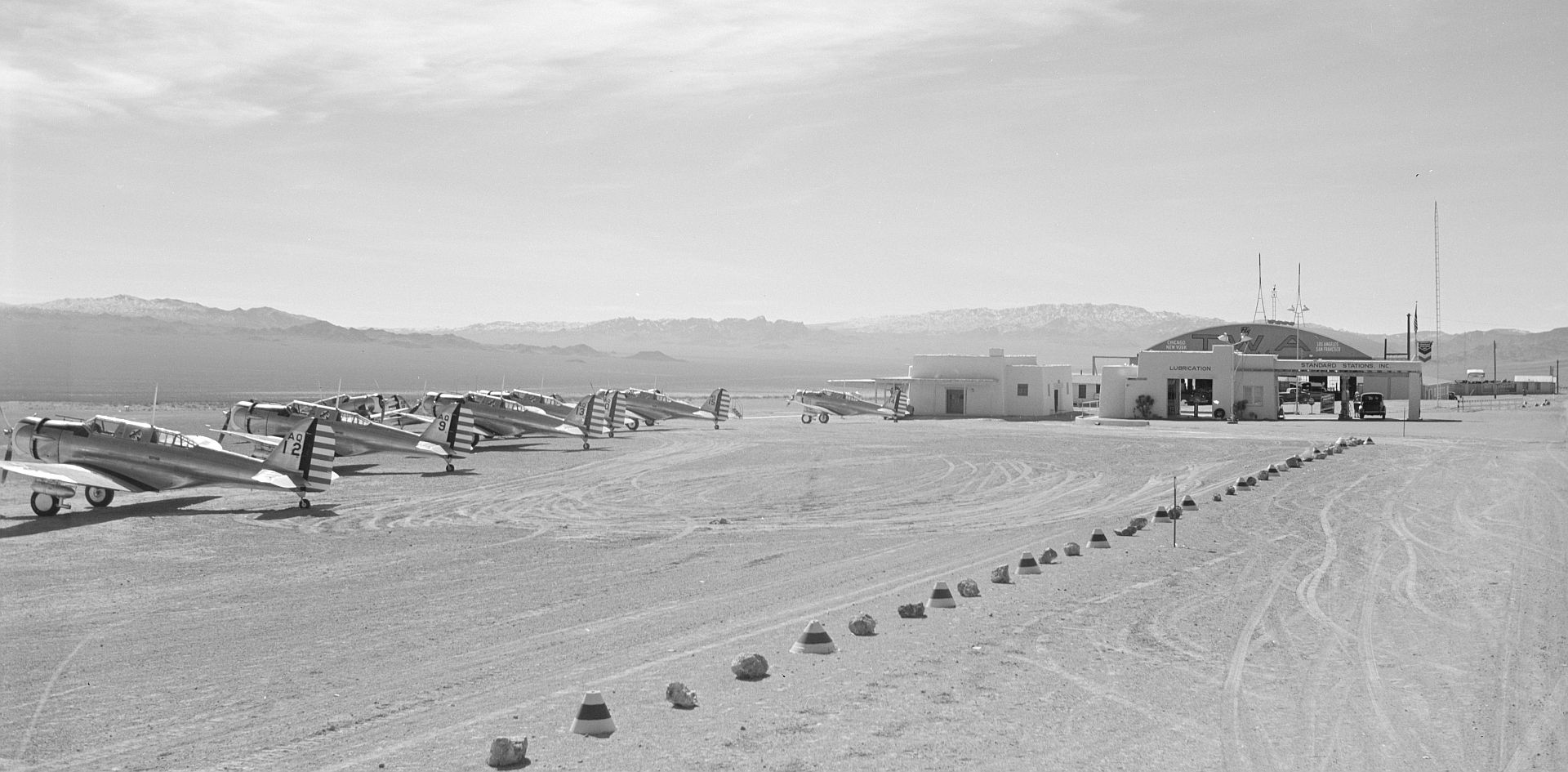
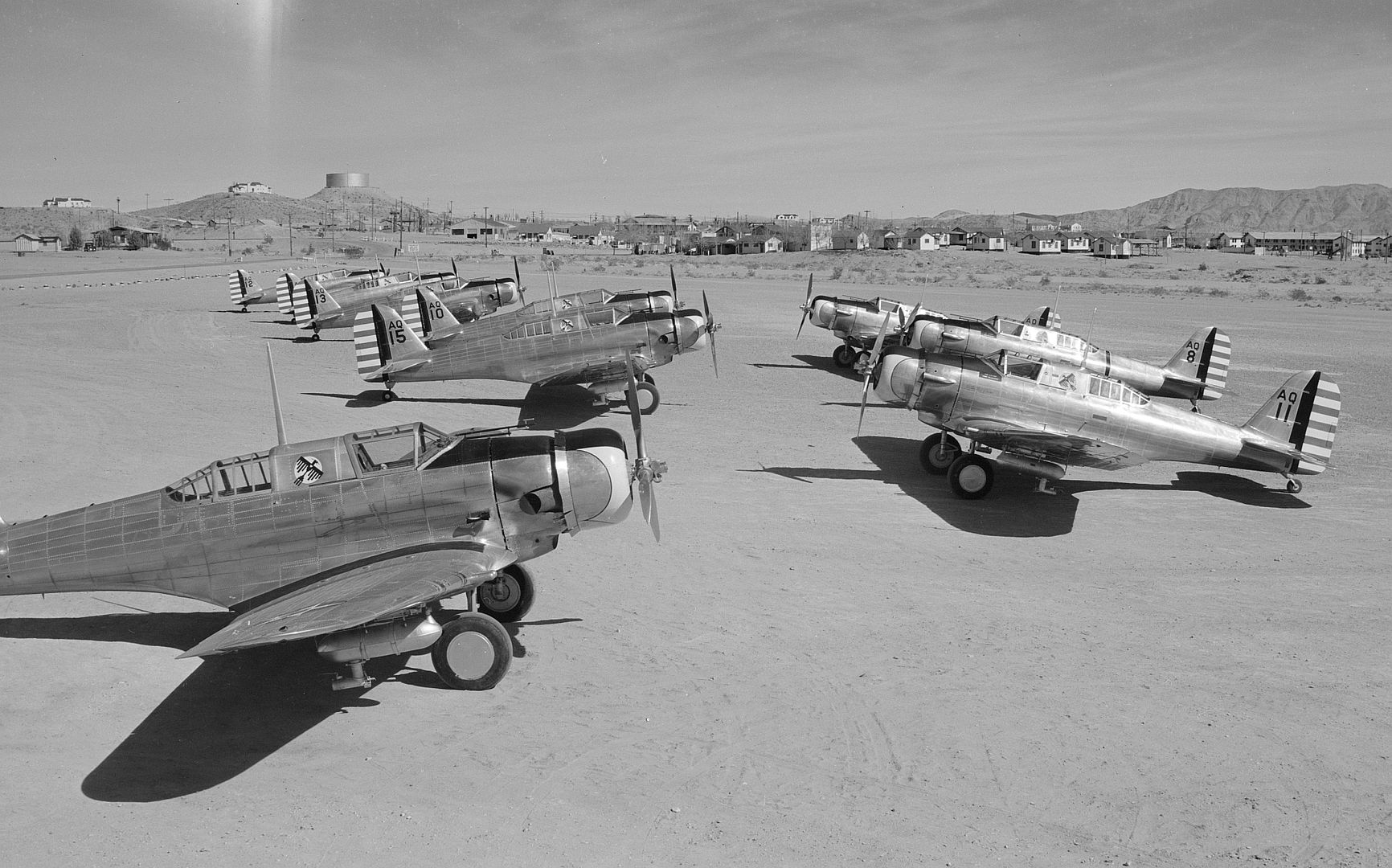
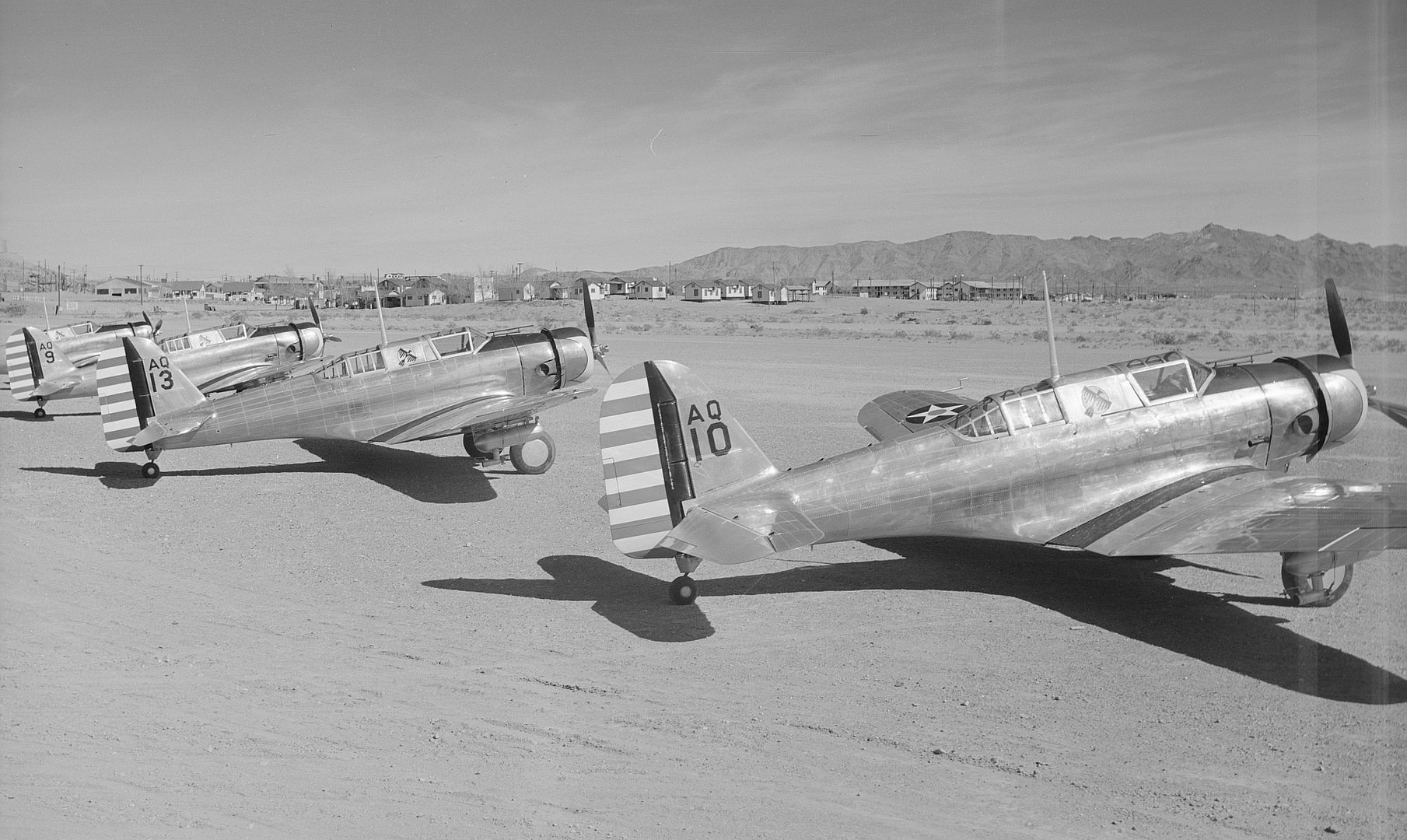
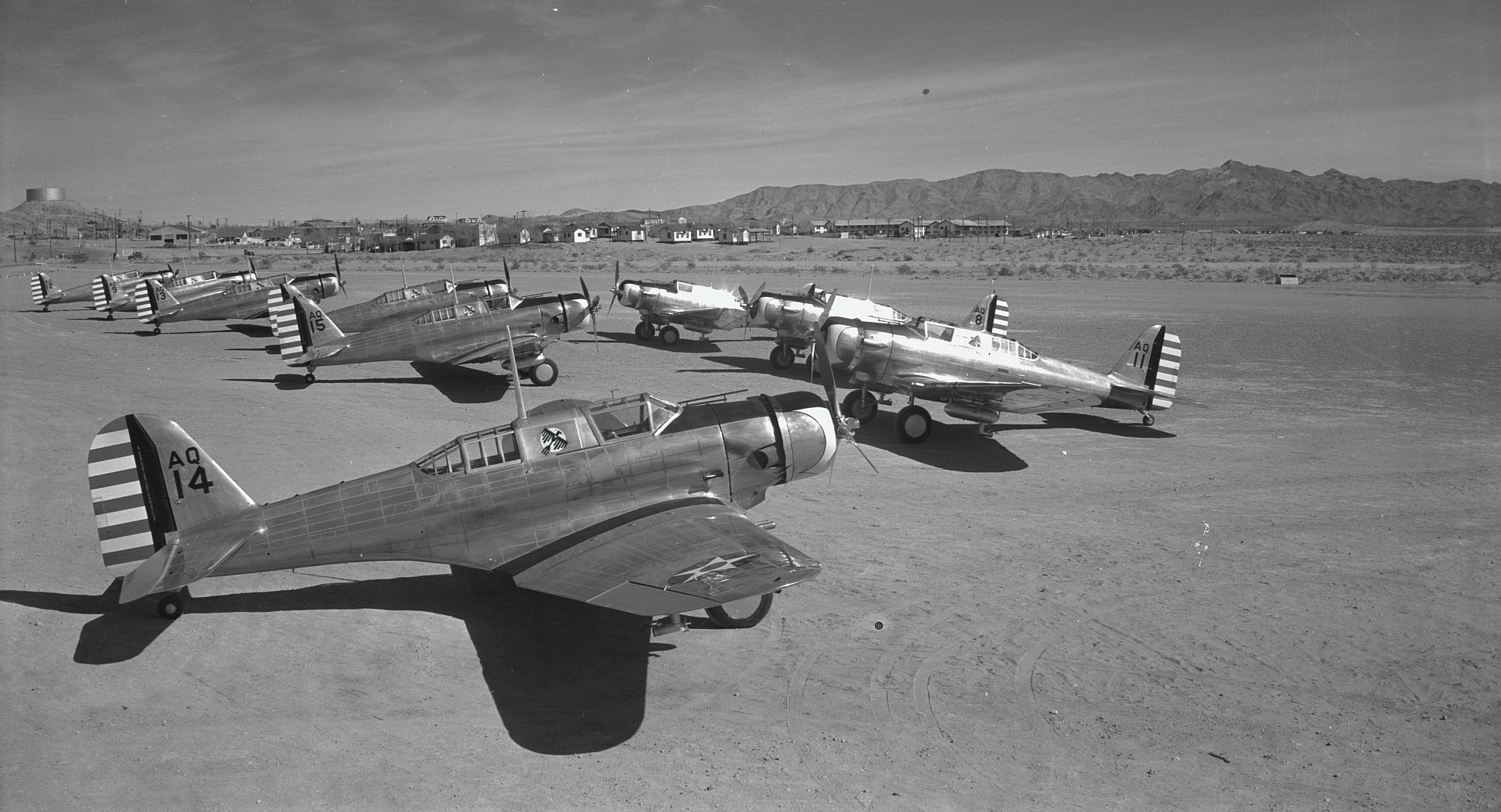
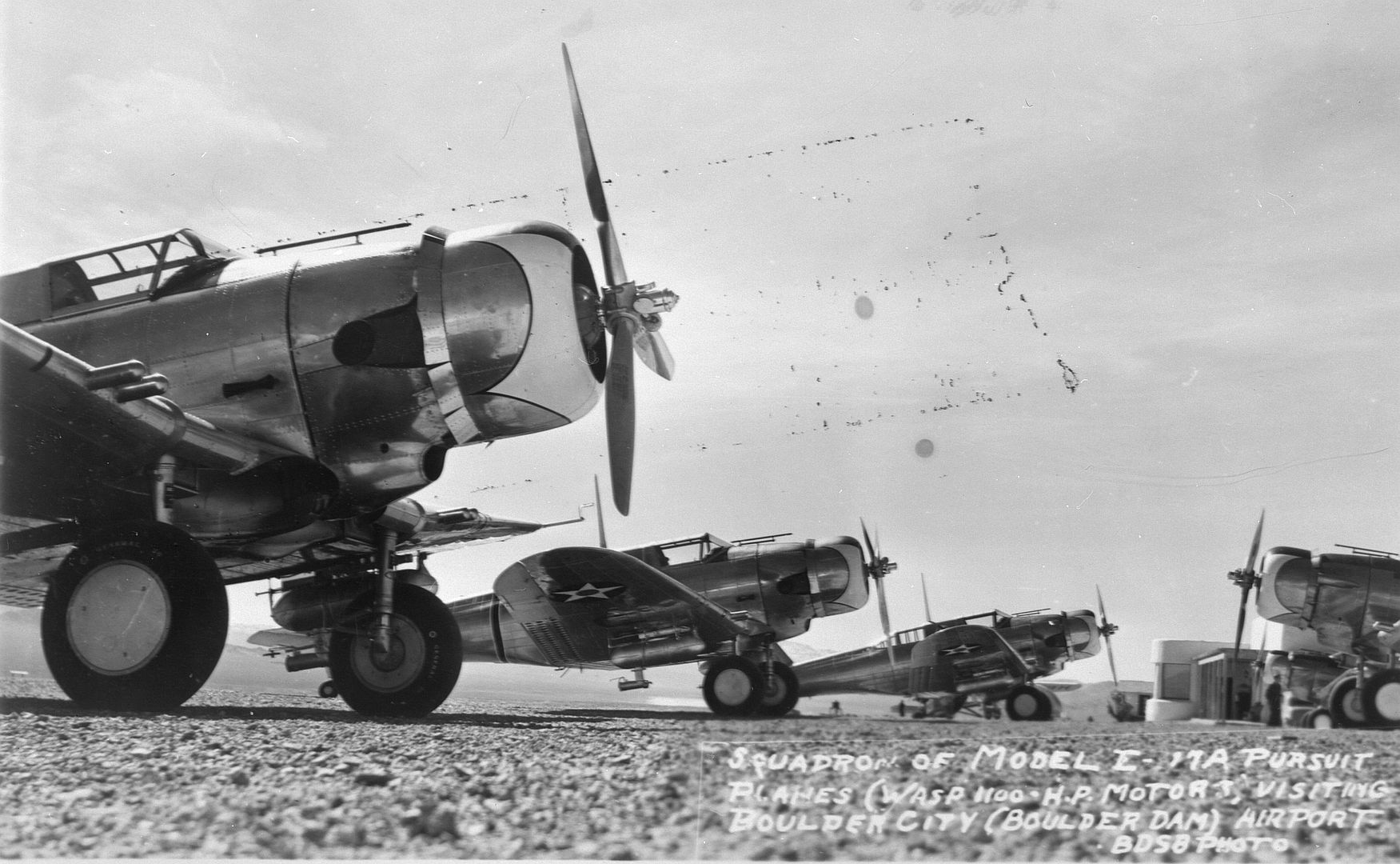
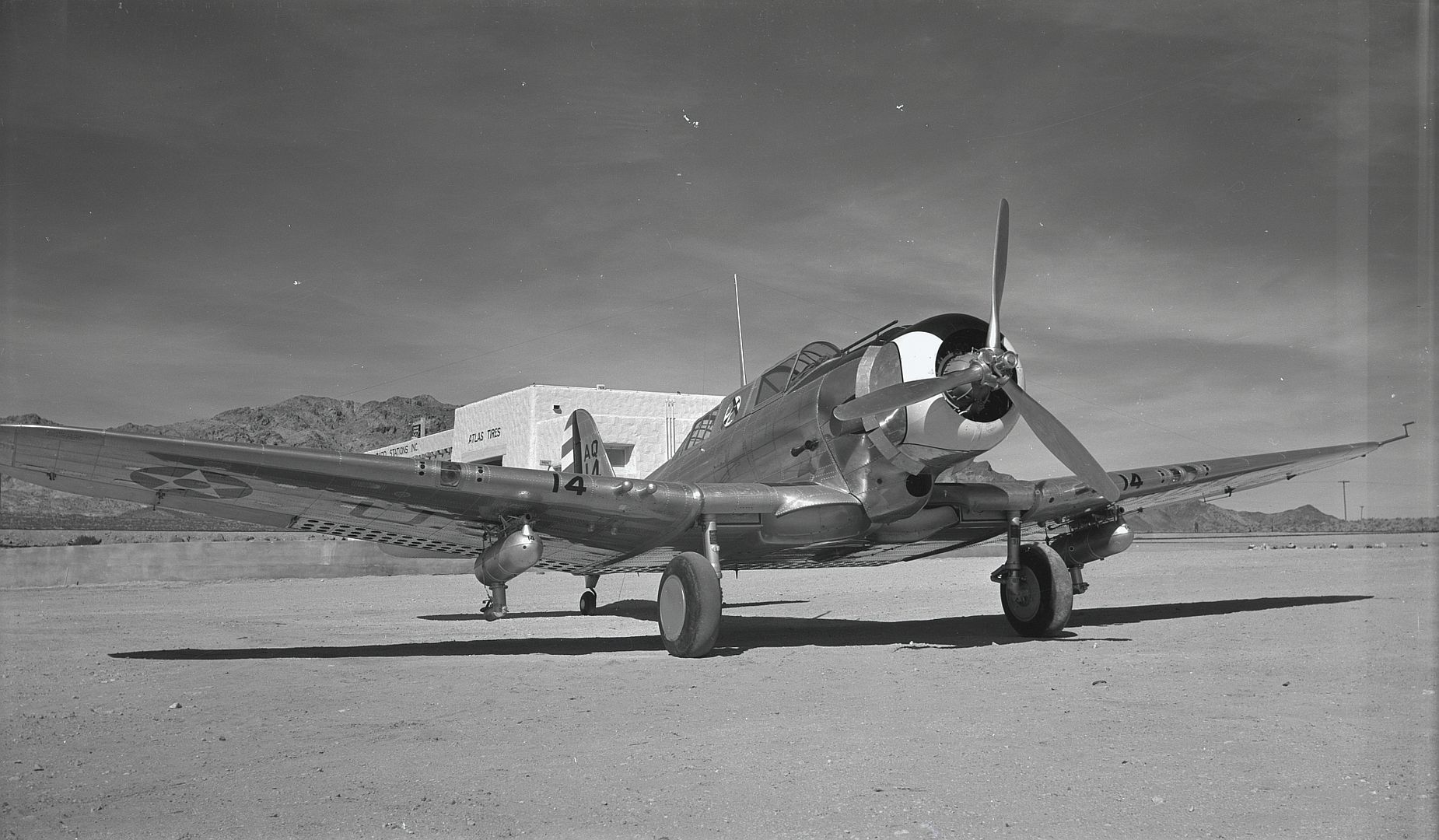
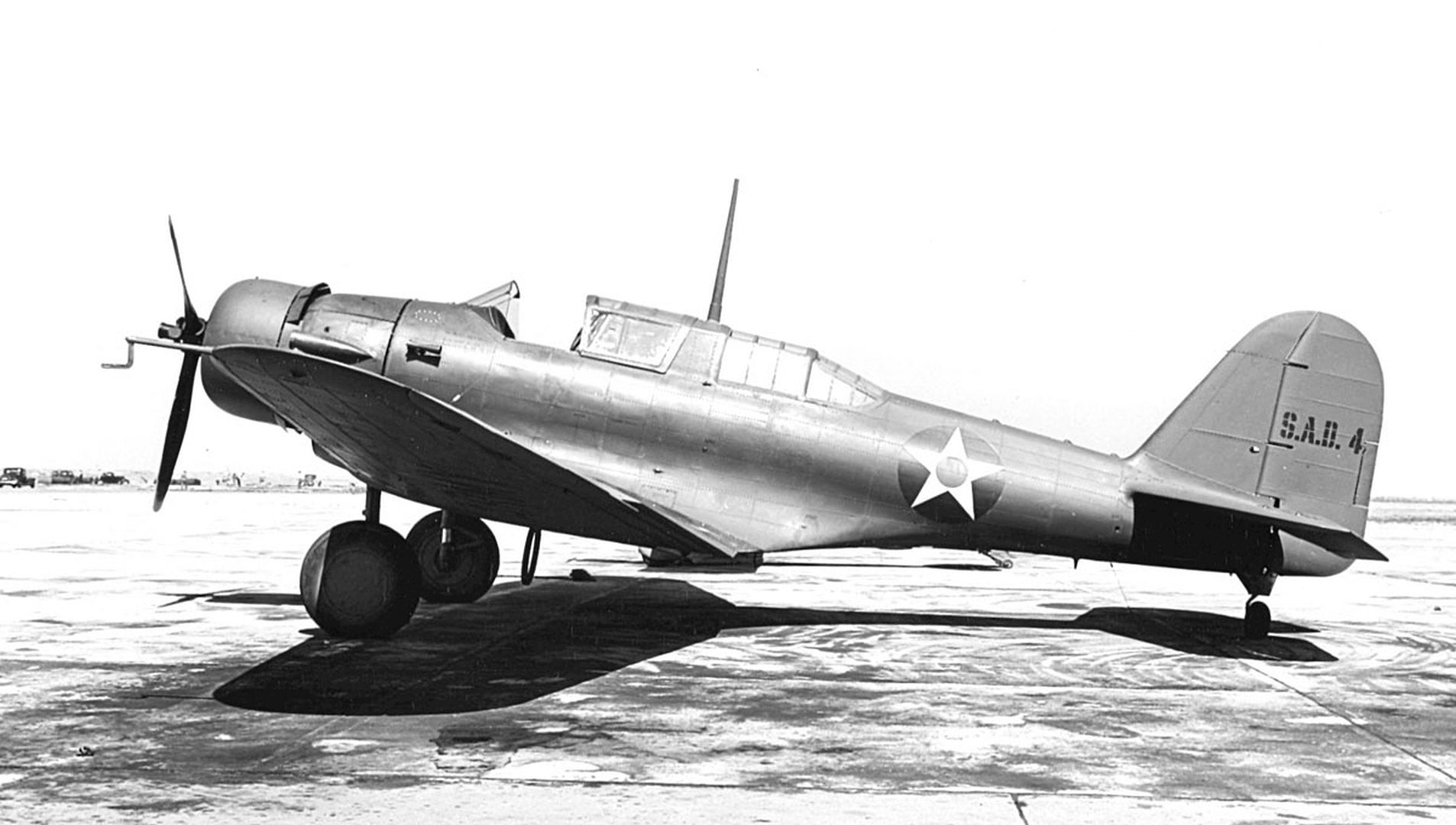
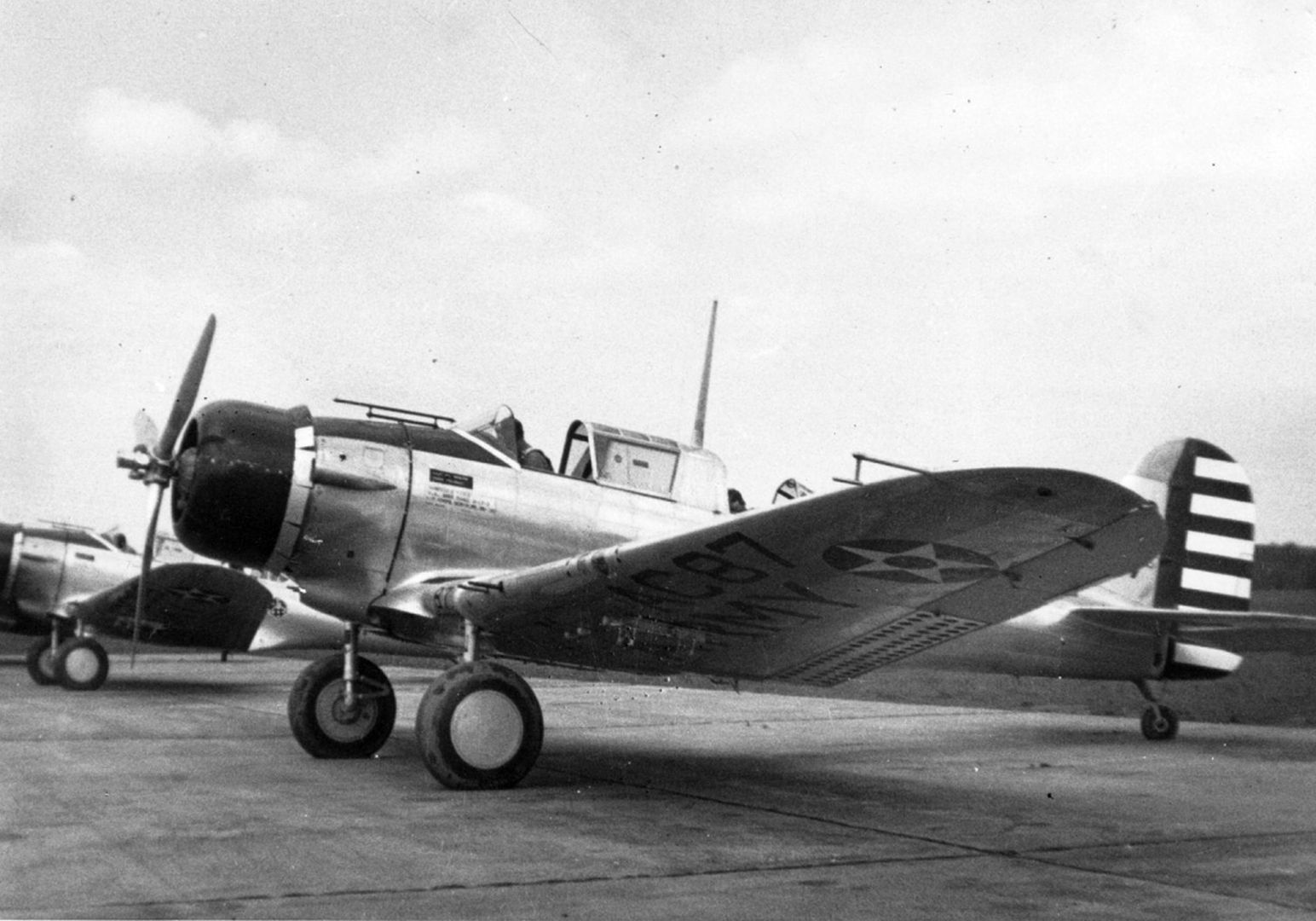
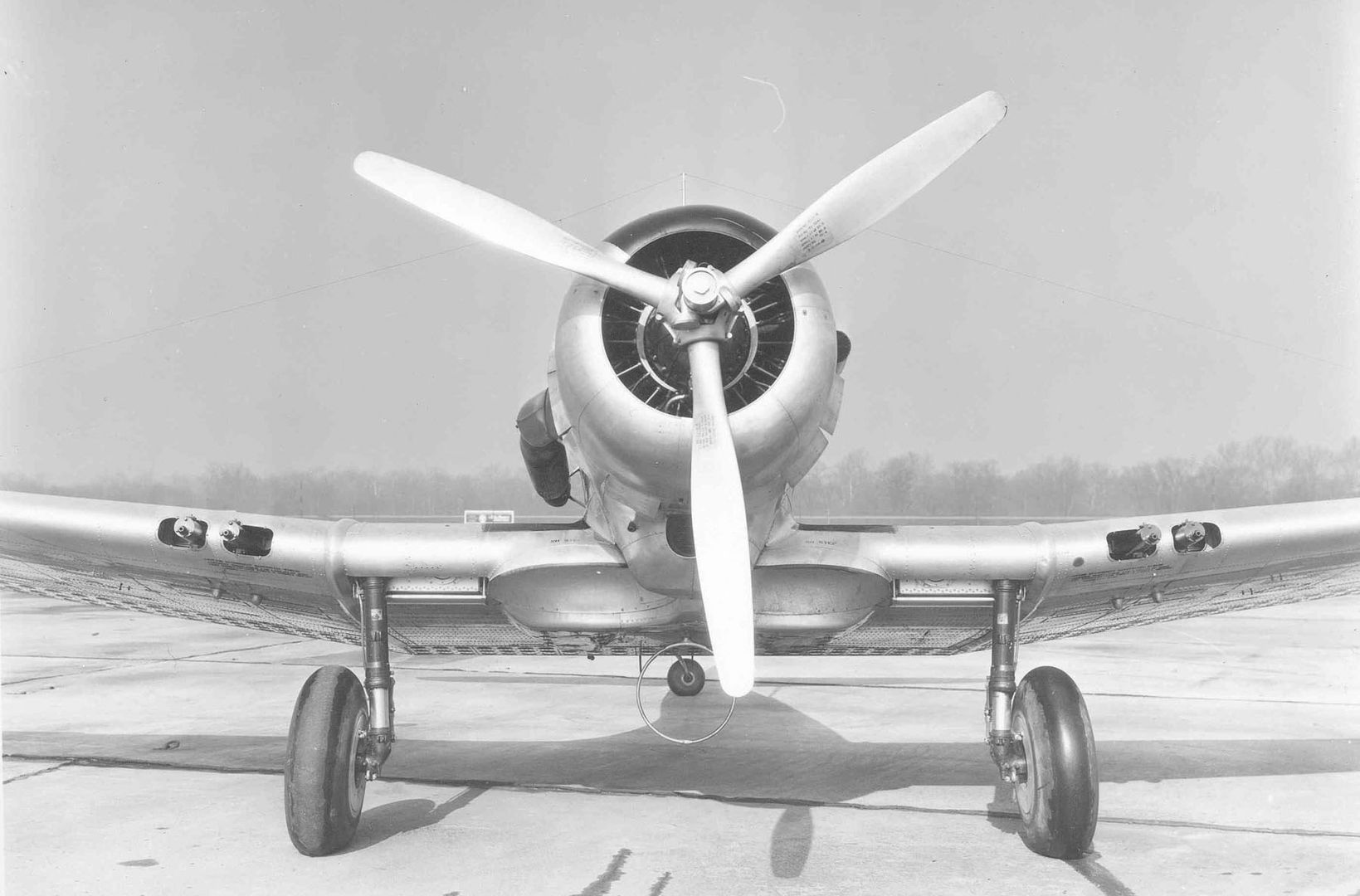
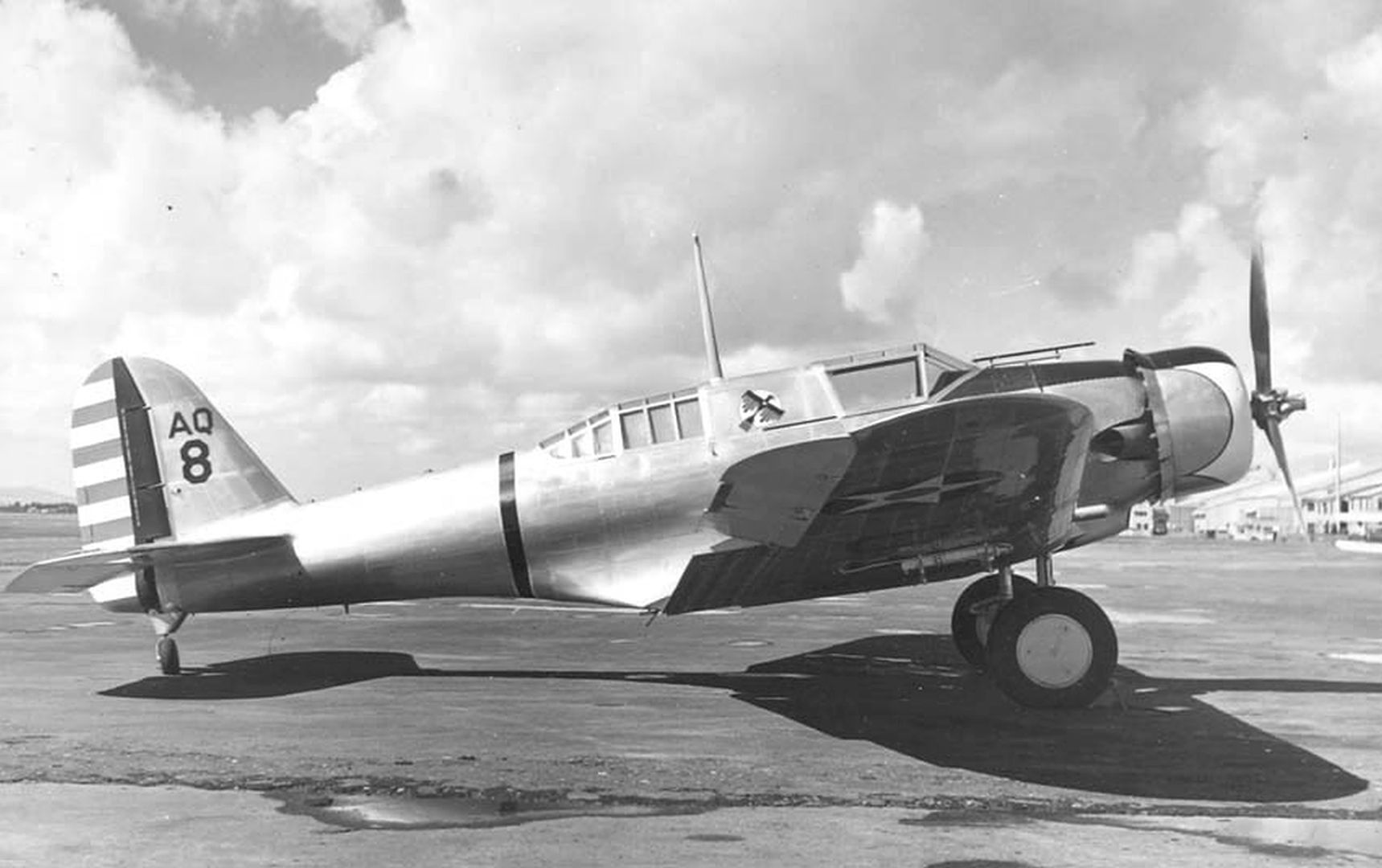

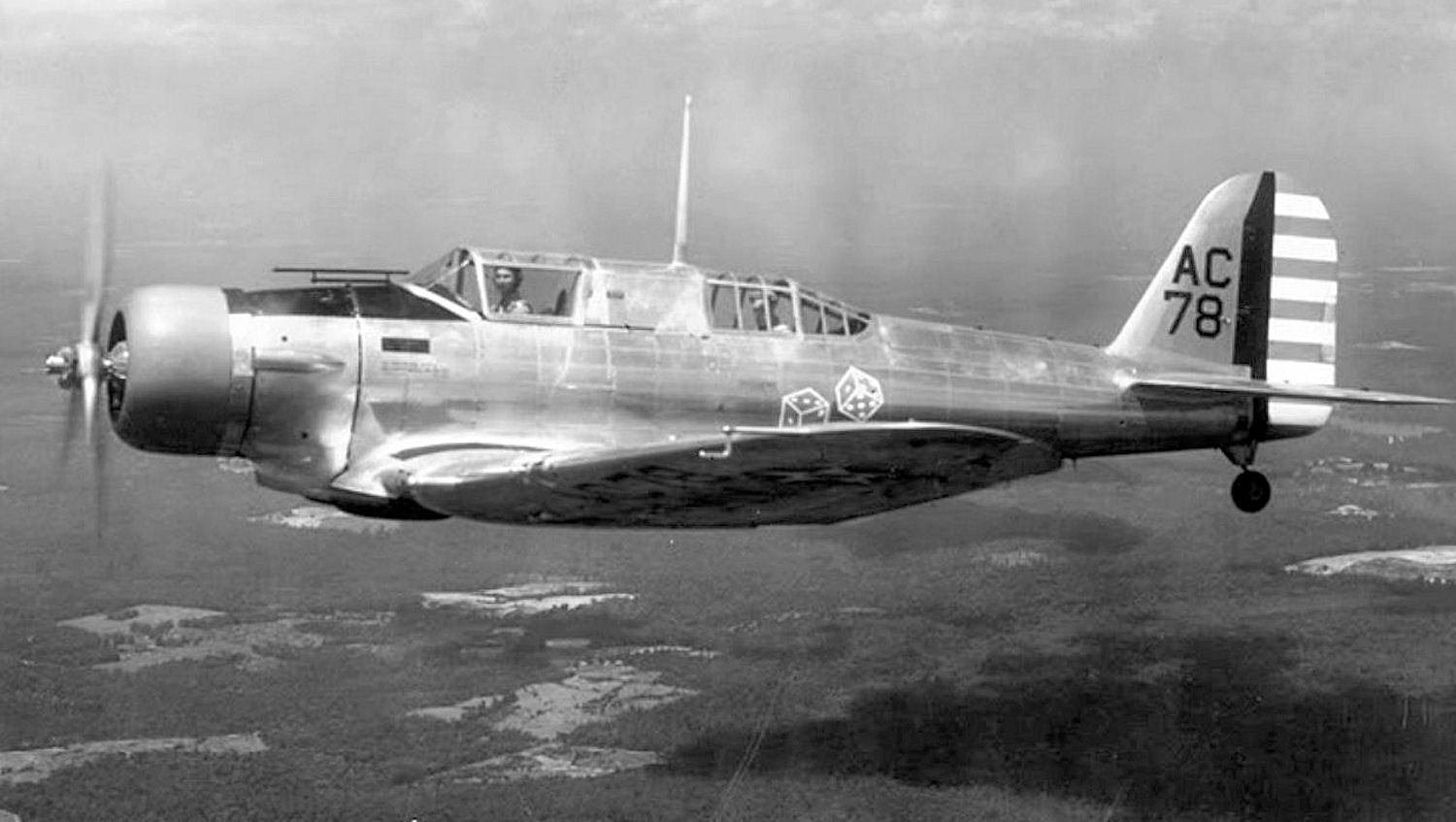
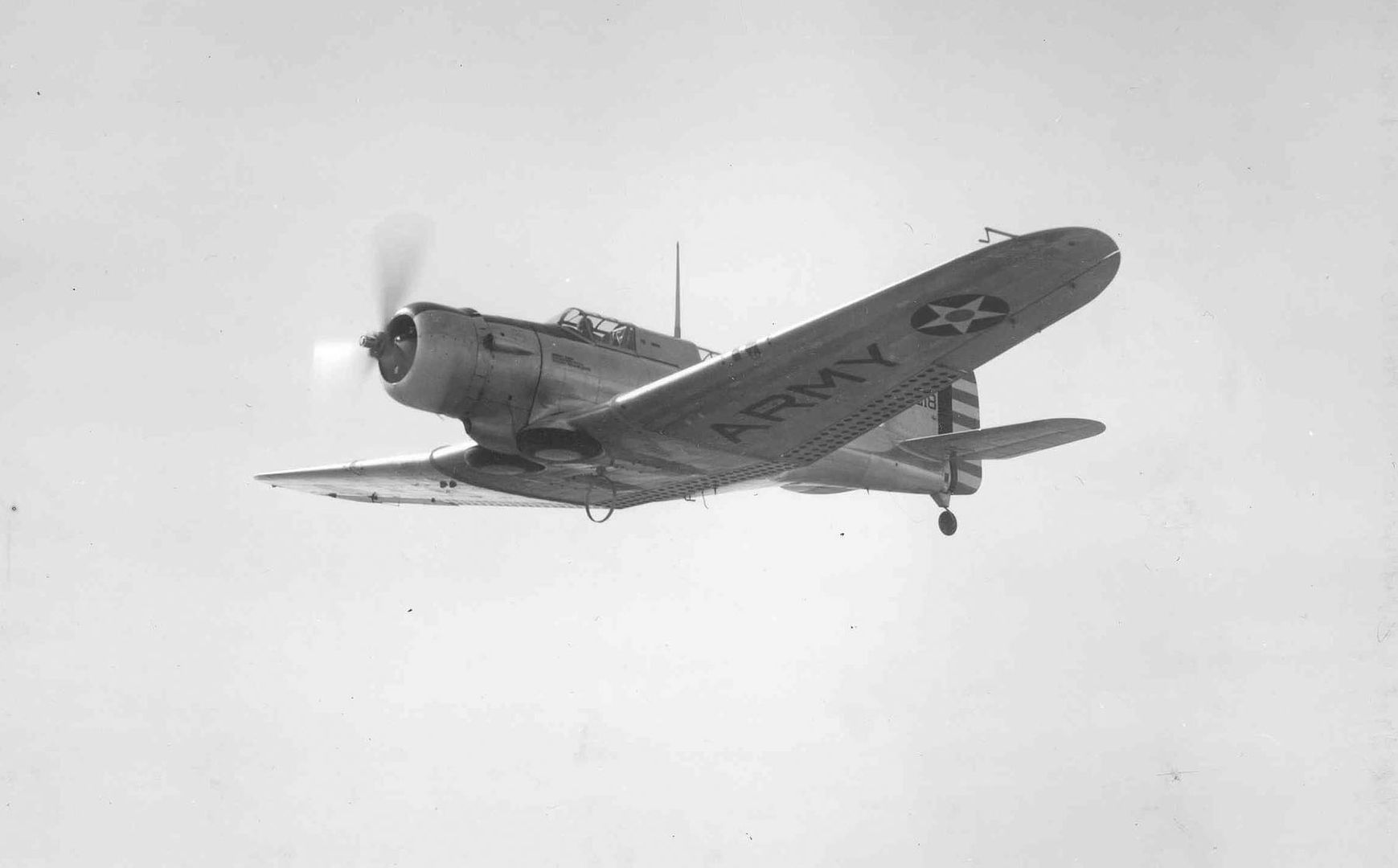

Following the beginning of the Second World War with the German invasion of Poland, the French Armee de l'Air felt an urgent need for dive bombers, and since the US Army considered the A-17A to be obsolescent, the French Purchasing Commission that was touring the USA looking for aircraft was given permission to obtain 93 of the ex-USAAC A-17As.
The 93 A-17As ordered by France were withdrawn from USAAF service and were returned to the Northrop factory (which was by this time known simply as the El Segundo Division of Douglas) where they were refurbished and re-engined with 825 hp Pratt & Whitney Twin Wasp JrS2A5-G engines. Unfortunately, by the time that the planes were ready for delivery, France had fallen. The contract was then taken over by the British Purchasing Commission, which at that time was willing to buy just about anything that had wings. The British A-17As were given the RAF name Nomad. RAF serials were AS440/AS462, AS958/AS976, and AW420/AW438.
However, the RAF also deemed the Nomad to be obsolescent, and decided to restrict it from combat operations. 60 of the RAF Nomads were transferred to South Africa. 17 were lost at sea en enroute. The survivors were taken on charge in February 1941 by the SAAF, where they were used for training. None of these aircraft ever saw any combat. They remained in service until the end of 1942 when they were replaced by Fairey Battles. The last SAAF Nomads were struck off charge in 1944.
Those A-17As still in the USA were used during the early war years as advanced trainers or as squadron hacks before ending their lives in mechanics' schools. None of these aircraft ever saw any combat either. The last A-17A was struck off charge on October 31, 1944.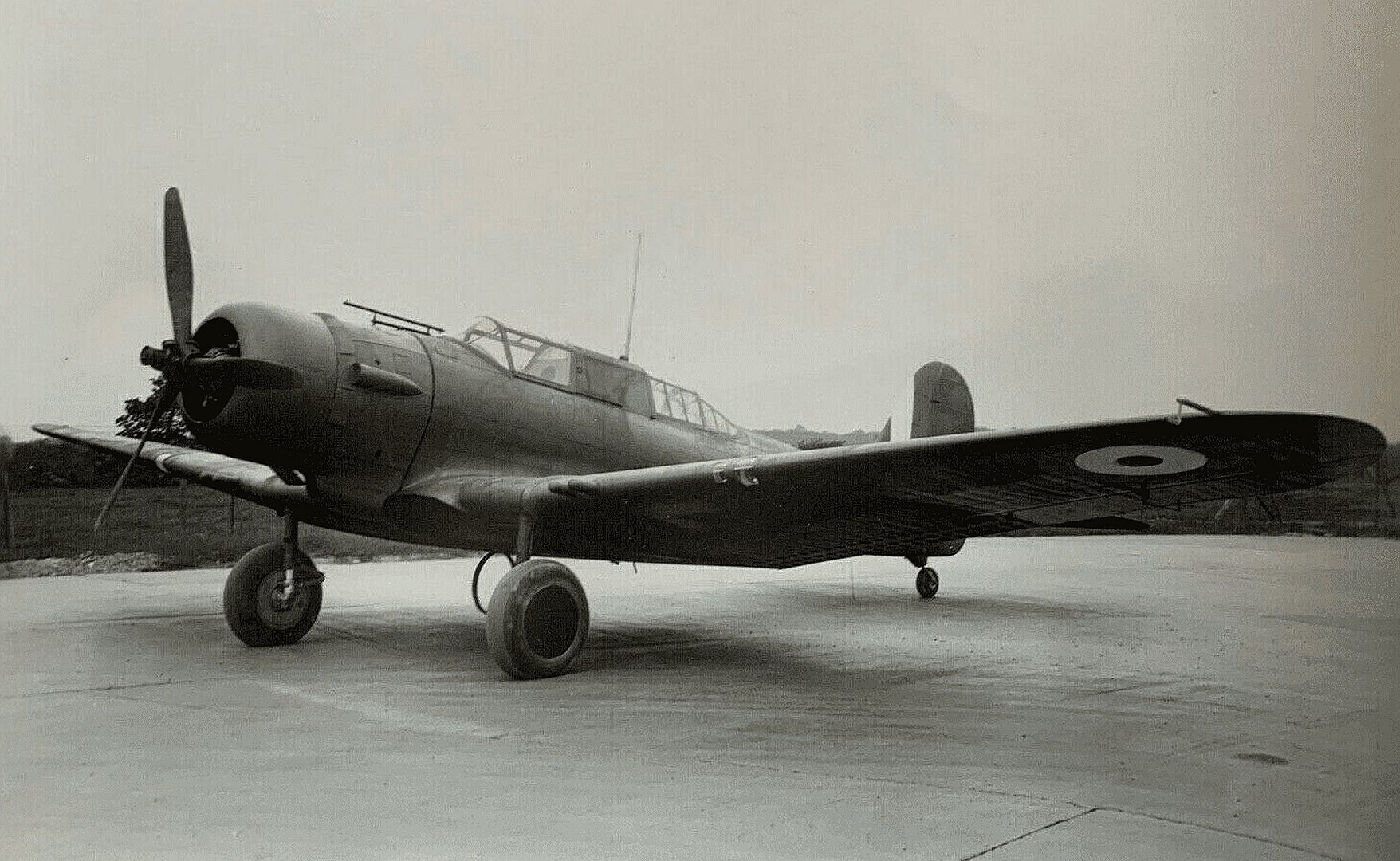
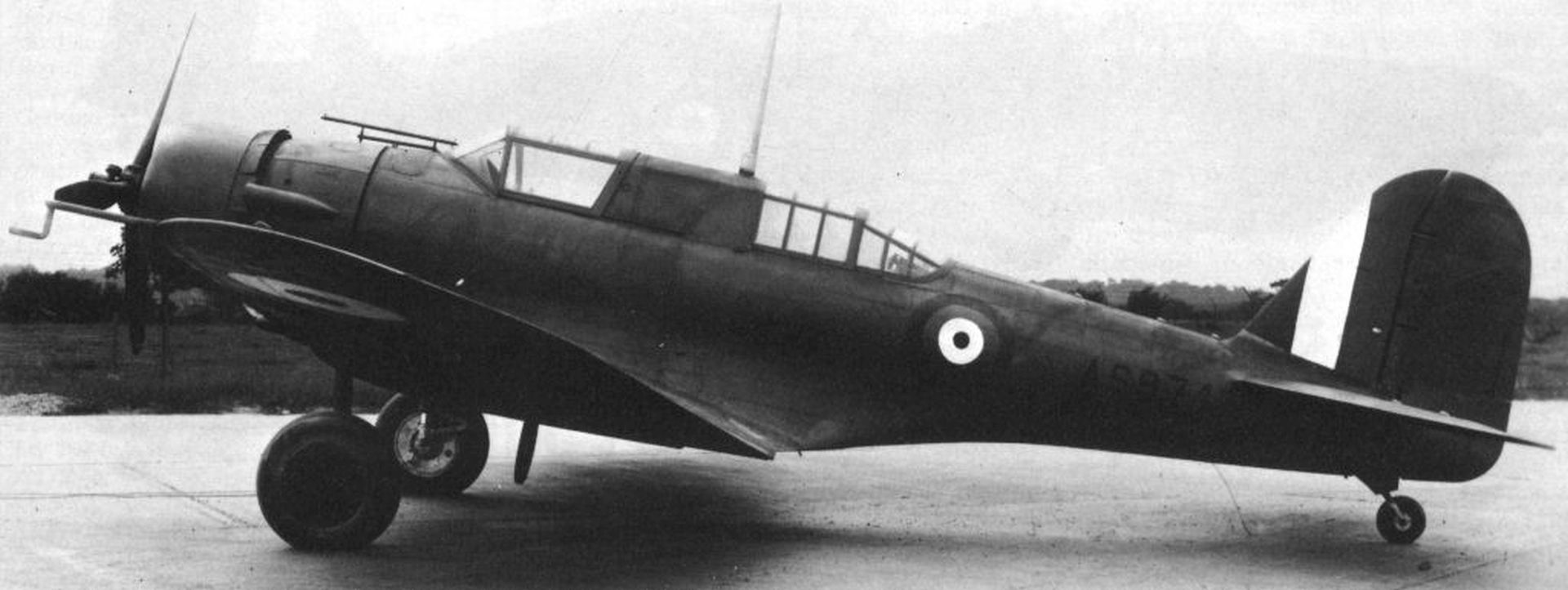
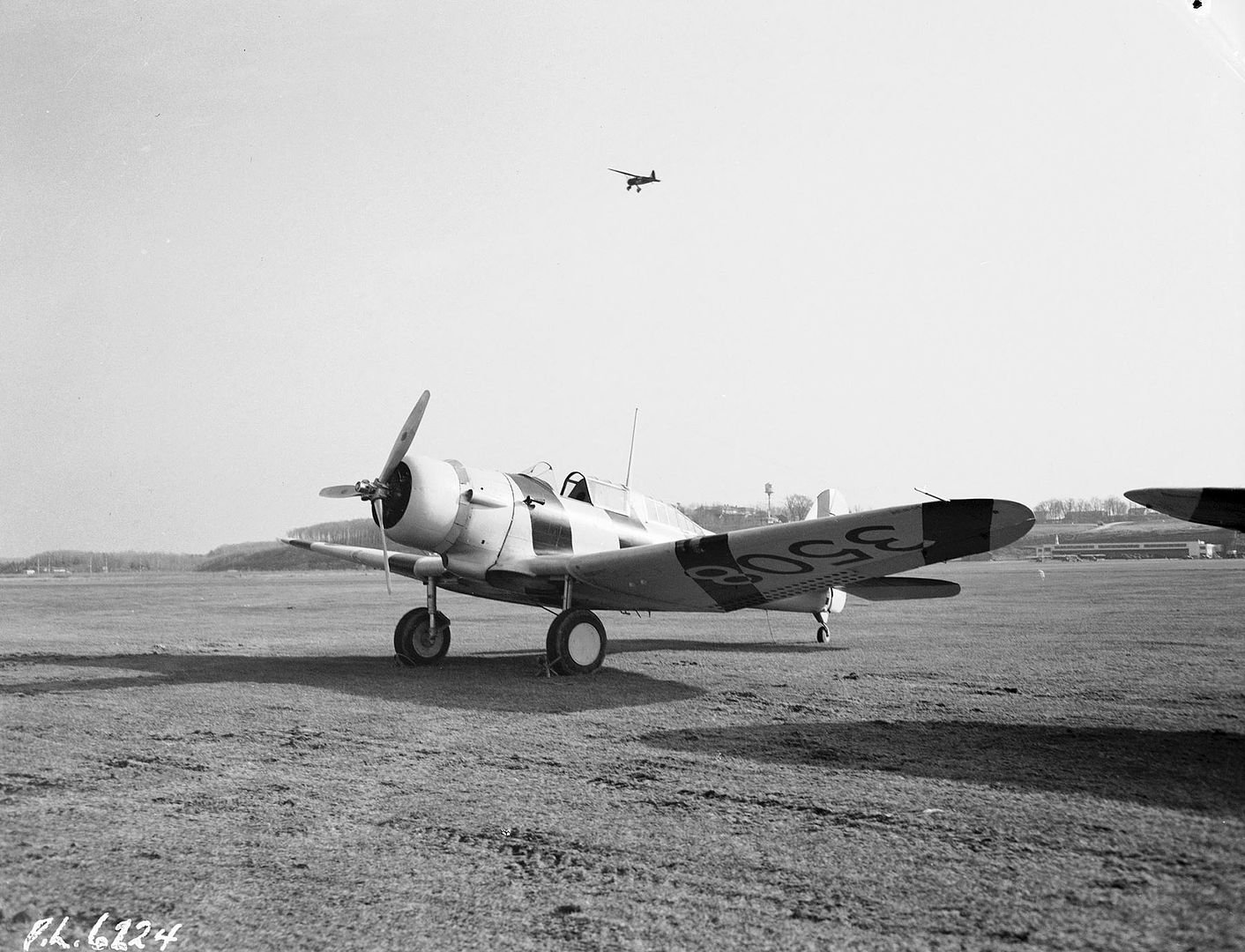
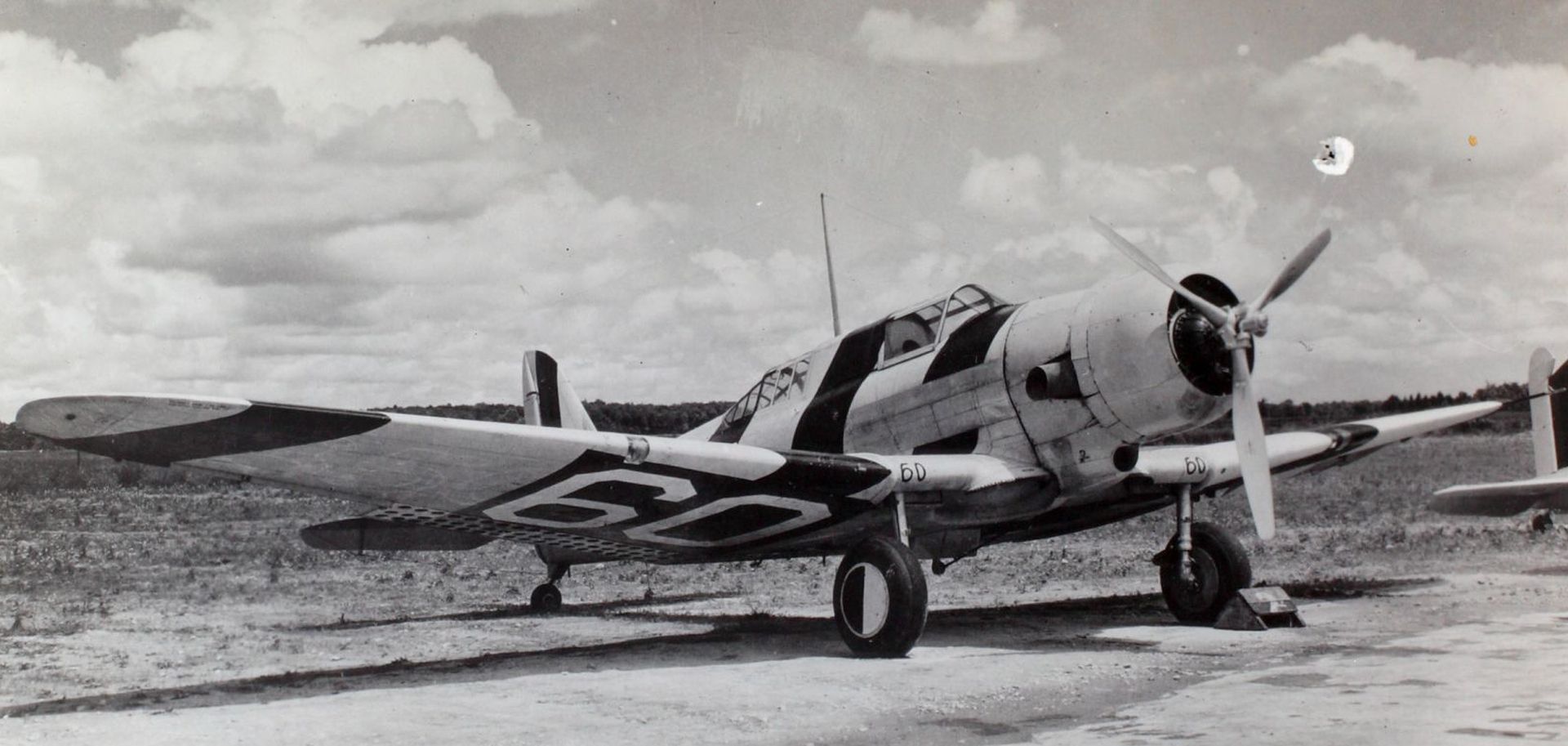
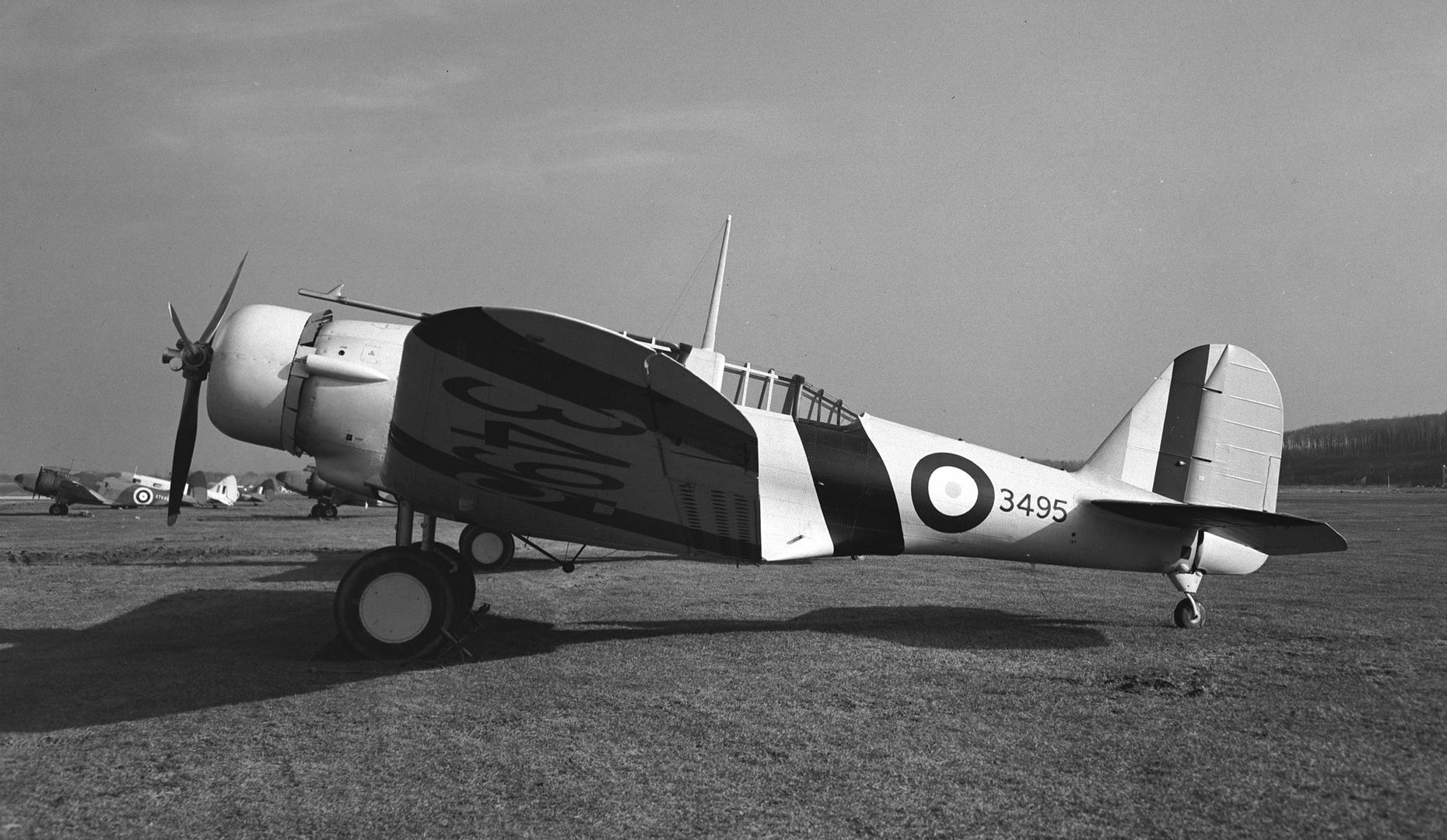
A-17A (36-184) was used by the National Advisory Committee for Aeronautics (NACA) during 1939 to test new types of engine cowlings. Initially, the aircraft was fitted with a large propeller spinner which completely covered the engine front air intake. Large ducts were built into the wing roots to provide air for engine cooling. However, before flight testing could begin ground tests indicated that the engine temperature rose too high and NACA decided not to try and fly the aircraft in such a configuration.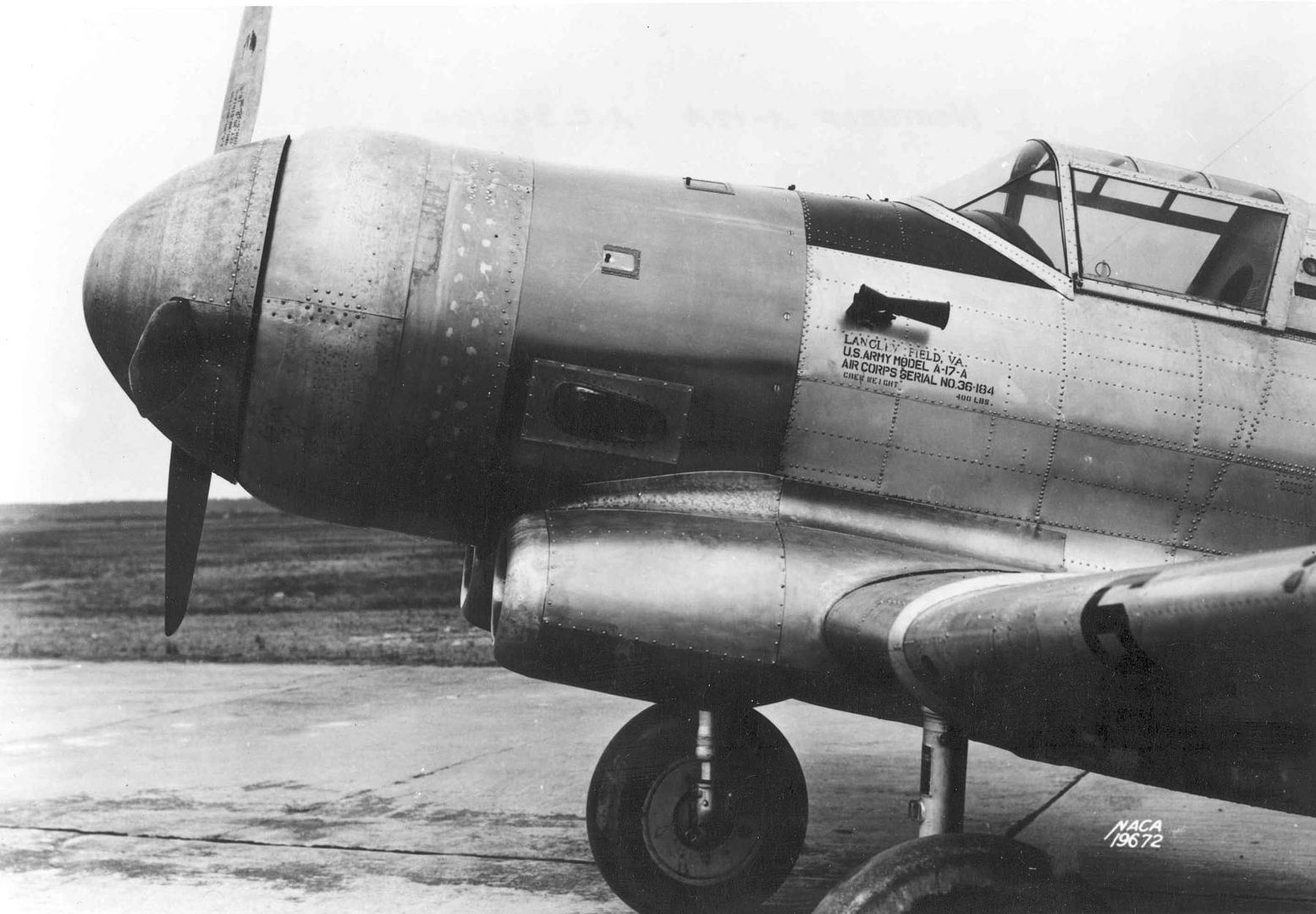

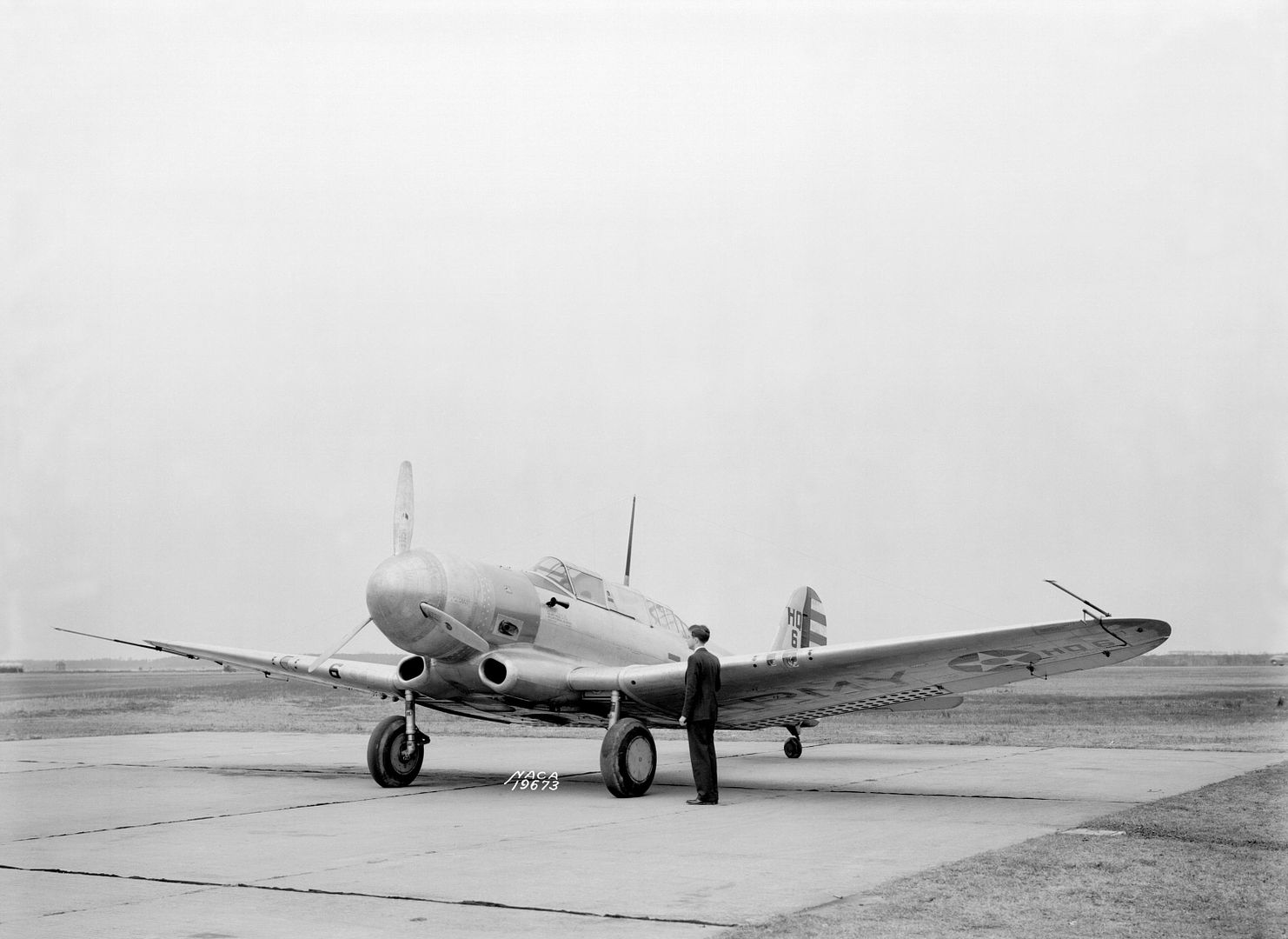
NACA removed the wing ducts and replaced the oversized spinner with a ducted spinner with a large hole in its center that incorporated impeller blades which forced cooling air to the engine. Engine cooling while on the ground was much more effective than the NACA cowling used by the conventional A-17A--the engine could be operated at full throttle on the ground for 15 minutes without cylinder temperatures exceeding their limits. Although there was a slight decrease in speed with the nose blower, the results of the speed tests were considered inconclusive and the project was not pursued any further. 36-184 was de-modded to standard configuration and returned to the Air Corps on June 21, 1940.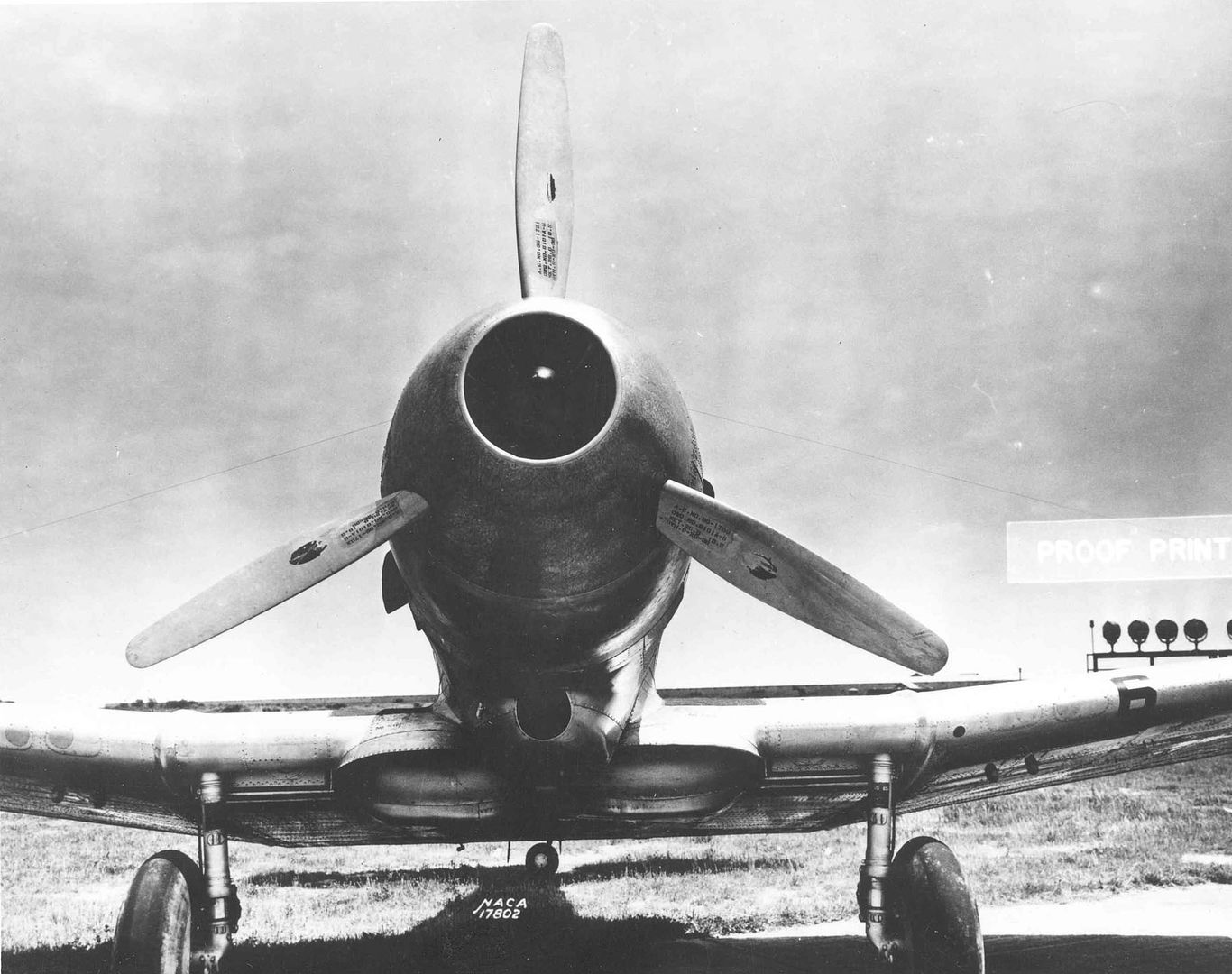
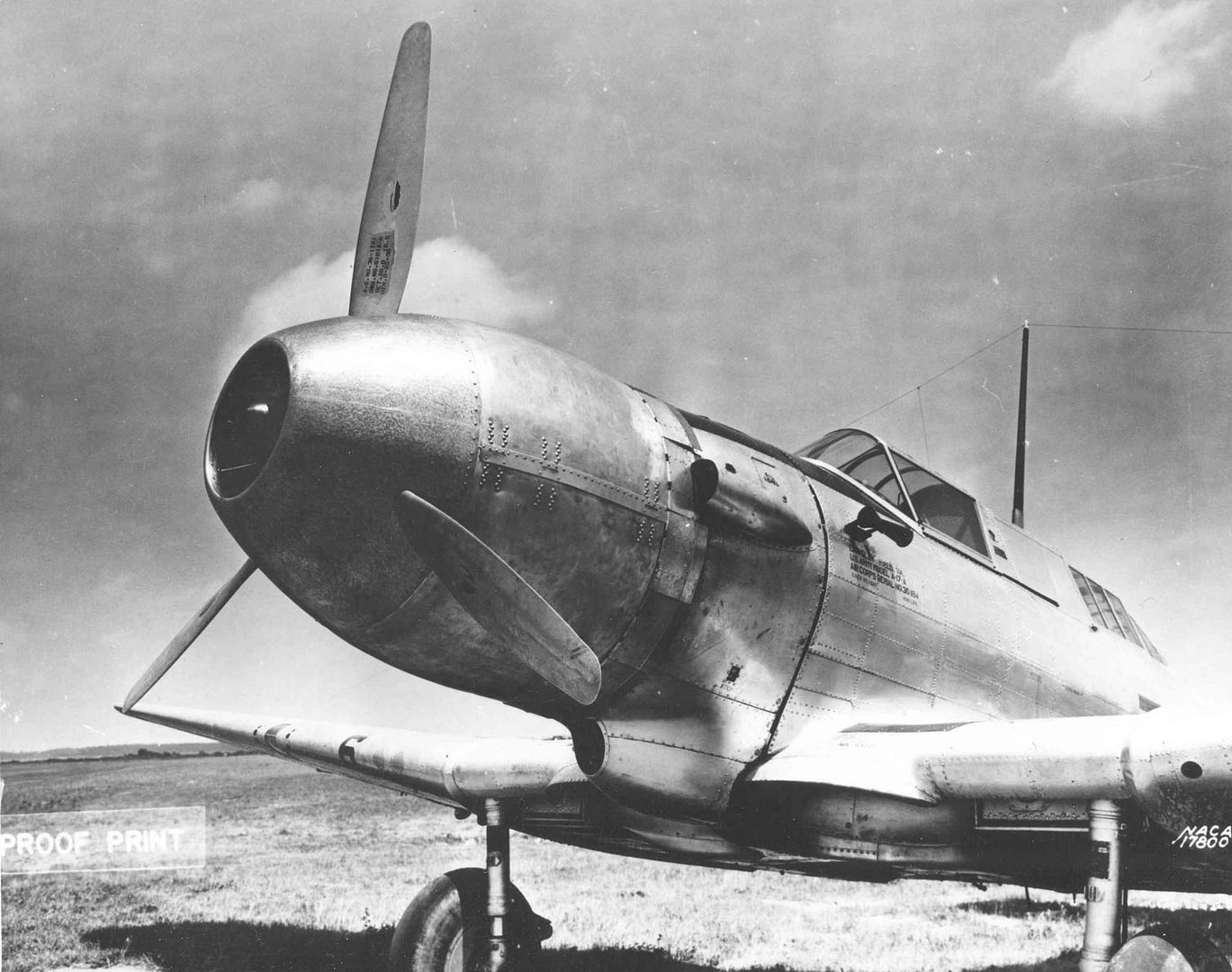
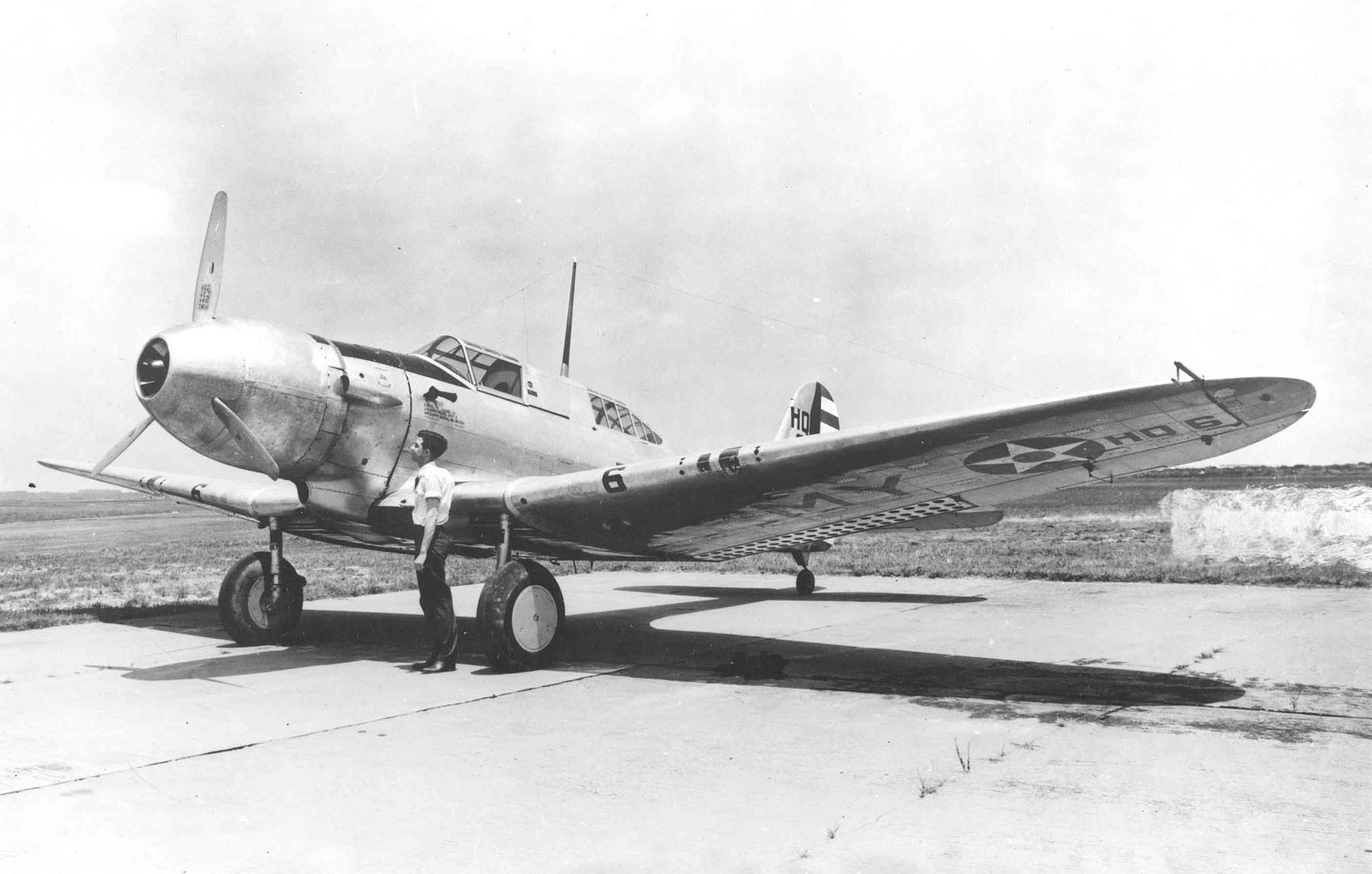
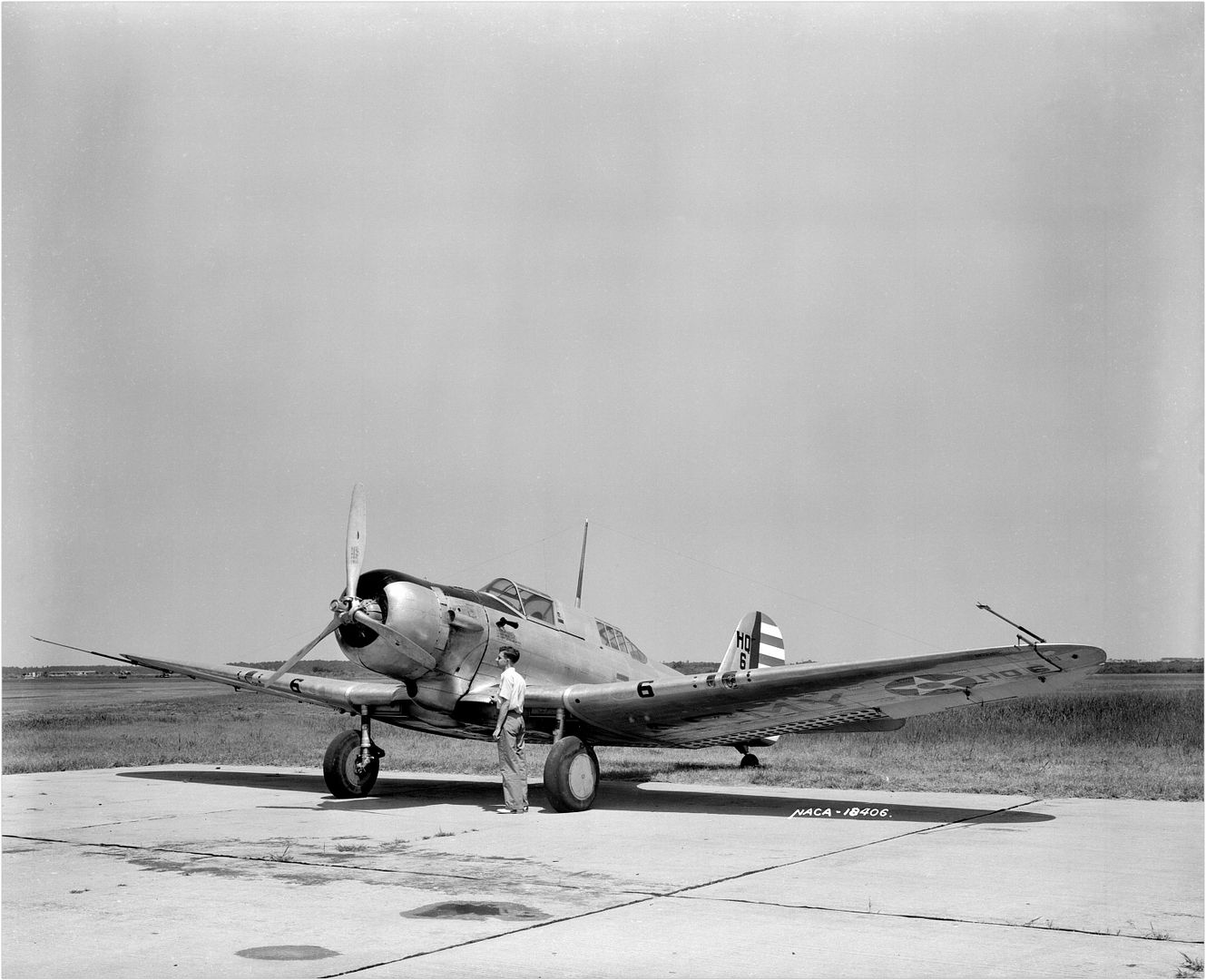
A-17A 35-122 was used by NACA at Langley Field to test several aerodynamic innovations. At first it was used to test new exaust pipes. Later, it was used to test new laminar flow airfoils. The aircraft was eventually returned to the Air Corps.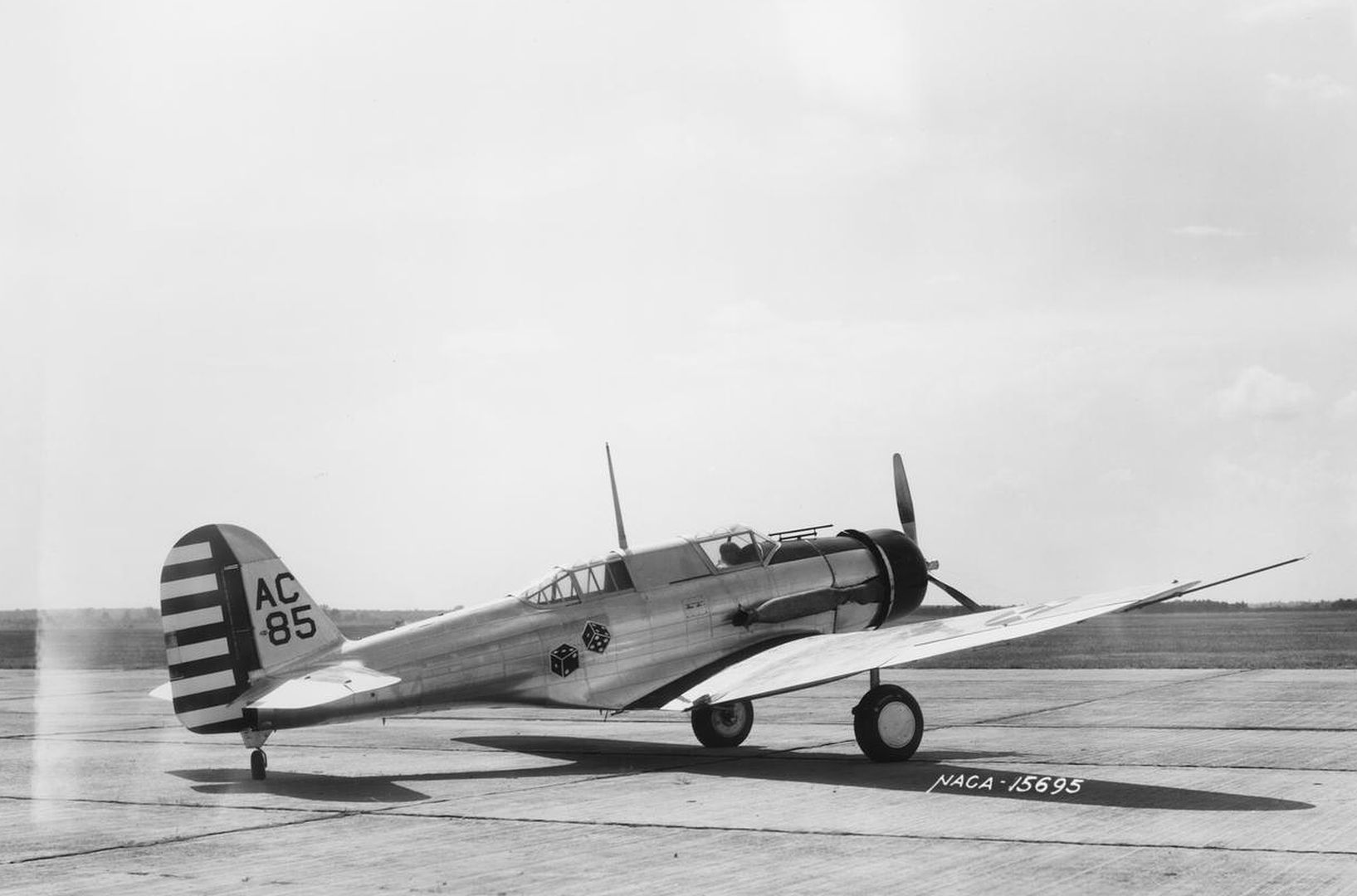
Serials of Northrop A-17A:
36-162/261 Northrop A-17A
c/n 189/288
38-327/355 Northrop A-17A
c/n 381/409
Specification of Northrop A-17A:
Engine: One Pratt & Whitney R-1535-13 Twin Wasp Junior fourteen-cylinder air-cooled radial engine, rated at 825 hp at 2500 feet. Performance: Maximum speed 220 mph at sea level. Cruising speed 170 mph. Landing speed 64 mph. Initial climb rate 1350 feet per minute. An altitude of 5000 feet could be reached in 3.9 minutes. Service ceiling 19,400 feet. Normal range 730 miles with 654 pounds of bombs. Maximum range 1195 miles. Dimensions: Wingspan 47 feet 9 inches, Length 31 feet 8 inches, Height 12 feet 0 inches, Wing area 363 square feet. Weights: 5106 pounds empty, 7550 pounds loaded. Armament: Four wing-mounted 0.30-inch machine guns, plus one flexible 0.30-inch machine gun operated by rear cockpit gunner. Normal bombload was four externally-carried 100-lb bombs or 20 30lb anti-personnel bombs carried internally. Maximum bombload was 1200 pounds. -
 Main AdminNorthrop A-17AS
Main AdminNorthrop A-17AS
The A-17AS was a three-seat unarmed staff transport version of the A-17A. The S stood for "Staff" or for "Special". Two examples were ordered on March 20, 1936. Although they bore manufacturer's numbers 289 and 290 which followed those assigned to the first batch of A-17As, they were actually built and delivered before the A-17As.
The first A-17AS (36-349) was powered by a 600 hp direct-drive Pratt & Whitney R-1340-41 nine-cylinder air-cooled radial driving a three-bladed propeller. It was delivered on July 17, 1936. It served as Maj Gen Oscar Westover's personal aircraft. General Westover was the chief of the Army Air Corps, and he personally flew the airplane for more than two years for inspection trips and for attending Army maneuvers. On September 21, 1938, this aircraft crashed at Burbank, California, killing General Westover and his mechanic S/Sgt Sameul Hymes.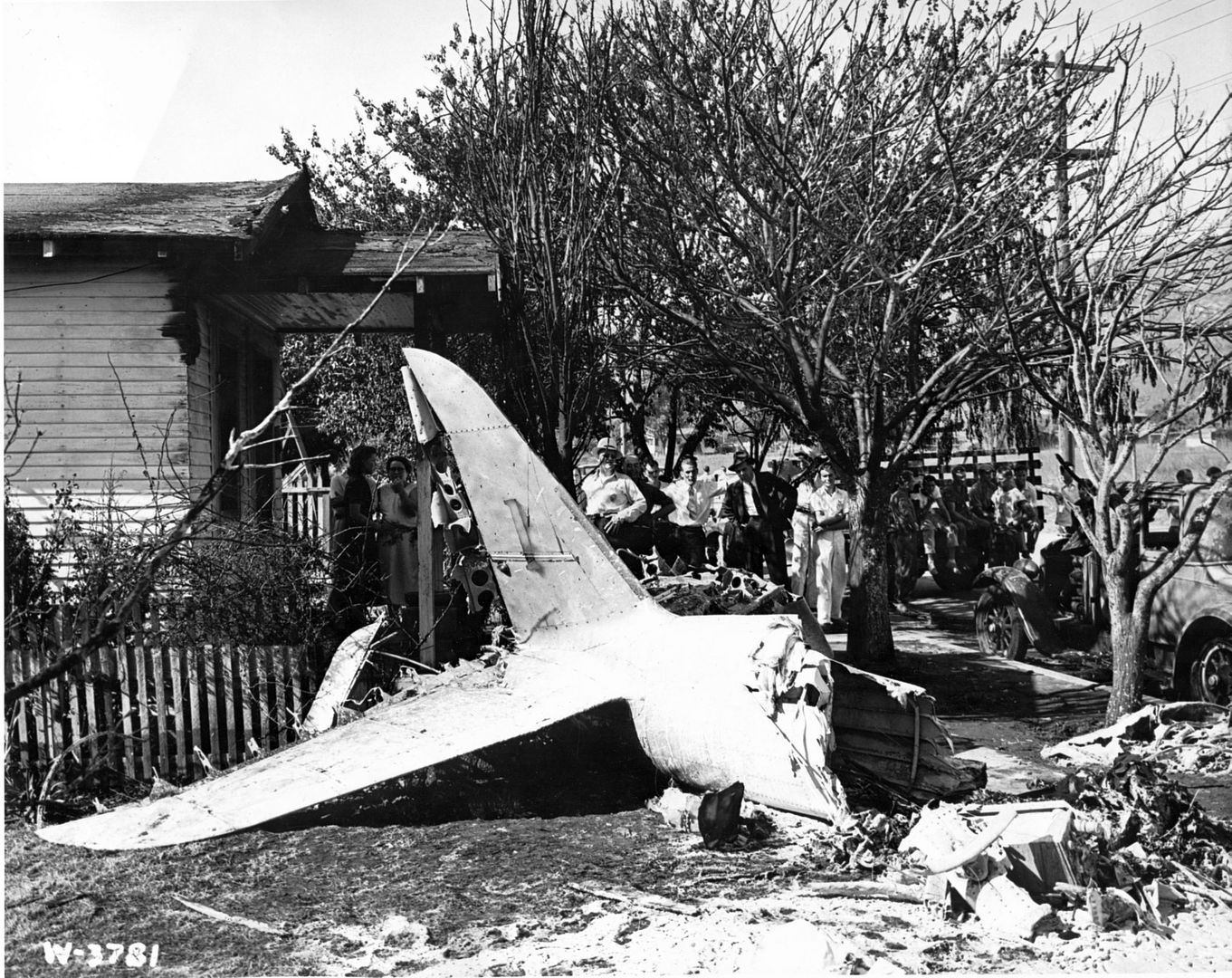
The second A-17AS (36-350) was assigned as Brigadier General Henry H. Arnold's personal transport. Brig Gen Following the death of General Westover, General Arnold was named as his successor as Air Corps chief, and he remained so throughout the Second World War. The second A-17AS was powered by a 600 hp geared R-1340-45 radial driving a two-bladed propeller. 36-350 was lost in an accident on March 2, 1940, but Arnold was not on board that day.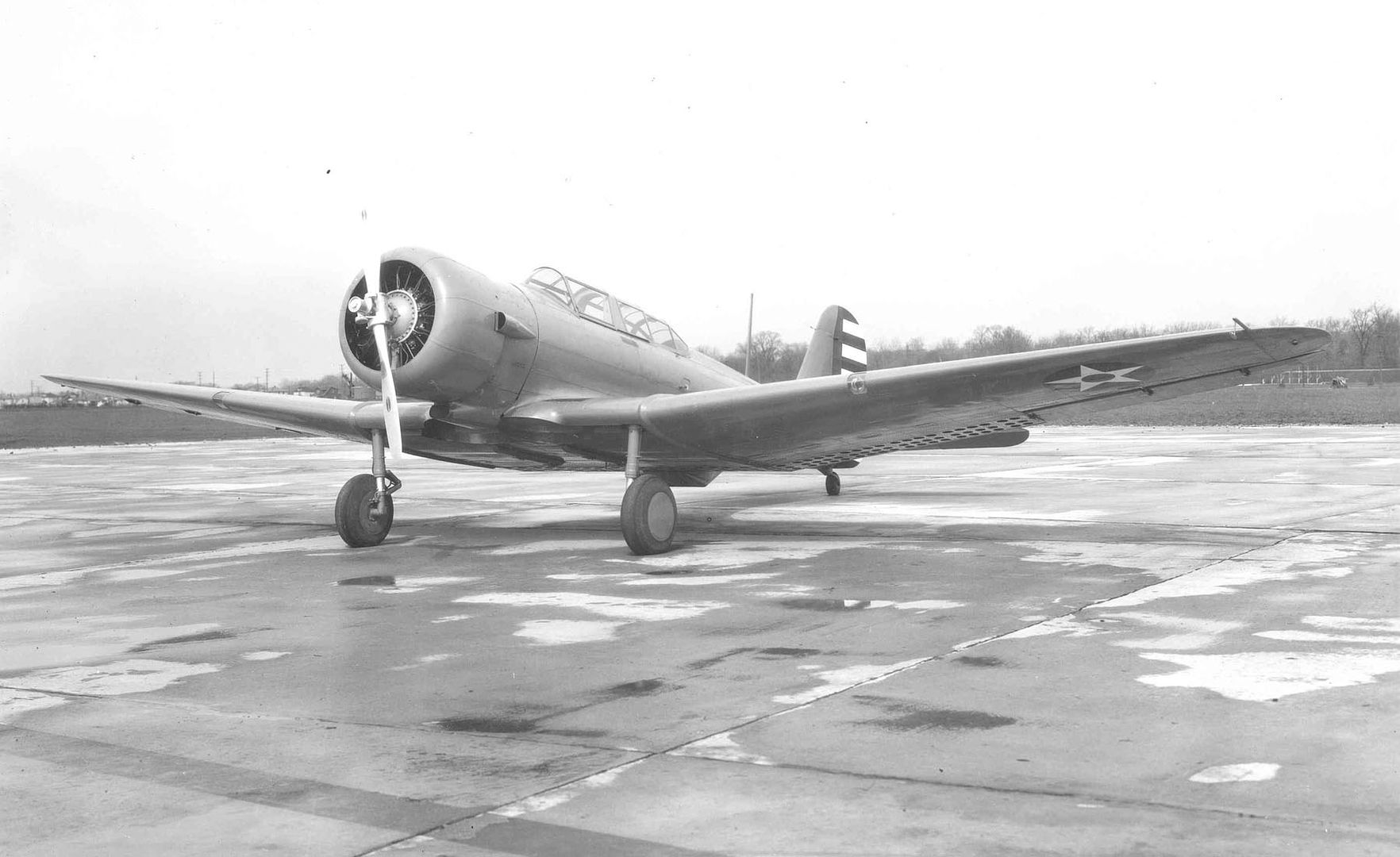
-
9 years agoWed May 07 2025, 07:11pmDuggy
 Main AdminDouglas DB-8A for Sweden
Main AdminDouglas DB-8A for Sweden
Spurred by the success of the A-17 series of US Army attack planes, the Northrop company developed a number of export versions of the A-17 for sales to overseas customers. These were initially known as the Northrop Model 8, but by the time that they were produced Jack Northrop had left the division that bore his name to strike out on his own once again. The Northrop branch was now known simply as the El Segundo Division of Douglas, and consequently these export versions were known as the Douglas 8A or DB-8A, where DB stood for "Douglas Bomber".
The first of these was the Model 8A-1, or DB-8A-1. The Douglas Model 8A-1 was developed for Sweden, which ordered one prototype and parts for a second machine which would act as a pattern aircraft for license production by AB Svenska Jarnvagsverkstaderna (ASJA) of Linkoping. The 8A-1 was generally similar to the fixed-undercarriage A-17, but Sweden opted for the Bristol Mercury as the powerplant, since this engine was already being built under license in Sweden by SFA.
The prototype (company number 378) was powered by a 875 hp Bristol Pegasus XII engine since this engine was generally similar to the Bristol Mercury engine planned for the production version. It was shipped to Sweden on April 22, 1938. The Swedish Flygvapnet designated the aircraft B 5A and assigned it the serial number of 7001. Parts for the second aircraft (company number 410) were shipped on August 8, 1938.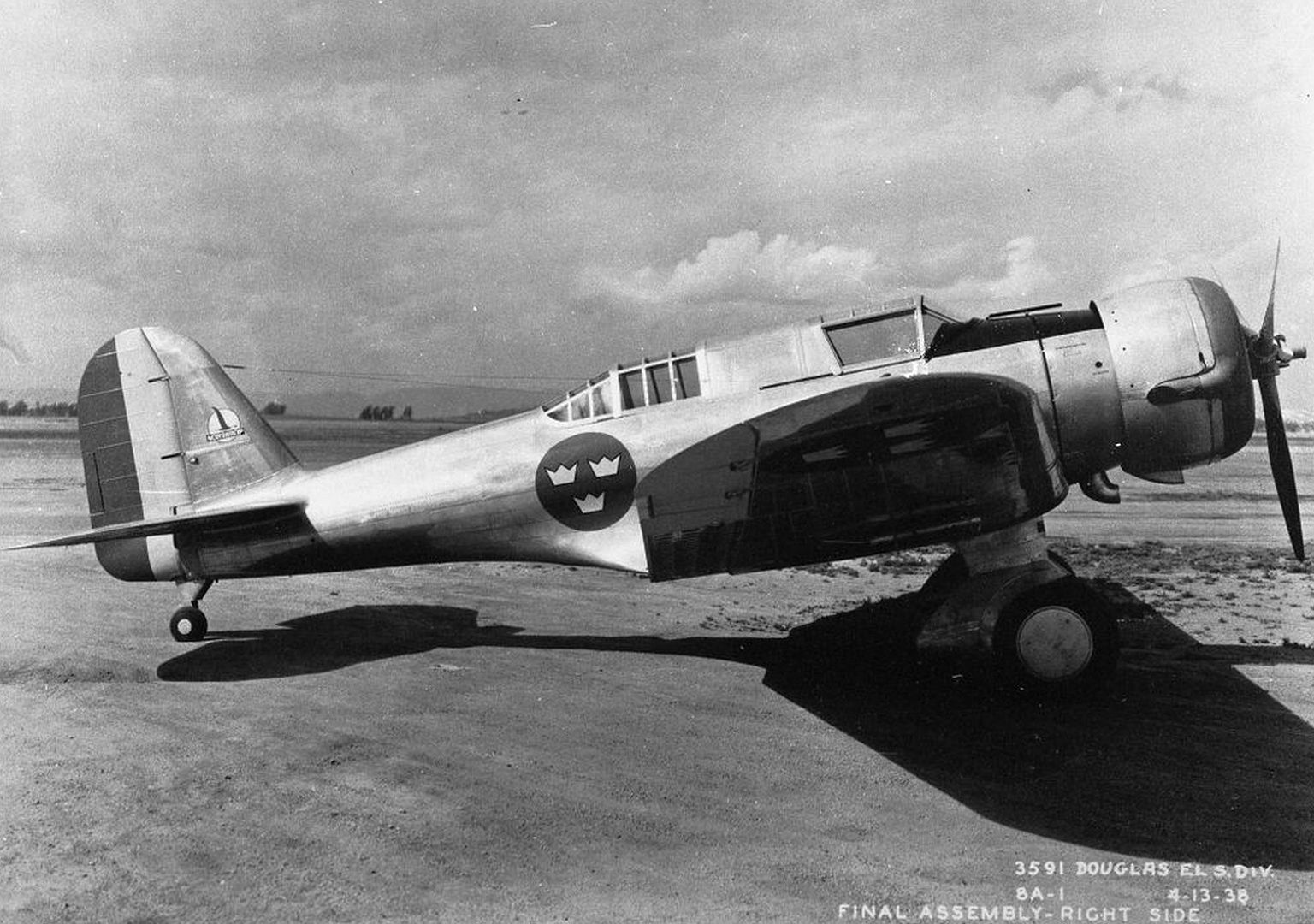

The production version built by ASJA was known as B 5B by the Flygvapnet, and was powered by a 920 hp SFA-built Bristol Mercury XXIV nine-cylinder air-cooled radial. It different from the Northrop-built B 5A in having a domed canopy over the pilot's cockpit and having the radio mast moved from the top of the cockpit canopy to a position just forward of the front canopy. The 64 ASJA-built B 5Bs were delivered in 1940, and were assigned Flygvapnet serials 7002 to 7065.
In 1941, ASJA was succeeded by Svenska Aeroplan AB, or SAAB. SAAB was given a contract for 39 similar B 5Cs (serials 7066 to 7104).
B 5s equipped Flottiljer F 4 at Ostersund and F 12 at Kalmar until replaced beginning in 1944 by the Swedish-built SAAB B 17 light bomber.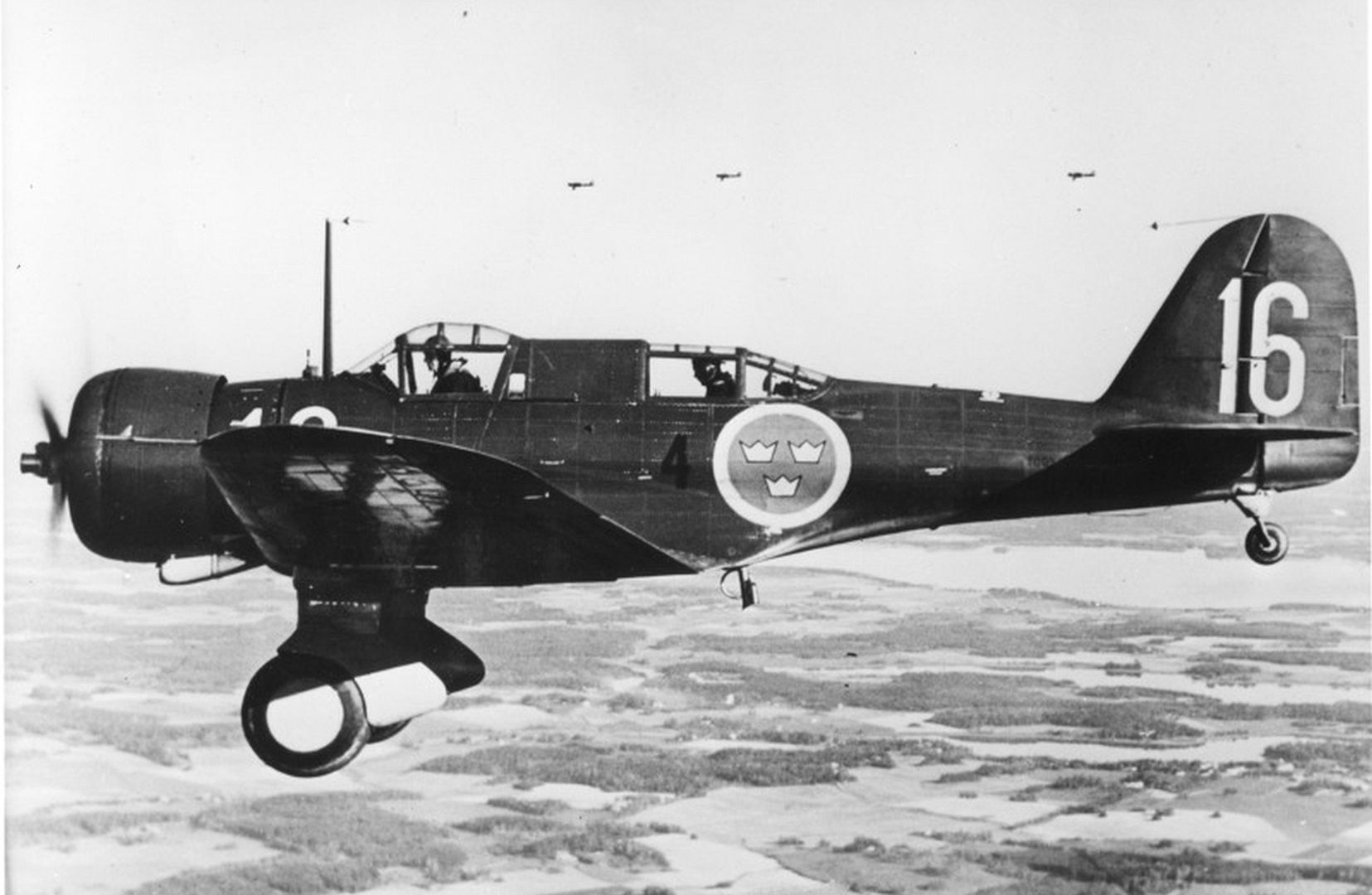









Specification of DB-8A (SAAB B 5C):
Engine: One 980 hp SFA-built Bristol Mercury XXIV nine-cylinder air-cooled radial. Performance: Maximum speed 205 mph at sea level, 219 mph at 6250 feet. Cruising speed 186 mph. Landing speed 66 mph. Initial climb rate 1430 feet per minute. An altitude of 9845 feet could be attained in 8 minutes. Service ceiling 22,475 feet, Normal range 932 miles, Maximum range 1380 miles. Dimensions: Wingspan 47 feet 9 inches, Length 31 feet 9 7/8 inches, Height 12 feet 4 inches, Wing area 363.2 square feet. Weights: 5368 pounds empty, 7496 pounds loaded. Armament: Four wing-mounted 0.30-inch machine guns, plus one flexible 0.30-inch machine gun operated by rear cockpit gunner. Normal bomb load was typically 20 internally-carried 30-lb bombs and four external 100-lb bombs. Maximum bomb load was 1200 pounds. -
 Main AdminDouglas 8A-2 for Argentina
Main AdminDouglas 8A-2 for Argentina
The Douglas Model 8A-2 was an export version of the fixed-undercarriage A-17 intended for the Fuerza Aerea Argentina. Test pilot Eddie Allen had demonstrated the Northrop Model 5B in Buenos Aires in 1935, and 30 Model 8A-2s were ordered. They were built and shipped to Argentina in 1938.
The Model 8A-2 was powered by the 840 hp Wright R-1820-G3 radial, and was armed with two 12.7 and two 7.6-mm wing-mounted machine guns and one flexible rear-firing 7.6-mm machine gun. The Model 8A-2 was fitted with a partially-retractable bomb-aiming tub underneath the rear cockpit. Company numbers were 348 to 377. FAA serials were A-401 throu A-430 (later O-401 through O-430).
The Model 8A-2s were operated by the Fuerza Aerea Argentina's Regimiento de Ataque No 2, first from El Palomar and then from El Plumerillo. The Model 8A-2s were eventually replaced by the indigenous I.Ae.24 Calquin twin-engined bomber. Surviving examples were transferred to El Palomar, near Buenos Aires, where they were operated as advanced trainers until 1955.
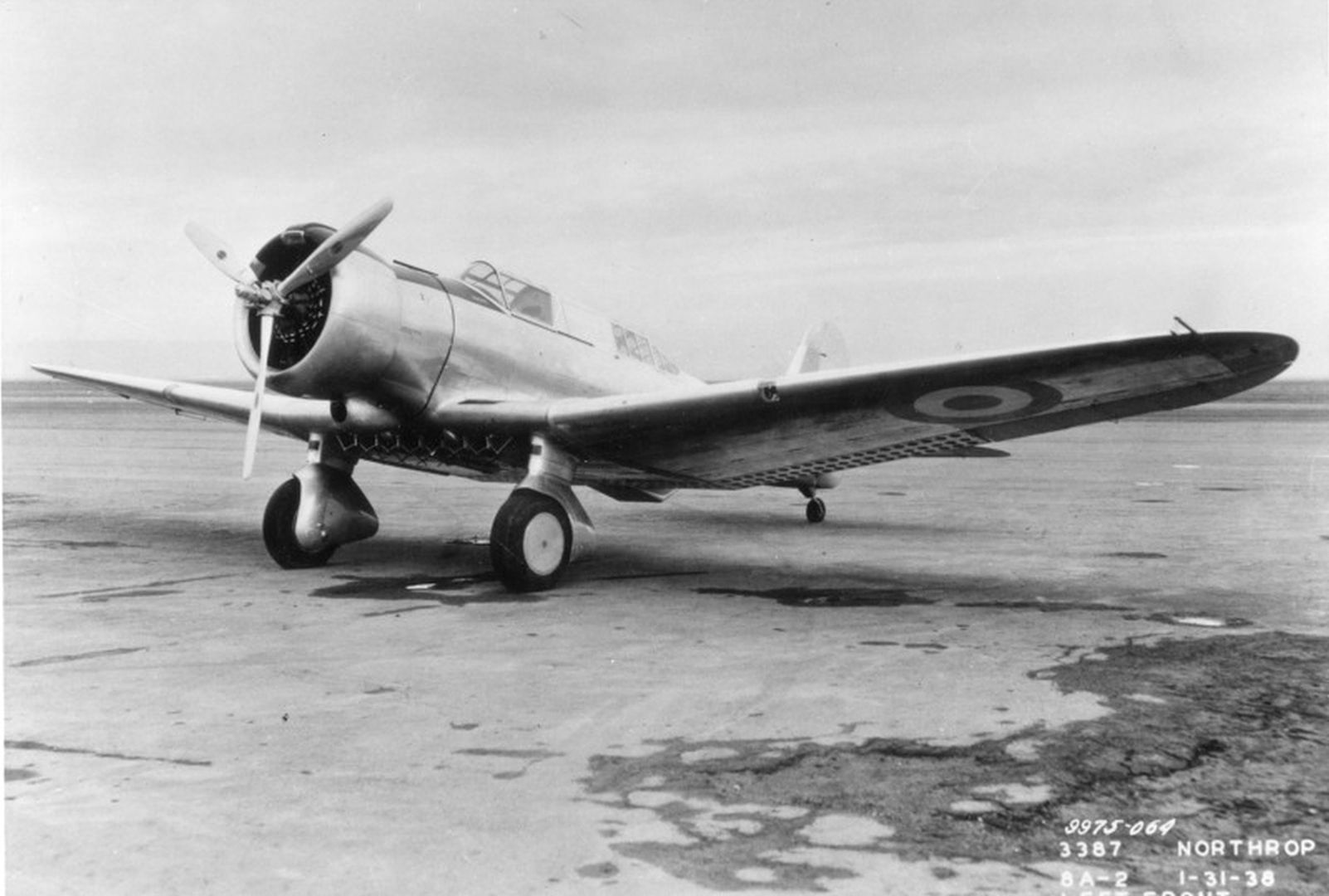

Specification of Douglas DB-8A-2:
Engine: One 840 hp Wright R-1820-G3 air-cooled radial. Performance: Maximum speed 223 mph at 8700 feet. Cruising speed 200 mph. Landing speed 65 mph. Initial climb rate 1300 feet per minute. Service ceiling 25,400 feet. Maximum range 1190 miles. Dimensions: Wingspan 47 feet 9 inches, Length 31 feet 6 inches, Height 12 feet 4 inches, Wing area 363 square feet. Weights: 4899 pounds empty, 7500 pounds loaded. Armament: Two 12.7 and two 7.6-mm wing-mounted machine guns and one flexible rear-firing 7.6-mm machine gun. Normal bomb load was 20 internally-carried 30-pound fragmentation bombs and four external 100-pound bombs. Maxim bombload was 1200 pounds. -
 Main AdminDouglas 8A-3P for Peru
Main AdminDouglas 8A-3P for Peru
The Model 8A-3P was an export version of the A-17A for the Cuerpo de Aeronautical del Peru. The Model 8A-3P differed from the USAAC A-17A in being powered by a 1000-hp Wright GR-1820-G103 radial, and was fitted with the partially- retractable bomb-aiming tub that was carried by the Argentine Model 8A-2s.
A total of ten Model 8A-3Ps were built (company numbers 412 to 421). They served with the 31st Escuadron de Ataque y Reconicimemiento. These planes were used during the July 1941 war between Peru and Ecuador. The last Model 8A-3P was finally retired during the late 1950s.

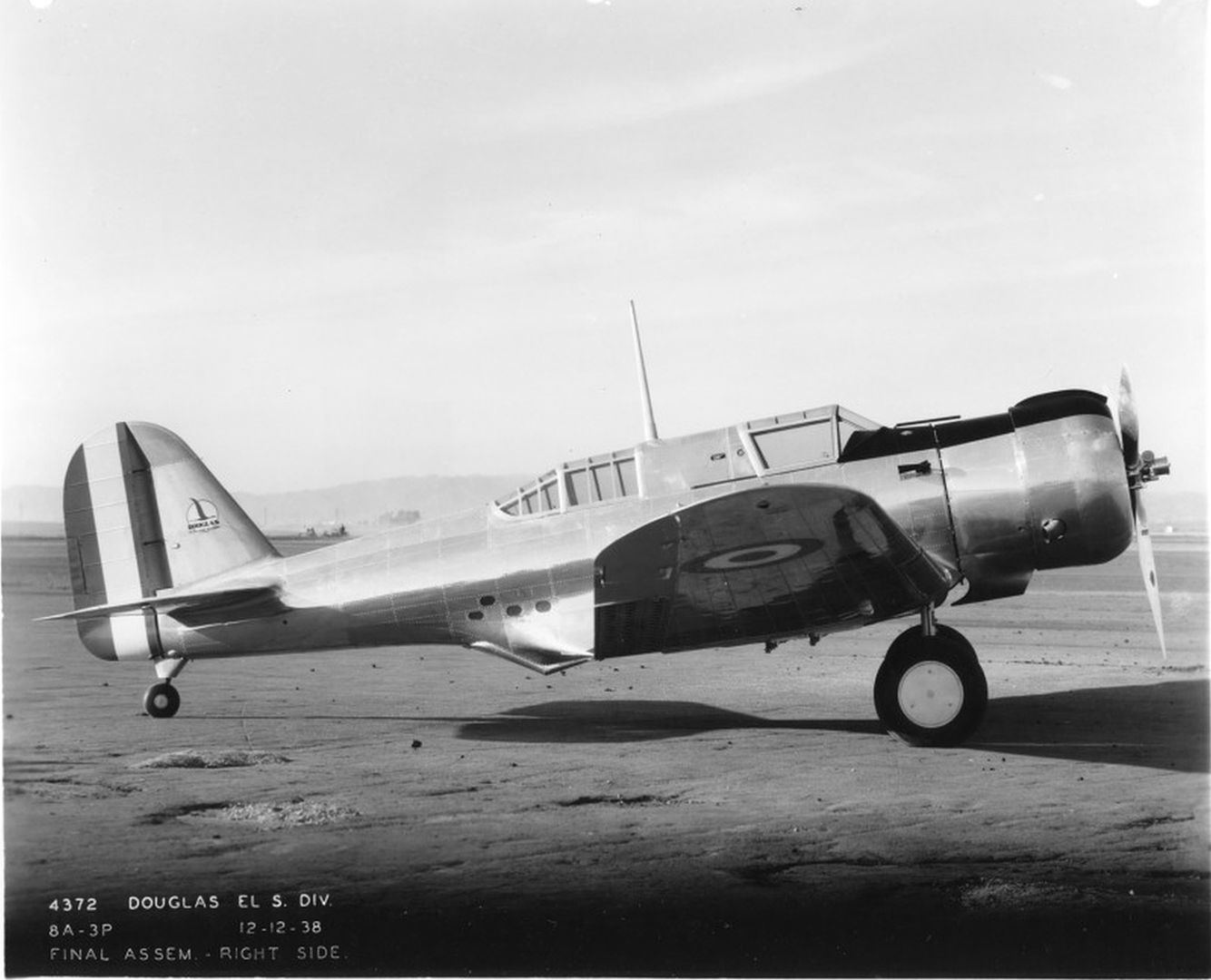
Specification of Douglas DB-8A-3P:
Engine: One 1000-hp Wright GR-1820-G103 air-cooled radial. Performance: Maximum speed 238 mph at 8700 feet, 208 mph at sea level. Landing speed 66 mph. Initial climb rate 1200 feet per minute, Service ceiling 24,000 feet, Maximum range 1180 miles. Dimensions: Wingspan 47 feet 9 inches, Length 32 feet 1 inches, Height 9 feet 9 inches, Wing area 363 square feet. Weights: 4820 pounds empty, 7500 pounds loaded. Armament: Four wing-mounted 0.30-inch machine guns, plus one flexible 0.30-inch machine gun operated by rear cockpit gunner. Normal bomb load included 20 internally-carried 30-pound fragmentation bombs and four externally-carried 100-pound bombs. Maximum bomb load was 1200 pounds. -
 Main AdminDouglas 8A-3N for the Netherlands
Main AdminDouglas 8A-3N for the Netherlands
The Douglas Model 8A-3N was a version of the A-17A built for the Netherlands. It was powered by a 1100 hp Pratt & Whitney Twin Wasp S3C-G. The first example flew on July 31, 1939. A total of 18 were ordered in early 1939. They were delivered between August and November of 1939.
The Model 8A-3Ns bore the company numbers 531/548 and were given the Dutch serial numbers 381/396. They were assigned to the 3rd Fighter Squadron of the 2nd Air Regiment based at Ypenburg. One Model 8A-3N was lost in a prewar accident. On May 10, 1940, when German forces began their Western offensive, twelve DB-8A-3N aircraft were on active duty at Ypenburg, and five were held in reserve at Ockenburg. One of the DB-8A-3Ns was destroyed on the ground during the initial Luftwaffe attack, but the eleven other aircraft were able to get into the air. The DB-8A-3N was not intended as a fighter, and seven of them were quickly shot down by Luftwaffe Bf 110s. However, the Dutch DB-8A-3Ns did manage to shoot down a couple of Ju 52 troop transports. Shortly after landing, the remaining four DB-8A-3Ns were caught on the ground in another German raid and were all destroyed.
The five DB-8A-3Ns in reserve at Ockenburg were captured intact by the Luftwaffe. In 1941 one of the captured planes was put on display in Berlin next to the DO-X. However, later in the war, this plane was destroyed during an Allied air attack.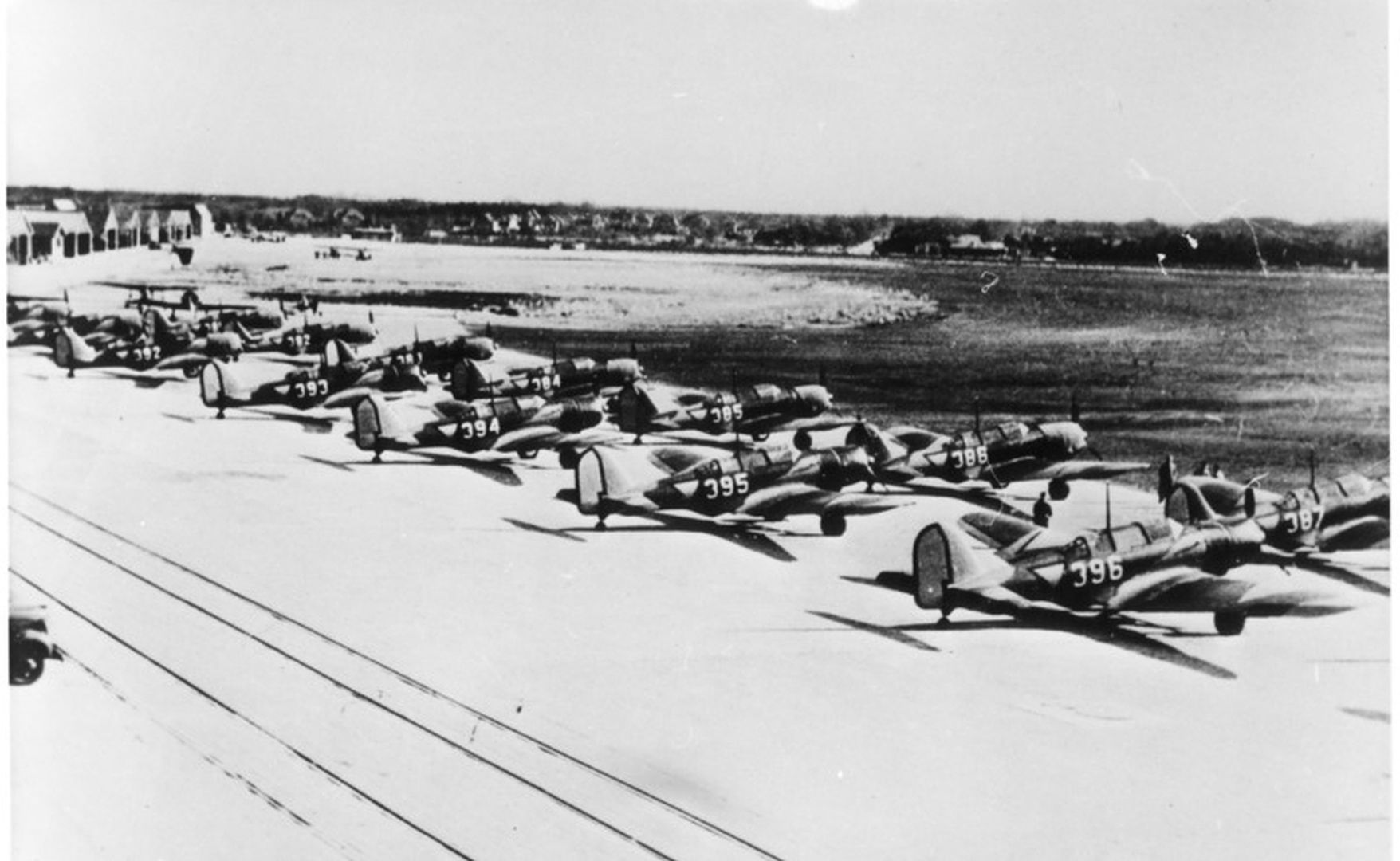
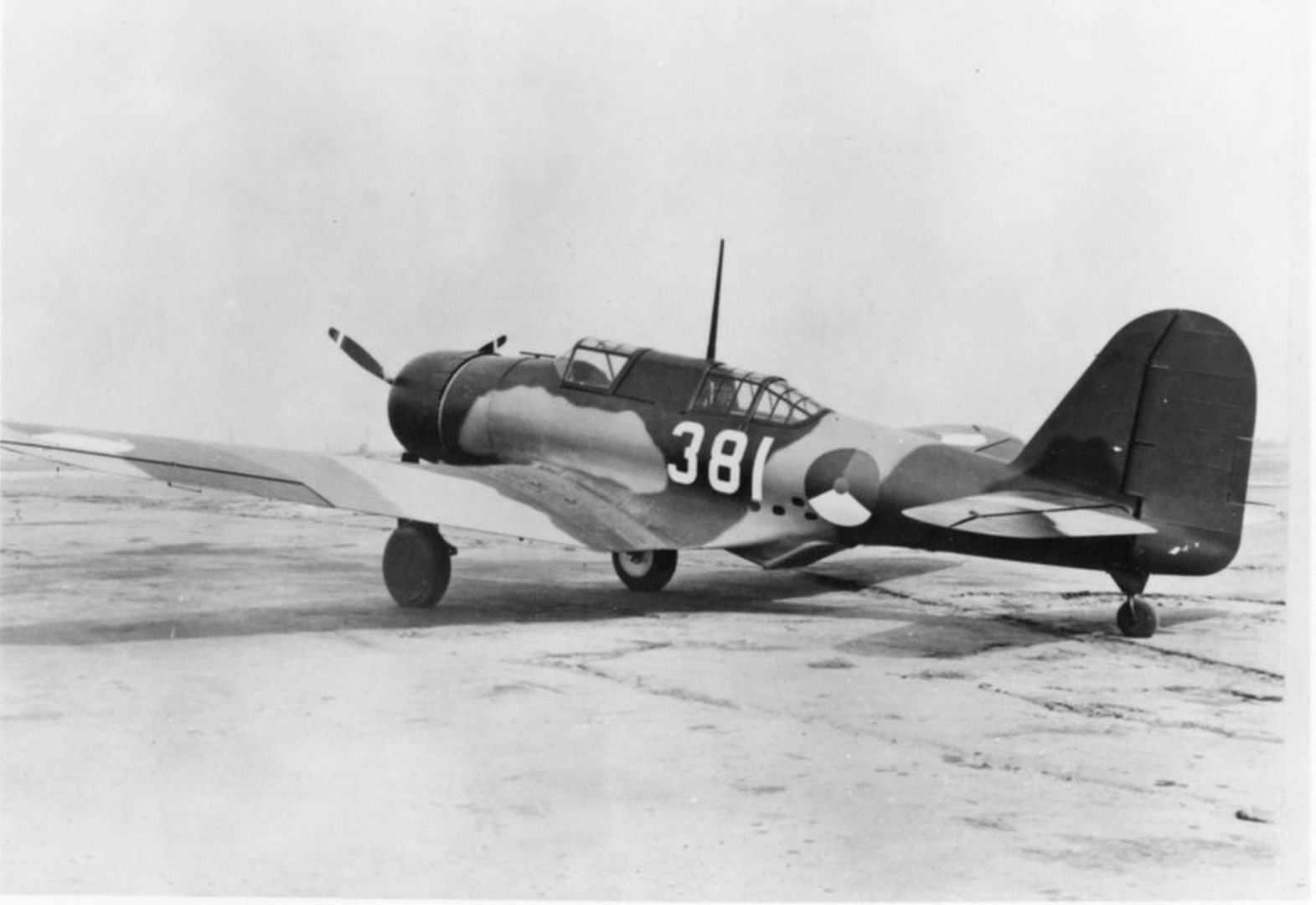
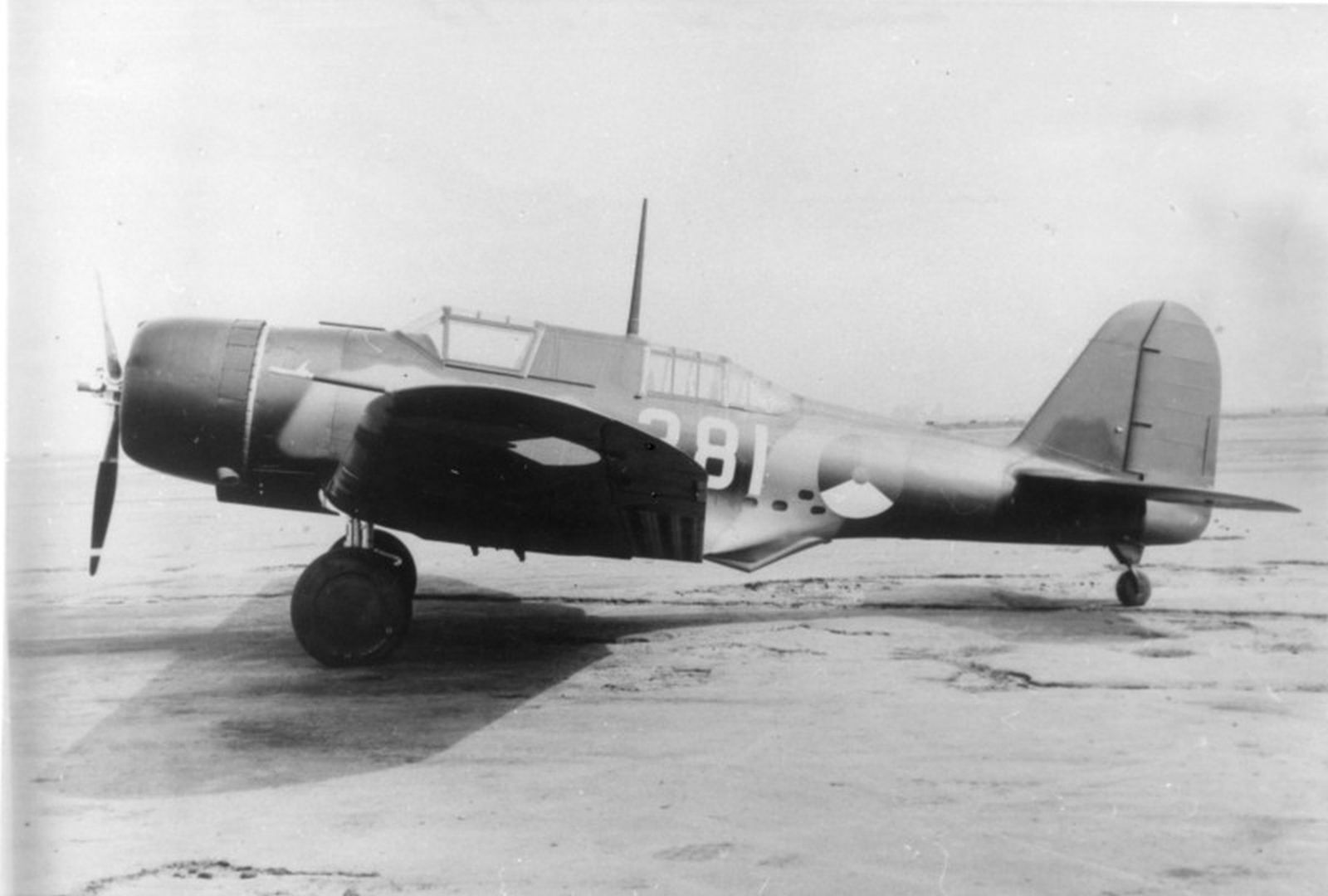

Specification of Douglas DB-8A-3N:
Engine: One Pratt & Whitney R-1830-S3CG Twin Wasp air-cooled radial engine, rated at 1050 hp for takeoff and 900 hp at 12,000 feet. Performance: Maximum speed 260 mph at 12,000 feet. Cruising speed 205 mph. Landing speed 66 mph. Initial climb rate 1430 feet per minute. Service ceiling 29,600 feet, Normal range 910 miles. Dimensions: Wingspan 47 feet 9 inches, Length 32 feet 5 inches, Height 9 feet 9 inches, Wing area 363 square feet. Weights: 5508 pounds empty, 7848 pounds gross, 8948 pounds maximum. Armament: Four wing-mounted 0.30-inch machine guns, plus one flexible 0.30-inch machine gun operated by rear cockpit gunner. Normal bomb load included 20 internally-carried 30-lb bombs and four external 100-lb bombs. Maximum bomb load 1200 pounds. -
 Main AdminDouglas 8A-4 for Iraq
Main AdminDouglas 8A-4 for Iraq
The Model 8A-4 was a version of the A-17A built for the government of Iraq. The 8A-4 was quite similar to the 8A-3P ordered by Peru (including the use of the semi-retractable bomb-aiming tub) and was powered by the 1000 hp Wright GR-1820-G103 Cyclone engine. The company numbers of the fifteen 8A-4s ordered were 613/627. They were shipped to Iraq between April and June of 1940.
All DB-8A-4s were apparently destroyed by the Royal Air Force during the Iraqi uprising which began on May 2, 1941 under Rashid Ali.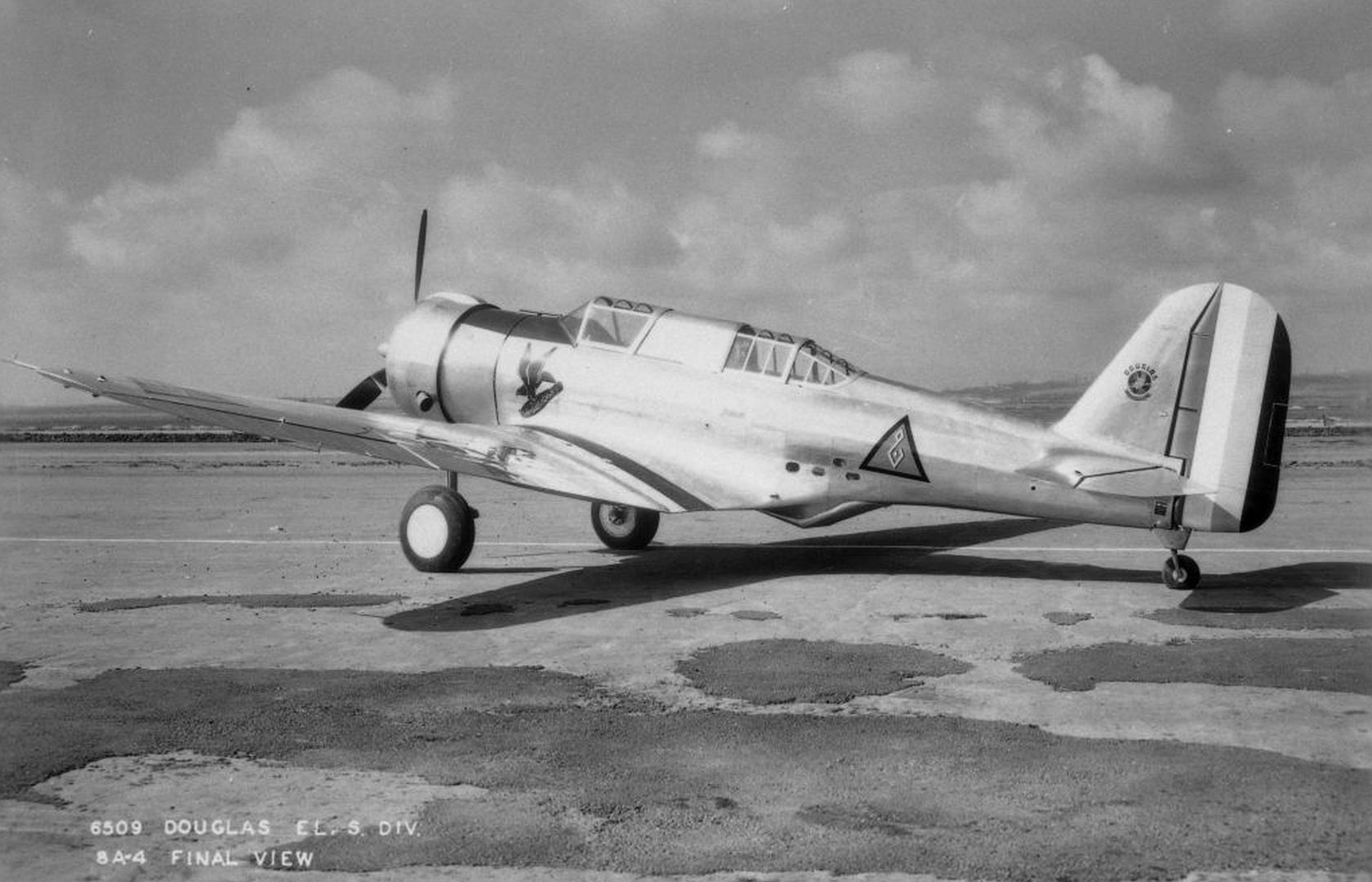
-
9 years agoSun Dec 05 2021, 12:04pmDuggy
 Main AdminDouglas 8A-5 for Norway, A-33
Main AdminDouglas 8A-5 for Norway, A-33
The Model 8A-5 was the last export variant of the A-17A to be built. It was also the most powerful and the most heavily-armed of the entire series of Northrop/Douglas single engined attack bombers.
36 DB-8A-5N aircraft were ordered by Norway early in 1940. They were armed with four wing-mounted 0.30-inch machine guns, one 0.50-inch machine gun in each of two underwing pods just outboard of the main landing gear, and had two flexible 0.30-inch machine guns in the rear cockpit. The engine was the 1200 hp Wright GR-1820-G205A. Up to 1800 pounds of bombs could be carried. RnoAF serials assigned were 301/336.
The Model 8A-5s were intended to be used by the Norwegian Heerens Flyvevaben (Army Flying Service). Unfortunately, before they could be delivered, Norway was occupied by German forces. Nevertheless, the 36 DB-8A-5s (company numbers 715/750) were completed and turned over in late 1940 to the Norwegian government-in-exile which was operating a flight training facility known as "Little Norway" at Island Airport in Ontario, Canada.
Arrangements were later made for the flight training of Norwegian pilots to be carried out in RAF and RCAF schools, and the Model 8A-5s were declared surplus to Norwegian requirements. In August of 1941, Peru offered to purchase 18 of the surviving Norwegian planes, but the US State Department objected because of fears that they might be used against Ecuador. It was proposed that these planes would be delivered instead to the Soviet Union under Lend-Lease, but both Peru and Norway objected. Consequently, these 18 Model 8A-5s were taken over by the USAAF on December 9, 1941 under the designation of A-33-DE. They were assigned the serials 42-13584/13601. They were operated strictly as trainers at stateside airfields and none ever saw any combat.
Eventually, 13 of the surviving Norwegian aircraft were delivered to Peru. USAAF designation of A-33A and serials 42-109007/109019 were assigned for record-keeping purposes. They were delivered to Peru in June of 1943. They supplemented the Douglas 8A-3Ps already serving in Peru. They served with the 31st and then the 23rd Escuadron de Ataque y Reconicimiento de Fotogrametria at Las Palmas. They lasted in service until 1958, when they started to bve replaced by Douglas B-26 Invaders. One of these aircraft is still on display as a gate guard at Las Palmas.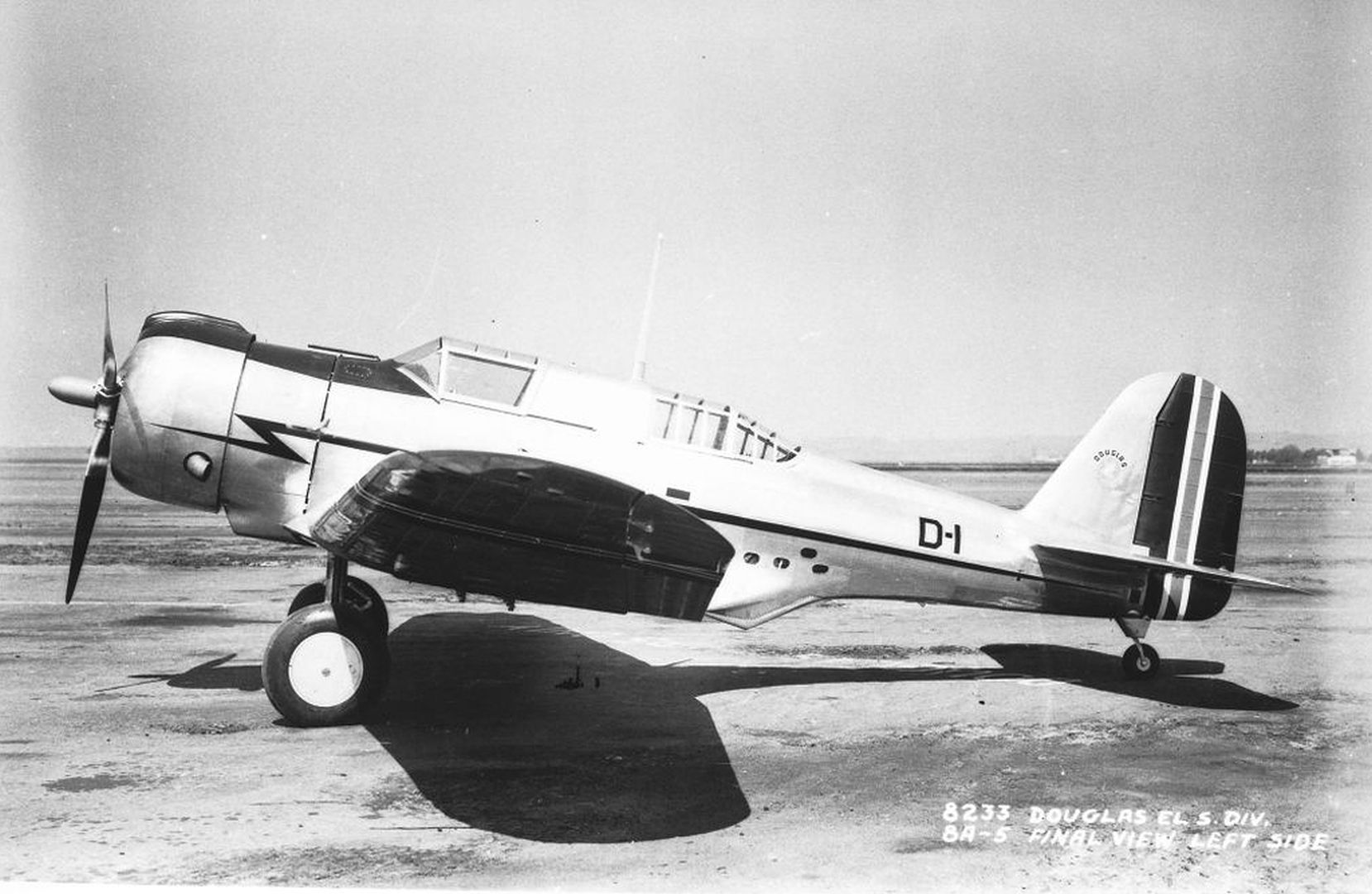
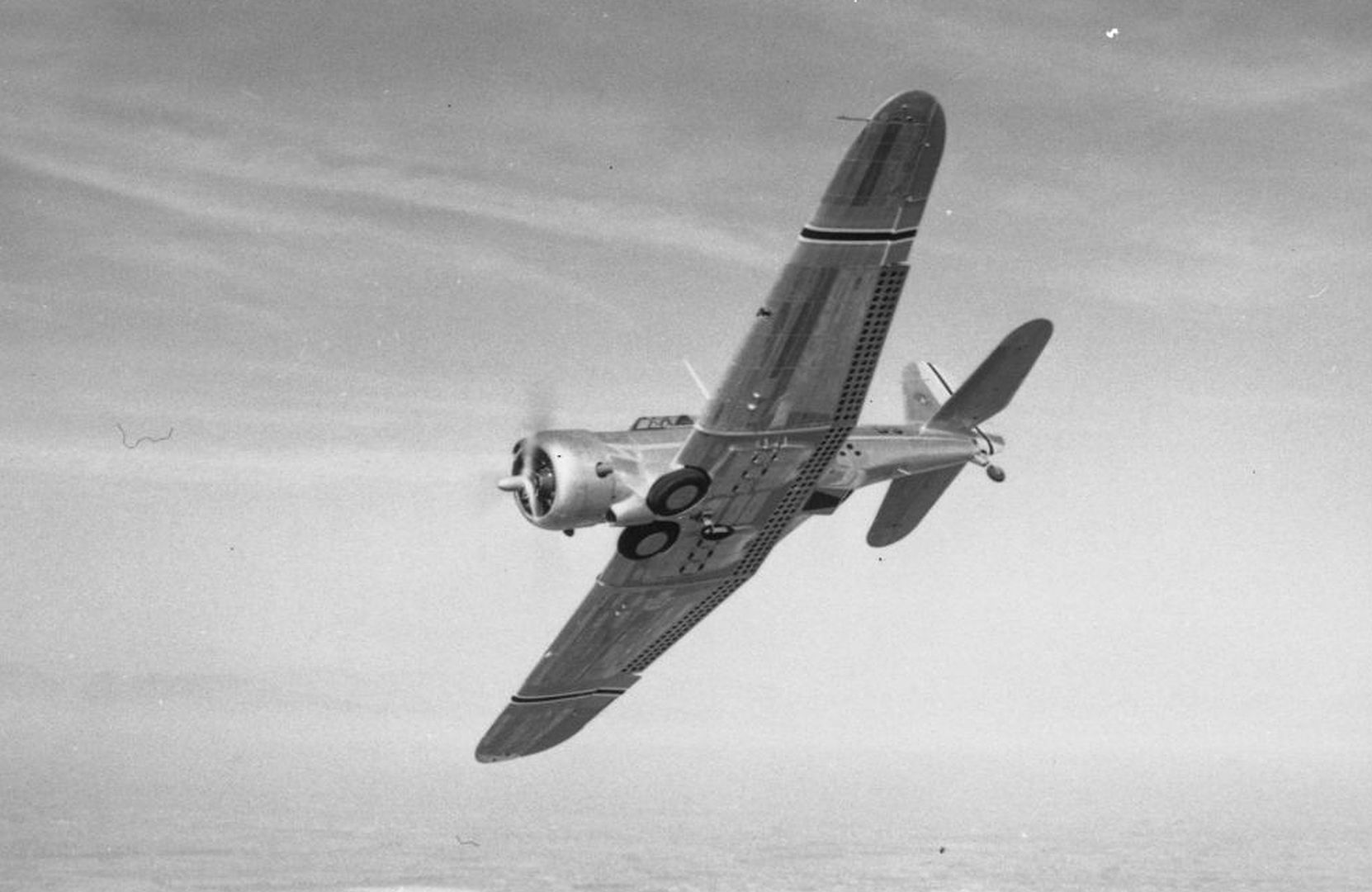
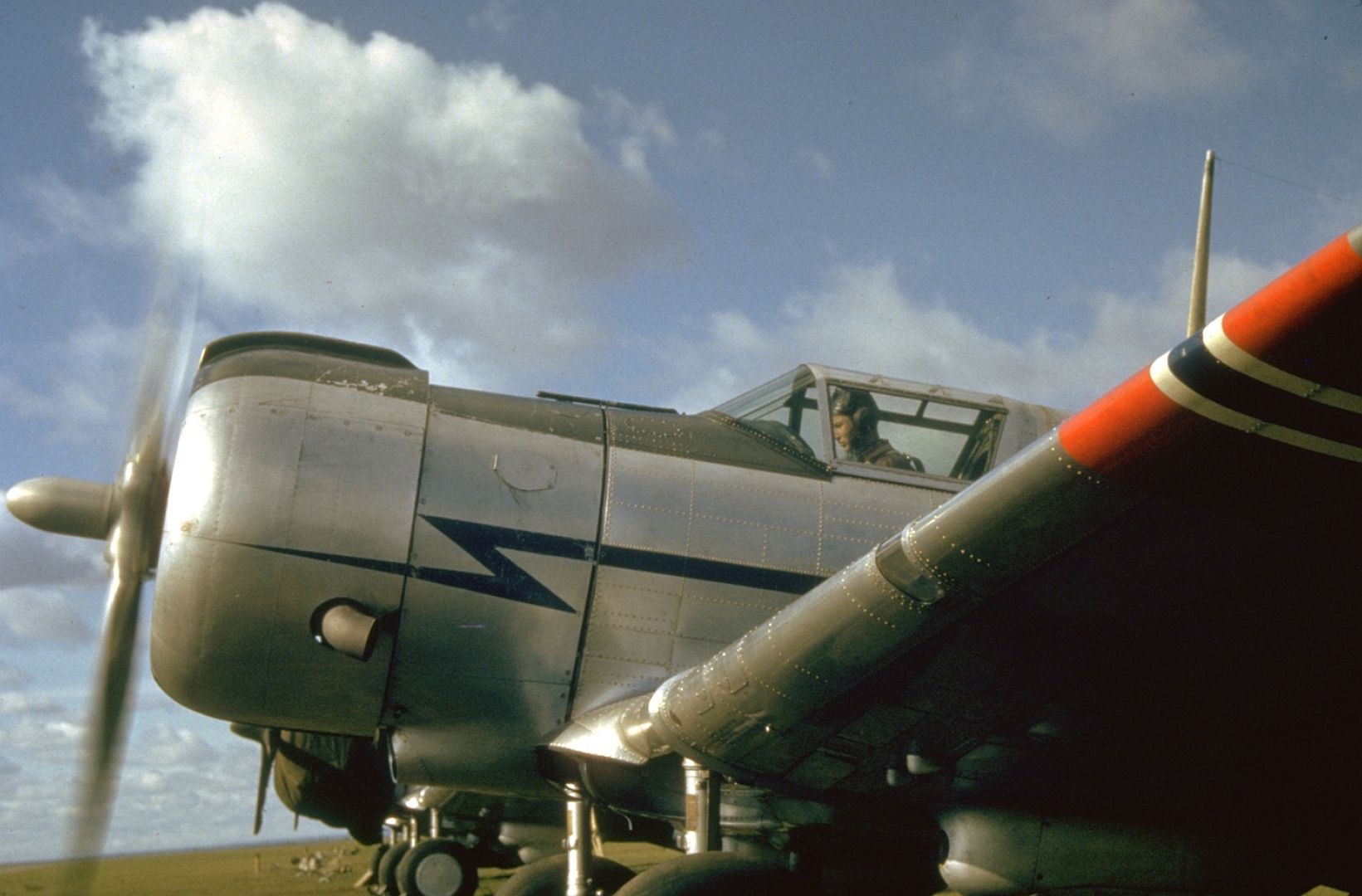
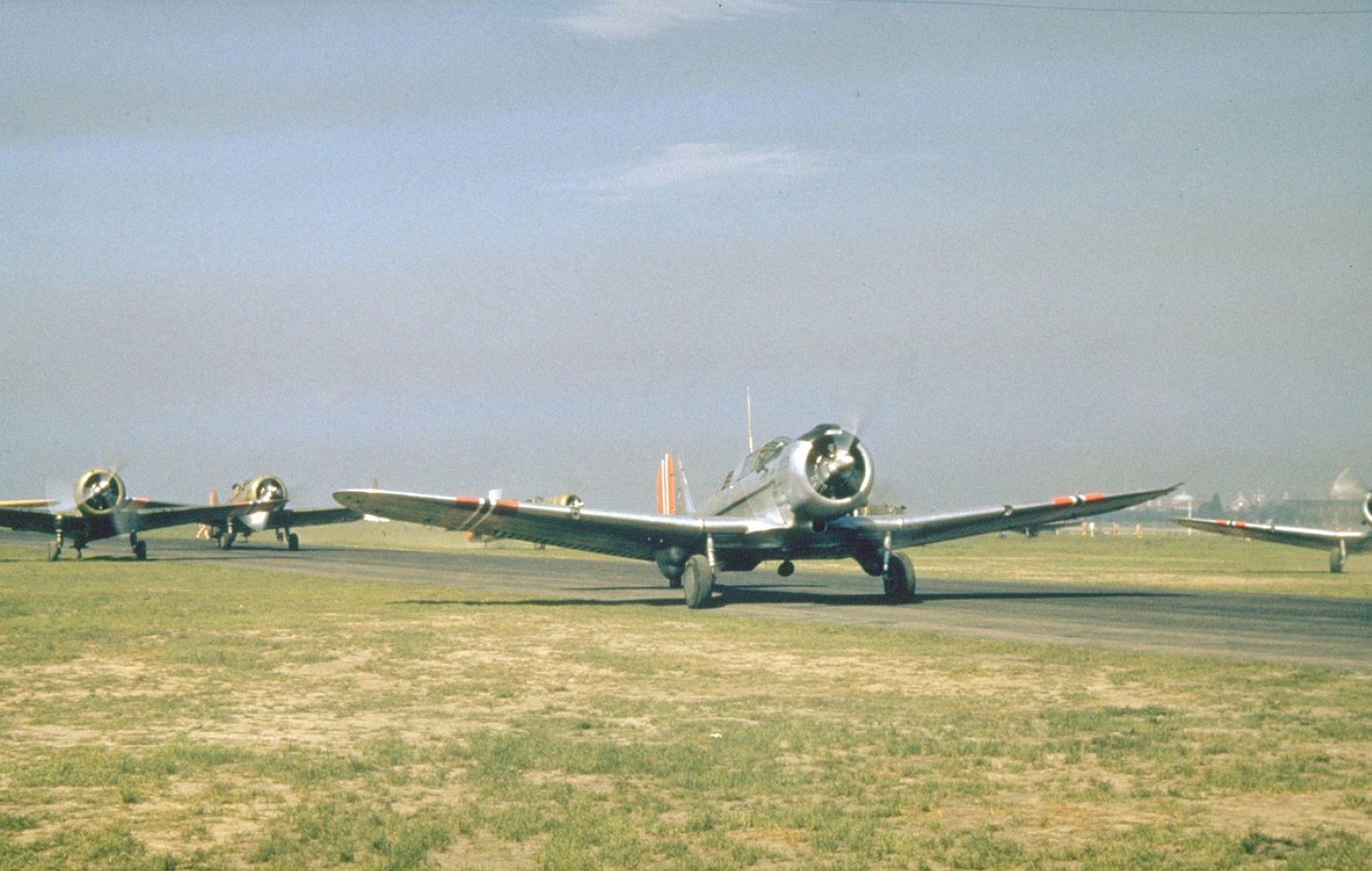
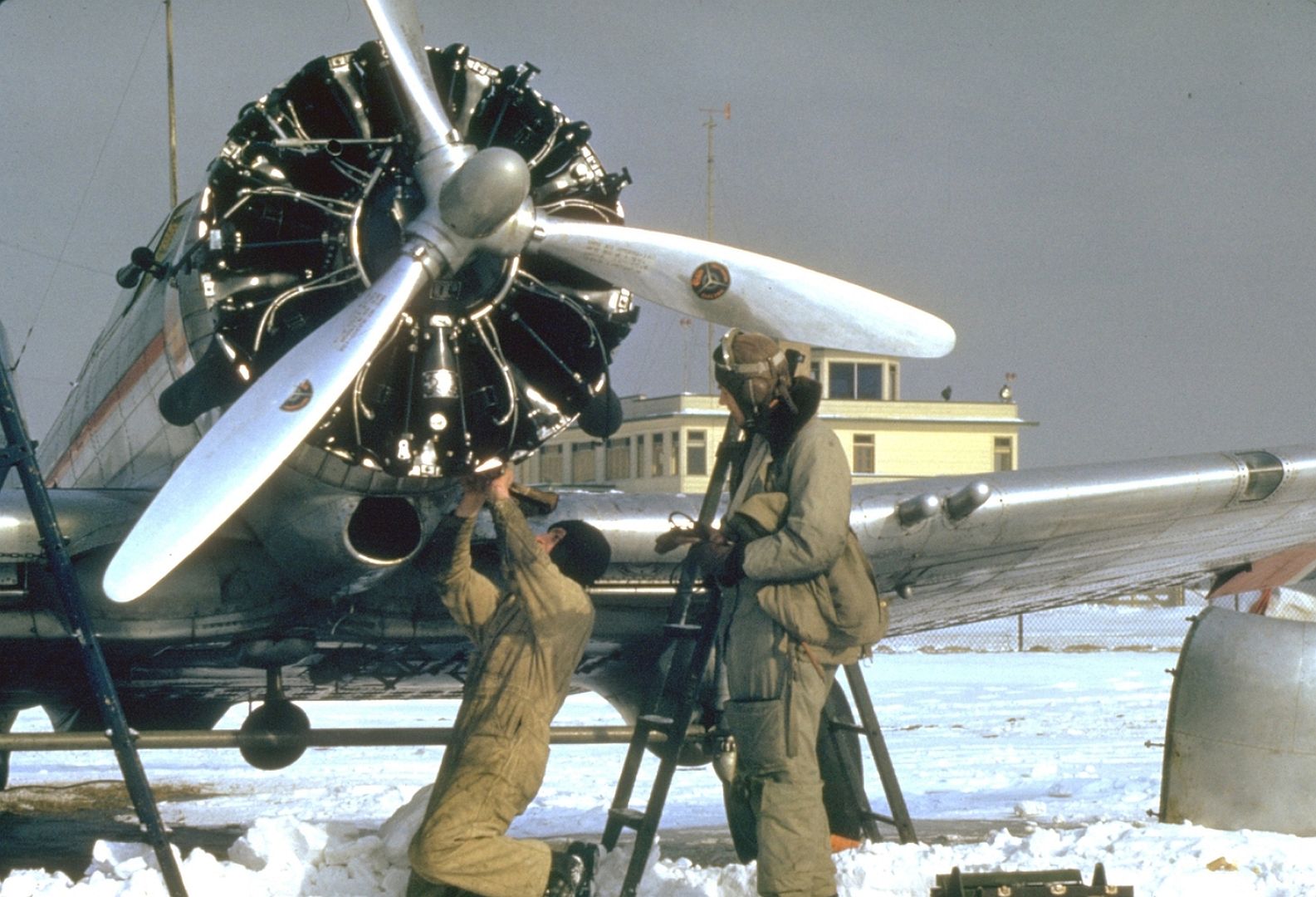
Specification of Douglas DB-8A-5 (A-33)
Engine: One Wright GR-1820-G205A Cyclone air-cooled radial, rated at 1200 hp for takeoff and 1000 hp at 6900 feet. Performance: Maximum speed 248 mph at 15,700 feet. Landing speed 67 mph. An altitude of 10,000 feet could be reached in 5.8 minutes. Service ceiling 29,000 feet, Dimensions: Wingspan 47 feet 9 inches, Length 32 feet 6 inches, Height 9 feet 4 inches, Wing area 363 square feet. Weights: 5510 pounds empty, 8600 pounds loaded, 9200 pounds maximum. Armament: Four wing-mounted 0.30-inch machine guns, plus two underwing-mounted 0.50-inch machine guns, plus two paired flexible 0.30-inch machine guns operated by the rear cockpit gunner. Up to 1800 pounds of bombs could be carried.
Post a reply
- Go to Previous topic
- Go to Next topic
- Go to Welcome
- Go to Introduce Yourself
- Go to General Discussion
- Go to Screenshots, Images and Videos
- Go to Off topic
- Go to Works in Progress
- Go to Skinning Tips / Tutorials
- Go to Skin Requests
- Go to IJAAF Library
- Go to Luftwaffe Library
- Go to RAF Library
- Go to USAAF / USN Library
- Go to Misc Library
- Go to The Ops Room
- Go to Made in Germany
- Go to Campaigns and Missions
- Go to Works in Progress
- Go to Juri's Air-Raid Shelter
- Go to Campaigns and Missions
- Go to Works in Progress
- Go to Skinpacks
- Go to External Projects Discussion
- Go to Books & Resources
